Thank you for visiting nature.com. You are using a browser version with limited support for CSS. To obtain the best experience, we recommend you use a more up to date browser (or turn off compatibility mode in Internet Explorer). In the meantime, to ensure continued support, we are displaying the site without styles and JavaScript.
- View all journals
- Explore content
- About the journal
- Publish with us
- Sign up for alerts
- Open access
- Published: 10 June 2024

A meta-analysis of the effects of design thinking on student learning
- Qing Yu ORCID: orcid.org/0000-0003-1889-1481 1 ,
- Kun Yu 1 &
- Rongri Lin 1
Humanities and Social Sciences Communications volume 11 , Article number: 742 ( 2024 ) Cite this article
393 Accesses
1 Altmetric
Metrics details
- Science, technology and society
Design thinking (DT) is becoming an innovative and popular teaching method. Recently, DT has been used as an unconventional method to develop skills of problem-solving, creativity, and innovation. However, its effects on student learning are unclear . This research aimed to examine the DT’s effects on student learning. The meta-analytic result based on 25 articles showed that DT positively affected student learning ( r = 0.436, p < 0.001). Moreover, the learning outcome, treatment duration, grade level, DT model, and region had moderating effects. Additionally, moderator analysis suggested that DT instruction was more effective: (1) when class size is <=30; (2) on multidiscipline; (3) with long-term duration (>=3 months); (4) for secondary school and university students; (5) on student learning engagement, motivation, problem-solving skills, and academic achievement; (6) with the model of Observe, Synthesize, Ideate, and Prototype, and Empathize, Define, Ideate, Prototype, Test; (7) when team size is <=7; (8) on African and Asian students.
Similar content being viewed by others
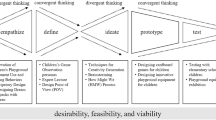
Using design thinking for interdisciplinary curriculum design and teaching: a case study in higher education

The effectiveness of collaborative problem solving in promoting students’ critical thinking: A meta-analysis based on empirical literature
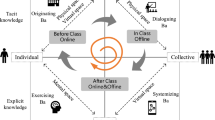
Blended knowledge sharing model in design professional
Introduction.
Design thinking (DT) is attracting more and more attention and interest worldwide (Aris et al., 2022 ). DT was introduced by Rowe ( 1987 ) and was first applied in education in 2005 (Çeviker-Çınar et al., 2017 ). Today, DT has been widely applied in nearly all stages of education (Pande and Bharathi, 2020 ), from formal to informal educational contexts (Aris et al., 2022 ). DT is a process, a method (Rowe, 1987 ), or a “philosophy” (Çeviker-Çınar et al., 2017 ). In education, DT is a teaching method and a learning orientation that enables learners to generate creative ideas and impactful change and actively explore problem solutions (Beckman and Barry, 2007 ; Lor, 2017 ; Retna, 2016 ). DT can help solve many fundamental educational issues (Koh et al., 2015 ). However, previous studies did not reach consensus about DT’s effects on student learning. Moreover, eliciting DT is not always easy because of its complexity and open-endedness (Becker and Mentzer, 2015 ). Therefore, this study carried out a meta-analysis to examine the relationship between DT and student learning.
Conceptual framework
Design thinking.
DT has various definitions. The most widely used definition in education is proposed by Razzouk and Shute ( 2012 ): “an analytic and creative process that engages a person in opportunities to experiment, create and prototype models, gather feedback, and redesign.” DT is a promising, practical method that can be applied to education (Brown, 2008 ; Rusmann and Ejsing-Duun, 2022 ). It is often integrated into the teaching process as an instructional method. DT consists of a set of logically organized stages or processes, each pointing to cultivating students’ key competencies. When students are engaged in DT instruction, they need to follow DT’s steps to move forward with their projects, thereby increasing their ability to perform better. DT also points to addressing problems in real situations (Xu et al., 2024 ), which could increase their interest, motivation, and engagement (Grau and Rockett, 2022 ; Lin et al., 2020a ). In sum, DT has become a dynamic, nonlinear, and spiraling process that can facilitate deep learning (Liu and Li, 2023 ) and eventually result in better student performance (Howard et al., 2021 ).
DT emphasizes learner-centeredness (Glen et al., 2014 ), which can help teachers and students cope with 21st century challenges and complex real-world problems (Gleason and Jaramillo Cherrez, 2021 ; Xu et al., 2024 ; Yande, 2023 ). For teachers , DT provides a framework for solving complex and emerging problems (Henriksen et al., 2020a ); DT also provides good solution strategies and guidance for teachers to design innovative instruction and improve instruction. For students , DT can improve students’ class participation and learning intention, create favorable atmospheres and enjoyment, enhance interaction between each other and creative confidence, deepen their discussion on projects, and eventually improve teachers’ instruction (Balakrishnan, 2022 ; Tu et al., 2018 ). Moreover, DT can also nurture the competencies necessary for students, such as communication, collaboration, teamwork, problem-solving skills, creativity, empathy, critical thinking, and metacognition (Abolhasani et al., 2021 ; Balakrishnan, 2022 ; Guaman-Quintanilla et al., 2023 ; Retna, 2016 ; Rusmann and Ejsing-Duun, 2022 ). In general, the value of DT in education is to help students grow, empower teachers’ development, and promote teaching change.
DT has gradually become the new normal, with students readily embracing the DT process and appreciating its merits (Retna, 2016 ). Meanwhile, a variety of DT models are proposed for use in different domains. Simon ( 1969 ) proposed the first DT model, which entails a one-way linear process of three steps: analysis, synthesis, and evaluation. The most widely applied model in education is that of the Stanford model (Liu et al., 2024a ), which has five stages: empathize, define, ideate, prototype, and test (EDIPT) (Plattner, 2009 ), especially in school and university educational settings. IDEO ( 2013 ) defined five stages of DT for educators: discovery, interpretation, ideation, experimentation, and evolution. To apply DT in K-12 (Liu and Li, 2023 ), Carroll et al. ( 2010 ) extend the EDIPT model to six stages, e.g., understand, observe, point of view, ideate, prototype, and test. Brown’s DT model has been widely used, with three stages: inspiration, ideation, and implementation (Brown, 2008 ). The Design Council’s DT model assists designers or non-designers in solving some of the most complex social, economic, and environmental problems. It has four stages: discover, define, develop, and implement (Design Council, 2015 ). The DT model selected should aim to meet both students’ needs and instructional goals (Brannon, 2022 ). It should be noted that the processes contained in different DT models may vary and therefore produce different results.
DT’s effects and research gaps
Recently, there have been gradually increasing explorations to investigate the impacts of DT on students’ learning performance in education. However, there is no consensus on the effectiveness of DT. The results can be classified into three types: (a) DT can promote students’ learning significantly (Albay and Eisma, 2021 ; Bawaneh and Alnamshan, 2023 ; Chang and Tsai, 2021 ; Dawbin et al., 2021 ; Hsiao et al., 2017 ; Kuo et al., 2022 ; Ladachart et al., 2022 ; Lin et al., 2020a ; Liu and Ko, 2021 ; Nazim and Mohammad, 2022 ; Padagas, 2021 ; Pratomo and Wardani, 2021 ; Simeon et al., 2022 ; Tsai, 2015 ; Ziadat and Sakarneh, 2021 ); (b) DT does not significantly enhance student learning (Khongprakob and Petsangsri, 2022 ; Kuo et al., 2022 ; Lin et al., 2020b ; Yalçın and Erden, 2021 ); (c) there are negative correlations between DT and learning outcomes (Chou and Shih, 2022 ; Lake et al., 2021 ).
It can be seen that DT’s effectiveness is still questionable . DT is an emerging topic that needs in-depth investigation (Baker III and Moukhliss, 2020 ). Some research gaps need to be addressed urgently. First , it lacks specific guidance and references on DT instruction. In-service teachers are unfamiliar with DT (Bressler and Annetta, 2022 ; Liu et al., 2024a ), which may reduce DT’s effects. Students may also undergo confusion and frustration when participating in DT courses (Glen et al., 2015 ; Razali et al., 2022 ). Therefore, it is crucial to explore where the DT approach may be more appropriate for the classroom setting (Lor, 2017 ). For instance, what is the most effective class size, team size, duration, or DT model? Second , DT’s effects are questioned (Rao et al., 2022 ). Namely, a systematic assessment of DT’s effectiveness is limited (Liedtka, 2015 ). There is no meta-analysis to deliver robust evidence on the effectiveness of DT in education. To summarize, with DT’s widespread introduction into education, performing a meta-analysis to reveal DT’s overall effects on student performance and possible influencing moderators is necessary and valuable.
Research purpose
Considering that there is no quantitative, comprehensive evidence on DT’s effects in education, we tried to solve the following questions:
RQ1 . What are the research characteristics of the included empirical studies of DT on student learning (e.g., publication year, research design, class size, grade level, duration, subject, team size, DT model, and region/countries)?
RQ2 . What is the overall effect of DT on student learning?
RQ3 . What are the DT’s effects on student learning under the potential moderators (e.g., learning outcome, class size, grade level, duration, subject, team size, DT model, and region)?
Compared to a mere literature review, meta-analysis can provide precise quantitative effects (Grant and Booth, 2009 ). Meta-analysis can integrate various empirical research results to calculate the overall effect value (Lipsey and Wilson, 2001 ). This research was conducted based on the process proposed by Field and Gillett ( 2010 ).
Literature searching
We mainly retrieved the documents from the Web of Science (Core Collection), Scopus, and Google Scholar. Some topic words, i.e., (“Design Thinking”) AND (“Learning Performance” OR “Learning Outcomes” OR “Academic Achievement” OR “Academic Performance”), were combined to search for the target documents. The search span was confined from January 2005 to June 2023. 1204 articles were retrieved preliminarily through the search, and 1059 articles were obtained after removing duplicated literature.
Selecting criteria and process
We selected literature based on the below criteria:
(1) It must report the relationship between DT and student learning performance;
(2) It must be empirical studies (experimental, quasi-experimental, or correlational research);
(3) The research participants should receive intervention through DT teaching;
(4) It should provide necessary data for calculating effect sizes in targeted papers (e.g., sample size, mean, standard deviation, the value of t or p );
(5) It should be peer-reviewed and published in English .
After the initial of screening of titles and abstracts and the removal of duplicates, 296 articles were selected. Whole-text articles were initially assessed for eligibility, and 84 articles that met the inclusion criteria remained. Finally, after the articles were read in full, 25 peer-reviewed studies were obtained. The literature searching and selection were conducted strictly according to the standard processes (Moher et al., 2009 ) (Fig. 1 ).
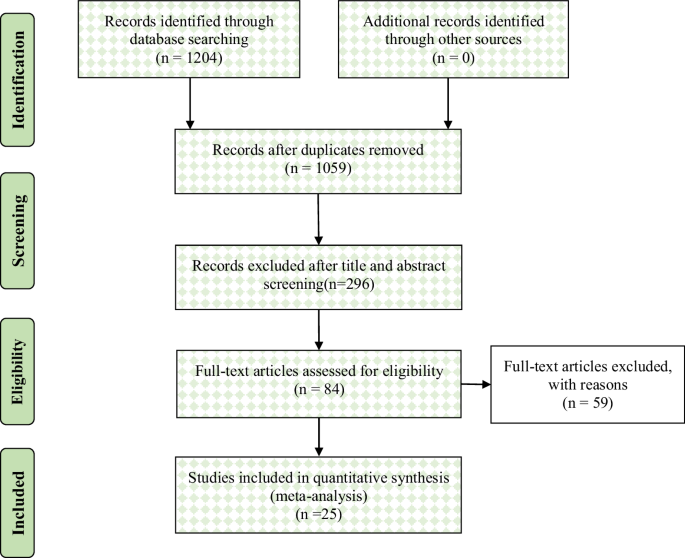
Flow diagram.
Literature Quality and Bias Assessment
One database cannot include all the published literature, so searching multiple authoritative databases can control the literature search bias (Stang, 2010 ). Higgins et al. ( 2019 ) recommend searching at least two databases. So, we selected three databases to reduce the search literature search bias (Kelley and Kelley, 2019 ).
The included criteria’s inaccuracy will result in literature selection bias (Sterne et al., 2016 ). We strictly drew up the selection criteria to reduce this bias, e.g., study purpose and design, intervention of DT, and published language (Liu et al., 2024b ).
We assessed the literature quality based on the criteria of Downs and Black ( 1998 ), which have 27 questions and five categories. We found that all selected studies got majority points in more than four of the above categories (range 18 to 21), so they were high-quality (Carter et al., 2017 ).
Coding potential moderators
Moderators are possible factors that influence DT’s effects. The eight moderators were divided into the background and method.
Background moderators
Learning outcome: DT’s learning outcomes are less examined. Examining DT’s effectiveness on different learning outcomes is necessary (Razzouk and Shute, 2012 ). It was coded into academic achievement, self-efficacy, learning motivation, problem-solving ability, creative thinking, and learning engagement.
Treatment duration: The DT process could take a long time to explore (Carroll et al., 2010 ), and it may moderate DT’s effect on learning. It was divided into <1, 1–3, and >3 months.
Class size: It is an important index of teaching effects (Retna, 2016 ). So, it may moderate DT’s effect on student learning. It was divided into 1–30, 31–50, 51–100, and >100.
Grade level: There should be a clear distinction regarding how DT is applied to different learning stages (Lor, 2017 ). It was divided into kindergarten, primary, junior high, high school, and university.
Subject: DT was not always useful across all subjects (Retna, 2016 ), and van de Grift and Kroeze ( 2016 ) found that it could enhance interdisciplinary education. Namely, the subject may moderate DT’s effects. It was divided into STEM, No-STEM, and multidiscipline.
Region: It refers to the area where the study was performed. The education system’s cultural context must also be considered when applying DT (Retna, 2016 ). So, the region is also considered a potential moderator. It was divided into Asia, America, Austria, Europe, and Africa.
Method moderators
DT model: It refers to DT’s specific processes or stages. The implementation of DT relies on specific models, and different models contain different operations. Therefore, the role of DT models should be considered. We coded the DT model into 9 types:
3IE =Inspiration, Ideation, Implementation, and Evaluation;
UOPIPT =Understand, Observe, Perspective, Imagination, Prototype, and Test;
EDIPT =Empathize, Define, Ideate, Prototype, and Test;
EDEIPT =Empathize, Define, Elaborate, Ideate, Prototype, and Test;
OSIP =Observation, Synthesis, Ideation, and Prototype;
PAS =Preparation, Assimilation, Strategic control;
2UPPI =User focus (User as an information source and User as a codeveloper), Problem framing, Prototype, and Iteration;
CTC =Copy, Tinker, and Create;
LAUNCH =Look, listen and learn, Ask, Understand, Navigate ideas, Create, and Highlight and fix.
Team size: This variable refers to the number of team members. DT pedagogy emphasizes the use of student teams (Beckman and Barry, 2007 ), and team size is one of the causes of conflicts around teamwork (Aflatoony et al., 2018 ). So, the team size may moderate DT’s effect. It was divided into 1–4, 5–7, and >=8.
Data analysis
CMA 3.0 was used to analyze the effect sizes and moderators’ effects. In order to overcome the differences in different studies, the Pearson correlation coefficient r was selected as the effect size (Borenstein et al., 2005 ). Since the paper sample sizes varied widely, the authors employed the Fisher Z -transformation based on the weighted study sample sizes to calculate the ultimate r and 95% confidence intervals (Lei et al., 2020 ).
Publication Bias
We used the funnel plot, classic fail-safe N , and trim-and-fill method to examine the publication bias. If there is no publication bias in the data, the scatter of the funnel would be spread symmetrically. First , the funnel plot showed that the samples in this study were not evenly distributed (Fig. 2 ). Second , fail-safe Nfs quantifies the threshold at which publication bias becomes an issue. CMA can calculate the threshold ( Nfs ). Next, the fail-safe Nfs indicated that Nfs = 9179 was far larger than 220 (5* K + 10, K = 42). Last , the trim-and-fill method can create plots of potentially missing studies to search for symmetry between the literature (Duval and Tweedie, 2000 ). This method found just five missing values on the right of the funnel plot (Fig. 3 ). In sum, it can be concluded that the data included were free from publication bias.
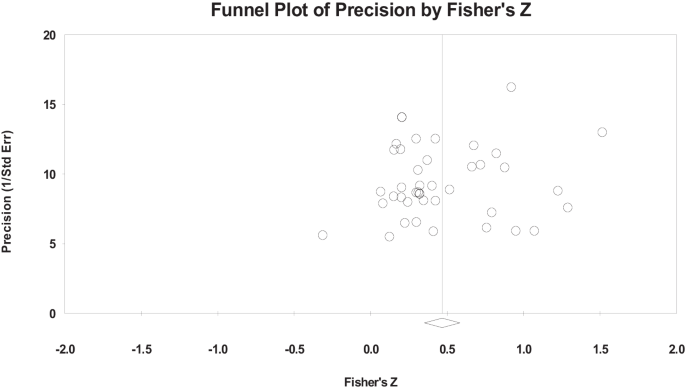
Funnel plot.
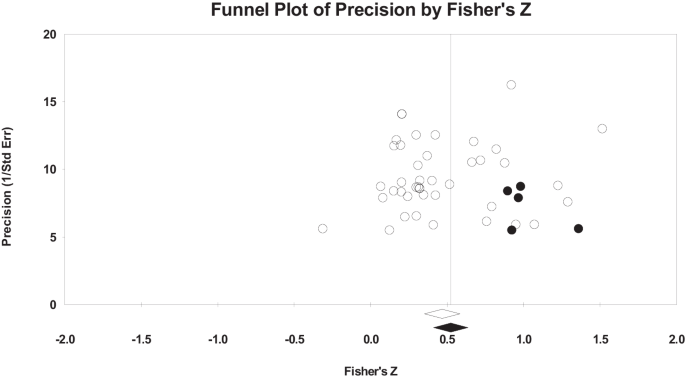
Funnel plot after trill-and-fill.
Actually, literature selection may cause publication bias. To minimize this bias, we strictly developed the selection criteria, e.g., study purpose and design, intervention of DT, necessary data, and peer-review. Especially, we limited the language of publication to English. This may exclude some potential literature published in other languages; it is one limitation of the current research and could be addressed in the future.
Homogeneity test and sensitivity analysis
The values of Q and I 2 can be used to determine whether heterogeneity exists. The result was Q = 554.908 ( p < 0.001) (Table 1 ), which was significant. Moreover, I 2 = 92.611% > 75%, according to Higgins et al. ( 2003 ), meant the heterogeneity was high. Thus, the random-effects model should be selected (Borenstein et al., 2009 ; Wilson et al., 2020 ). Moreover, moderating analyses were also necessary to be analyzed.
To confirm the robustness of this research, we used the one-study-removal method to examine the sensitivity. The result suggested that each overall effect size fell within a reasonable range (from 0.418 to 0.467). Thus, this study is robust.
General characteristics of the included 25 studies
To answer RQ1, reveal the current state of empirical research on DT, and provide complementary evidence for subsequent meta-analyses, a descriptive analysis of the included literature was conducted. The literature included was published between 2015 and 2023, e.g., 1 in 2015 (4.00%), 1 in 2017 (4.00%), 3 in 2020 (12.00%), 8 in 2021 (32.00%), 6 in 2022 (24.00%), and 6 in 2023 (24.00%). The result indicated a growing interest in empirical research on the use of DT for teaching and learning in education. In terms of study design, only 2 were correlational studies (Lin et al., 2020a ; Roth et al., 2020 ), while the other 23 were experimental studies (including pre-experiment, quasi-experiment, and true-experiment). Descriptive results are as follows:
(1) Grade level: kindergarten ( N = 1, 4.00%), primary school ( N = 3, 12.00%), junior high school ( N = 2, 8.00%), high school ( N = 9, 36.00%), and university ( N = 10, 40.00%).
(2) Class size: 0–30 ( N = 9, 36.00%), 31–50 ( N = 10, 40.00%), and >=51( N = 6, 24.00%).
(3) Duration: 0–1 month ( N = 8, 32.00%), 1–3 months ( N = 7, 28.00%), and =>3 months ( N = 10, 40.00%).
(4) Subject: STEM ( N = 16, 64.00%), No-STEM ( N = 6, 24.00%), and multidiscipline ( N = 3, 12.00%).
(5) DT model: EDIPT ( N = 14, 56.00%), 3IE ( N = 1, 4.00%), UOPIPT ( N = 1, 4.00%), LAUNCH ( N = 1, 4.00%), OSIP ( N = 1, 4.00%), PAS ( N = 1, 4.00%), PPI2U ( N = 1, 4.00%), EDEIPT ( N = 1, 4.00%), CTC ( N = 1, 4.00%), and Unknown ( N = 3, 12.00%) (Fig. 4 ).
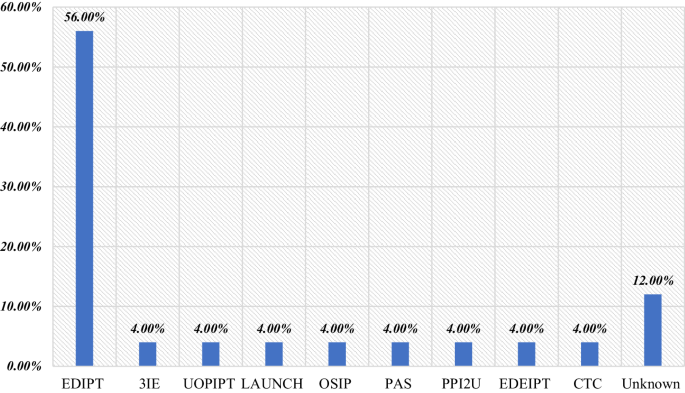
(7) Team size : 0–4 ( N = 7, 53.85%) and 5–7 ( N = 6, 46.15%).
(8) Region : Asia ( N = 21, 84.00%), America ( N = 1, 4.00%), Australia ( N = 1, 4.00%), Europe ( N = 1, 4.00%), and Africa ( N = 1, 4.00%) (Fig. 5 ).
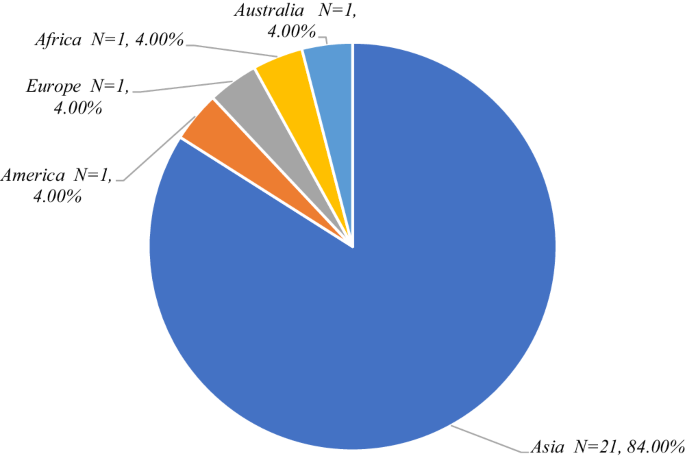
(9) Countries : China ( N = 12, 48.00%), Thailand ( N = 2, 8.00%), Australia ( N = 1, 4.00%), Austria ( N = 1, 4.00%), Philippines ( N = 2, 8.00%), Saudi Arabia ( N = 2, 8.00%), Nigeria ( N = 1, 4.00%), America ( N = 1, 4.00%), Indonesia ( N = 1, 4.00%), Jordan ( N = 1, 4.00%), and Turkey ( N = 1, 4.00%).
In general, the results revealed that most research used EDIPT ( N = 14) as a DT model and focused primarily on the learning of STEM subjects ( N = 16, 64.00%) by high school ( N = 9, 36.00%) and university students ( N = 10, 40.00%) in Asia ( N = 21, 84.00%).
Overall effect size
When r = 0.1, there is a small effect size; r = 0.3 is a medium effect size; and r = 0.5 is a large effect size (Cohen, 2013 ). The overall effect size of DT was upper-medium ( r = 0.436, 95% CI [0.342, 0.525], p < 0.001) (Table 1 ). Moreover, each study’s effect sizes were also provided (Fig. 6 ). The red diamond represents the overall effect size and its CI in the forest plot. Favours A meant the result was in favor of regular instruction, while Favours B meant the result was in support of DT instruction.
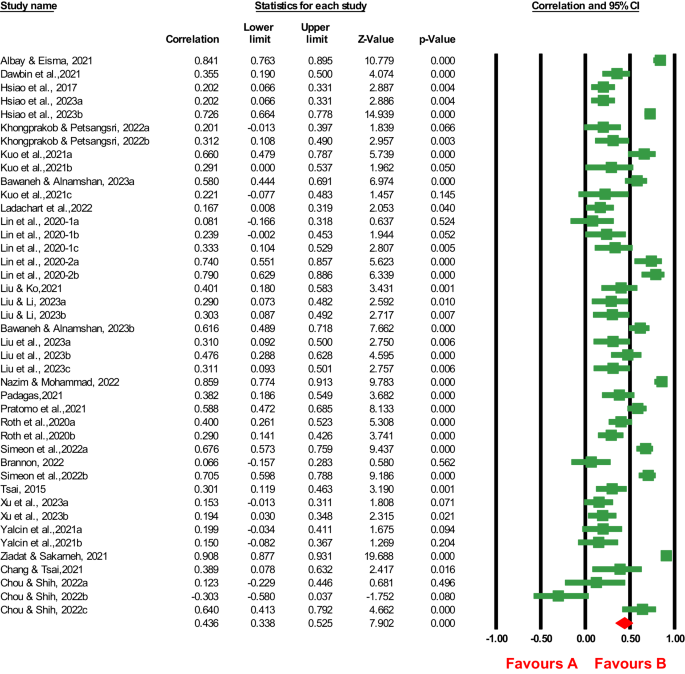
Forest plot.
Moderator analysis
Learning outcome.
The order of effect sizes from large to small was learning engagement ( r = 0.740), learning motivation ( r = 0.608), academic achievement ( r = 0.450), problem-solving ability ( r = 0.447), creative thinking ( r = 0.329), and self-efficacy ( r = 0.230) (Table 2 ). The between-groups effect ( p < 0.01) indicated that the learning outcome had a moderating effect.
The order of effect sizes from large to small was <=30 ( r = 0.609), 31–50 ( r = 0.422), and >=51 ( r = 0.389) (Table 2 ). The result of between-group effects was Q = 0.856 ( p > 0.05), indicating that the class size had no moderating effect.
Treatment duration
The result showed that the effect size of >=3 months ( r = 0.535) was the largest, the next was <=1 month ( r = 0.456), and 1–3 months ( r = 0.245) was the smallest (Table 2 ). The between-groups effect ( p < 0.001) indicated that the treatment had a moderating effect.
Grade level
The order of effect sizes from large to small was high school ( r = 0.538), university ( r = 0.463), junior high school ( r = 0.443, p > 0.05), primary school ( r = 0.222), and kindergarten ( r = 0.174) (Table 2 ). The between-groups effect ( p < 0.01) indicated that the grade level had a moderating effect.
The order of effect sizes from large to small was multidiscipline ( r = 0.604), No-STEM ( r = 0.470), and STEM ( r = 0.393) (Table 3 ). The between-groups effect indicated that the subject had no moderating effect.
The order of effect sizes from large to small was OSIP ( r = 0.766), EDIPT ( r = 0.522), 2UPPI ( r = 0.346), PAS ( r = 0.301), UOPIPT ( r = 0.297), 3IE ( r = 0.222), CTC ( r = 0.191, p > 0.05), EDEIPT ( r = 0.174), and LAUNCH ( r = 0.066, p > 0.05) (Table 3 ). The Q test of the between-groups effect was significant ( p < 0.001), indicating that the DT model had a moderating effect.
The order of effect sizes from large to small was 0–4 ( r = 0.477) and 5–7 ( r = 0.441) (Table 3 ). The between-groups effect ( p > 0.05) indicated that the team size had no moderating effect.
The order of effect sizes from large to small was Africa ( r = 0.690), Asia ( r = 0.435), Australia ( r = 0.355), Europe ( r = 0.346), and America ( r = 0.066, p > 0.05) (Table 3 ). The between-groups effect ( Q = 50.576, p < 0.001) indicated that the region had a moderating effect.
Discussions and implications
This meta-analysis investigates DT’s effect on student learning with 42 validated effect sizes from 25 independent empirical articles. This research reveals that DT has an upper-medium effect on student learning. DT is the gaping link between the theoretical discoveries of social transformation pedagogy and the practical application of the skills needed for the future (Scheer et al., 2012 ). The DT process entails a set of logical stages that point to students’ key competencies. DT instruction can increase students’ involvement, establish a positive learning climate, and promote interaction and communication between teachers and students (Tu et al., 2018 ). Moreover, DT relies on teamwork and hands-on activities, which are beneficial for student learning (Holstermann et al., 2010 ; Oje, 2021 ; Sung et al., 2017 ; Swanson et al., 2019 ). Certainly, connecting DT with courses’ content may be a challenge (Hennessey and Mueller, 2020 ). Overall, if educators organize DT instruction appropriately, it will be effective in improving student learning.
It has a moderating effect. Specifically, DT can promote learners’ creative thinking, learning engagement, motivation, problem-solving ability, self-efficacy, and academic achievement. Notably, the effects of learning motivation, engagement, and academic achievement are large. The DT process entails a set of logical stages that point to students’ key competencies. DT is a dynamic, nonlinear, and spiraling process that can facilitate deep learning (Liu and Li, 2023 ), interest, motivation, creativity, and engagement, and eventually improve student learning (Howard et al., 2021 ; Rao et al., 2022 ). However, there are significant differences in the impacts of DT on student learning outcomes. DT models consist of a set of stages, and some models are complex and challenging. So, its effect on self-efficacy is smaller than other types of learning outcomes. In sum, DT still has great potential to enhance various learning outcomes.
It has no moderating effect. Specifically, <= 30 ( r = 0.609) has a large effect, >= 51 ( r = 0.389) and 31–50 ( r = 0.422) have upper-medium effects. The result suggests that the smaller the class size, the better DT’s effects. DT is a guided, student-oriented process where learners need close supervision, guidance, and feedback (Retna, 2016 ). When the class size is large (>= 51), it is hard for teachers to provide prompt guidance and feedback. Moreover, large class sizes challenge teachers’ effective classroom management and interactions (Blatchford et al., 2009 ). Of course, >= 51 is broad. So, DT’s effects on larger class sizes (e.g., 51–80, etc.) need more exploration. Based on the result, we recommend that educators keep the class size below 51 students. Moreover, if conditions permit, more teachers could be involved in one class (e.g., two teachers) (Retna, 2016 ).
It has a moderating effect. Specifically, the effect of >= 3 months ( r = 0.535) is large, <= 1 month ( r = 0.456) has an upper-medium effect, and 1–3 months ( r = 0.245) has an upper-small effect. Generally, the effect of 1–3 months is best (Yu et al., 2023 ), but our result is the smallest. The novelty effect may result in a larger effect at <=1 month than at 1–3 months. The decrease in the 1–3 months’ effect may be due to the novelty effect wearing off as students slowly familiarize themselves with DT and face learning challenges. Guaman-Quintanilla et al. ( 2023 ) noted that it is challenging to experience the entire process of DT within a limited time. Namely, time constraints are a challenge for students and educators (McLaughlin et al., 2023 ; Retna, 2016 ; Razali et al., 2022 ). Longer durations are needed for educators to conduct DT instruction to make students engage in DT (Razali et al., 2022 ). Actually, DT is a long-term journey to develop students’ abilities and skills, so enough time should be allocated. In short, though DT is effective for these durations, <=1 month or >= 3 months are more effective. More future research could examine the 1–3 months’ effect on DT.
It has a moderating effect. Specifically, high school ( r = 0.538) has the best effect; university ( r = 0.463) has an upper-medium effect; primary school ( r = 0.222) and kindergarten ( r = 0.174) have small effects; and junior high school ( r = 0.443, p > 0.05) has an insignificant effect. DT has been used in all stages of education, and DT is also effective. In this research, DT shows greater potential for high school and university students than for primary school and kindergarten students. DT is a task- and activity-oriented learning process that relies on team communication and collaboration, DT studies at different stages might yield different results due to cognitive-developmental differences (Mentzer et al., 2015 ). Given the complexity of DT, more DT instruction could be applied to university and secondary school students. Moreover, for researchers, more studies should be carried out at diverse grade levels, especially in kindergarten ( k = 2) and junior high school ( k = 4).
It has no moderating effect, but the effect of multidiscipline is better than that of STEM and No-STEM. This suggests that DT can foster multidisciplinary learning, consistent with previous studies (Chang and Tsai, 2021 ; de Figueiredo, 2021 ; van de Grift and Kroeze, 2016 ). DT has typical interdisciplinary features (Lugmayr et al., 2014 ) and can promote new solutions, innovation, and collaboration opportunities for complex problems in multidisciplinary areas (Cook and Bush, 2018 ; Gleason and Jaramillo Cherrez, 2021 ). At the same time, DT can be integrated into the subjects of STEM or No-STEM to promote learning and teaching (Hsiao et al., 2023 ). DT is taught as a concept rather than affiliated with a specific discipline (Lor, 2017 ). We recommend integrating DT into existing courses rather than adding additional add-on activities (Sandars and Goh, 2020 ), especially for multidisciplinary learning (Hsiao et al., 2023 ). Different disciplines or subjects have their own suitable design processes (Sung and Kelley, 2019 ), the result provides a broad subject division for reference. Future research could explore DT’s effects on more detailed subjects. Besides, most of DT was applied to STEM subjects ( k = 32), fewer to No-STEM and multidiscipline. So, DT’s effects on both latter subjects should be viewed cautiously and pay more research attention.
It has a moderating effect, indicating that different DT models could generate heterogeneity. Specially, OSIP ( r = 0.766) and EDIPT ( r = 0.522) have large effects; PPI2U ( r = 0.346) and PAS ( r = 0.301) have lower-medium effects; UOPIPT ( r = 0.297), 3IE ( r = 0.222), EDEIPT ( r = 0.174) have small effects; and CTC ( r = 0.191, p > 0.05) and LAUNCH ( r = 0.066, p > 0.05) have no significant effects. Before DT can be effectively implemented to solve complicated problems, it is essential to have a solid grasp and comprehension of the different stages of the DT process (Dam and Teo, 2019 ). Different DT models involve different steps or stages, which may affect the processes of cognition and learning. For instance, EDIPT is easier for middle school students (Sarooghi et al.m 2019 ). Based on the result of this meta-analysis, we recommend that educators adopt the models of EDIPT and OSIP in DT instruction. Importantly, educators should not rely too heavily on the pre-determined procedural DT processes, which may hinder the creative potential of DT (Wells, 2013 ). Educators can rationalize the DT model based on their actual situations (Li and Zhan, 2022 ). It is also necessary to mention that, with the exception of EDIPT, the numbers of effect sizes included in other DT models are small, so their results should be treated cautiously and more explorations are needed.
It has no moderating effect. Team sizes of 0–4 ( r = 0.477) and 5–7 ( r = 0.441) have upper-medium effects. Teamwork and team collaboration are great challenges for many students. DT could enhance students’ teamwork (Guaman-Quintanilla et al., 2022 ). Success in DT requires teamwork, and larger teams can enrich the diversity of perspectives and increase the likelihood of solutions (Sung et al., 2017 ). Moreover, the composition of teams is also important (Apedoe et al., 2012 ). Generally speaking, heterogeneous ability groups may be appropriate in DT (Lou et al., 1996 ), i.e., both low-ability and high-ability students, and both male and female students (Yu and Yu, 2023 ). From the result of this research, 2–7 members in one group are beneficial. A larger number of teams may limit the teachers’ ability to guide and facilitate each team’s, and individual students’ learning (Apedoe et al., 2012 ). We recommend having <=7 members in one group. Specifically, when the class size is large, 5–7 is better; otherwise, 2–4 will be better. However, the result shows a broad team size for reference only. So, future research could explore which specific composition of teams (from 2 to 7 or above) in DT instruction is better.
It has a moderating effect. Specifically, Africa ( r = 0.690) has a large effect, Asia ( r = 0.435), and Australia ( r = 0.355), and Europe ( r = 0.346) have upper-medium effects, while America has an insignificant effect. This may be due to differences in cultural and educational systems in different regions. Different from individualistic cultures (e.g., America, Australia, Austria), most Asian countries are collectivist (e.g., China, Thailand, Indonesia, etc.), and students in these countries tend to value team goals more than individual goals (De Mooij and Hofstede, 2010 ). So, DT has an upper-medium effect on Asian students. Since the study distribution between different regions was highly uneven, this result should be treated judiciously. For instance, except for Asia, other regions’ studies are small, e.g., Australia ( N = 1), Europe ( N = 1), Africa ( N = 1), and America ( N = 1), so these regions need more attention. In general, DT positively impacts student learning in diverse regions, and DT is recommended to enhance Asian students’ learning.
Implications for future practice and work
This meta-analysis makes an evidence-based analysis of DT’s effects on student learning, and we provide some meaningful suggestions for future practice and research. These are also major contributions to the existing literature.
First , though DT’s effects on different types of learning outcomes are significantly different, it is still an effective teaching method to improve student learning. Educators can apply DT to enhance student academic performance, creative thinking, learning engagement, motivation, and problem-solving ability. Due to the limited amount of learning engagement and self-efficacy, their effects should be treated cautiously.
Second , a smaller size means a larger DT’s effect. Educators should keep the class size <51. Future research could focus more on exploring DT’s effects on larger class sizes (e.g., 51–80, etc.).
Third , treatment duration is a critical factor. <= 1 month or >=3 months are more suggested. Particularly, DT’s effect is smallest when the duration is 1–3 months, and this needs more future research.
Fourth , grade level is a key factor. DT could be applied to university and high school students. DT’s effect on junior high school is insignificant . Researchers could carry out more studies at kindergarten ( k = 2) and junior high school ( k = 4).
Fifth , DT can be used in the subjects of STEM, No-STEM, or multidiscipline. Meanwhile,future research could explore more on No-STEM, multidiscipline, and more detailed subjects.
Sixth , the DT model is also a critical factor that should be considered. Based on the results of this study, we recommend that educators adopt the models of EDIPT. Importantly, except for EDIPT, other models’ effects need more exploration.
Seventh , in terms of team size, it is suggested to have <= 7 members in one group. Specifically, when the class size is large, 5–7 is better; otherwise, 2–4 will be preferred. However, the result shows a wide range. Future research could explore which specific composition of teams (from 2 to 7 or above) is better for DT instruction.
Eighth , regional analysis suggests that DT is most used in Asia and is most suggested to support Asian student learning. However, the number of effect sizes in other regions is very small. Thus, their results should be viewed with caution, and future researchers can take more steps to test DT’s effects in America, Africa, Australia, and Europe.
Conclusions, limitations and future research
Conclusions.
This meta-analytic evidence reveals DT’s effects in education based on 25 empirical studies. We find that DT has an upper-medium positive effect on students’ learning. Specifically, DT can lead to higher learners’ creative thinking, learning engagement, motivation, problem-solving ability, self-efficacy, and academic achievement. In comparison, DT has better effects on student learning motivation, engagement, and academic achievement. Furthermore, the learning outcome, grade level, treatment duration, DT model, and region moderate DT’s effects on student learning. Namely, these moderators will affect DT’s effectiveness.
DT is on-trend worldwide (Aris et al., 2022 ), and it has profoundly changed many educators’ thinking about how to instruct to support learning (Hubbard and Datnow, 2020 ). Teachers are vital in DT instruction; they should be facilitators and navigators, not lecturers (Henriksen et al., 2020b ; Retna, 2016 ; Rusmann and Ejsing-Duun, 2022 ). In sum, DT can potentially promote learning at different grade levels, but the effectiveness of DT in education depends upon the goals (Panke, 2019 ). It is critical to make teachers see the value of DT in classrooms (Carroll et al. 2010 ) and conduct DT instruction with guidance and rules. This paper provides evidence-based findings for educators and researchers.
Limitations, research gaps, and future directions
There are several limitations that should be solved for future work. First , the literature is distributed unevenly by region, grade level, and DT model, so more future studies could be taken at kindergarten ( k = 2), junior high school ( k = 4), America ( k = 1), Australia ( k = 1), Africa ( k = 2), Europe ( k = 2), learning engagement ( k = 1), self-efficacy ( k = 3), and DT model except EDIPT. Second , the literature included in this meta-analysis was published in English . Future work could include other language studies. Third , the heterogeneity is considerable, and some potential moderators may be overlooked. Future work could explore more factors that influence DT’s effectiveness, e.g., learning environments. Fourth , the included literature is not large; future research could focus on experimental design to explore DT’s effects on student learning. Last , a meta-analysis may not display the whole status and findings of DT in education. Future researchers could conduct a systematic literature review to compensate for the neglected aspects of the current research.
Data availability
All data is provided in the forest plot and references. The details are provided at https://doi.org/10.7910/DVN/EHGCGS .
References (*included in this meta-analysis)
Abolhasani Z, Dehghani M, Javadipour M, Salehi K, Mohammadhasani N (2021) An analysis of the role of design thinking in promoting the 21st-century skills: a systematic review. Technol Educ J 16(1):81–98. https://doi.org/10.22061/tej.2021.7206.2508
Aflatoony L, Wakkary R, Neustaedter C (2018) Becoming a design thinker: assessing the learning process of students in a secondary level design thinking course. Int J Art Design Educ 37(3):438–453. https://doi.org/10.1111/jade.12139
*Albay EM, Eisma DV (2021) Performance task assessment supported by the design thinking process: Results from a true experimental research. Soc Sci Human Open 3(1):100116. https://doi.org/10.1016/j.ssaho.2021.100116
Apedoe XS, Ellefson MR, Schunn CD (2012) Learning together while designing: does group size make a difference? J Sci Edu Technol 21(1):83–94. https://doi.org/10.1007/s10956-011-9284-5
Aris NM, Ibrahim NH, Abd Halim ND, Ali S, Rusli NH, Suratin MNM, Hassan FC (2022) Evaluating the academic trends on design thinking research: A bibliometric analysis from 2000 to 2021. J Positive School Psychol 6(4):1022–1038
Google Scholar
Baker III FW, Moukhliss S (2020) Concretising design thinking: a content analysis of systematic and extended literature reviews on design thinking and human‐centred design. Rev Educ 8(1):305–333. https://doi.org/10.1002/rev3.3186
Balakrishnan B (2022) Exploring the impact of design thinking tool among design undergraduates: a study on creative skills and motivation to think creatively. Int J Technol Design Educ 32(3):1799–1812. https://doi.org/10.1007/s10798-021-09652-y
*Bawaneh AK, Alnamshan MM (2023) Design Thinking in Science Education: Enhancing Undergraduate Students’ Motivation and Achievement in Learning Biology. Int J Inf Educ Technol 13(4):621–633. https://doi.org/10.18178/ijiet.2023.13.4.1846
Beckman SL, Barry M (2007) Innovation as a learning process: embedding design thinking. California Manag Rev 50(1):25–56. https://doi.org/10.2307/41166415
Becker K, Mentzer N (2015) Engineering design thinking: high school students’ performance and knowledge. In 2015 International Conference on Interactive Collaborative Learning, IEEE, (pp 5–12), Firenze, Italy
Blatchford P, Russell A, Brown P (2009) Teaching in large and small classes. In: LJ Saha, & AG Dworkin (eds.), International Handbook of Research on Teachers and Teaching. Springer, Boston, MA
Borenstein M, Hedges L, Higgins J, Rothstein H (2005) Comprehensive meta-analysis (version 3.3) (p. 104). Englewood, NJ: Biostat
Borenstein M, Hedges LV, Higgins JP, Rothstein HR (2009) Introduction to meta-analysis. John Wiley & Sons
Brown T (2008) Design thinking. Harvard Business Review 86(6):84–92
PubMed Google Scholar
*Brannon ME (2022) Exploring the impact of design thinking on creativity in preservice teachers. Doctoral dissertation, Kent State University
Bressler DM, Annetta LA (2022) Using game design to increase teachers’ familiarity with design thinking. Int J Technol Design Educ 32(2):1023–1035. https://doi.org/10.1007/s10798-020-09628-4
Carroll M, Goldman S, Britos L, Koh J, Royalty A, Hornstein M (2010) Destination, imagination and the fires within: design thinking in a middle school classroom. Int J Art Design Educ 29(1):37–53. https://doi.org/10.1111/j.1476-8070.2010.01632.x
Carter G, Milner A, McGill K, Pirkis J, Kapur N, Spittal MJ (2017) Predicting suicidal behaviours using clinical instruments: systematic review and meta-analysis of positive predictive values for risk scales. Br J Psychiatry 210(6):387–395. https://doi.org/10.1192/bjp.bp.116.182717
Article PubMed Google Scholar
Çeviker-Çınar G, Mura G, Demirbağ-Kaplan M (2017) Design thinking: a new road map in business education. Design J 20(S1):977–987. https://doi.org/10.1080/14606925.2017.1353042
Article Google Scholar
*Chang YS, Tsai MC (2021) Effects of design thinking on artificial intelligence learning and creativity. Educ Stud 1–18. https://doi.org/10.1080/03055698.2021.1999213
*Chou PN, Shih RC (2022) Engineering design thinking in LEGO robot projects: an experimental study. In International Conference on Innovative Technologies and Learning. Springer, (p 324–333)
Cohen J (2013) S tatistical power analysis for the behavioral sciences. Routledge
Cook KL, Bush SB (2018) Design thinking in integrated STEAM learning: surveying the landscape and exploring exemplars in elementary grades. School Sci Mathe 118 (3-4):93–103. https://doi.org/10.1111/ssm.12268
Dam RF, Teo YS (2019) 5 stages in the design thinking process. https://www.interaction-design.org/literature/article/5-stages-in-the-design-thinking-process
*Dawbin B, Sherwen M, Dean S, Donnelly S, Cant R(2021) Building empathy through a design thinking project: A case study with middle secondary schoolboys. Issues Educ Res 31(2):440–457
De Mooij M, Hofstede G (2010) The Hofstede model: applications to global branding and advertising strategy and research. Int J Advertis 29(1):85–110. https://doi.org/10.2501/S026504870920104X
de Figueiredo MD (2021) Design is cool, but… A critical appraisal of design thinking in management education Int J Manag Educ 19(1):100429. https://doi.org/10.1016/j.ijme.2020.100429
Design Council (2015) What is the framework for innovation? Design Council’s evolved Double Diamond. https://www.designcouncil.org.uk/news-opinion/what-framework-innovation-design-councils-evolved-double-diamond
Downs SH, Black N (1998) The feasibility of creating a checklist for the assessment of the methodological quality both of randomised and non-randomised studies of health care interventions. J Epidemiol Commun Health 52(6):377–384. https://doi.org/10.1136/jech.52.6.377
Article CAS Google Scholar
Duval S, Tweedie R (2000) Trim and fill: a simple funnel-plot-based method of testing and adjusting for publication bias in meta-analysis. Biometrics 56(2):455–463. https://doi.org/10.1111/j.0006-341x.2000.00455.x
Article CAS PubMed Google Scholar
Field AP, Gillett R (2010) How to do a meta‐analysis. Br J Math Stat Psychol 63(3):665–694. https://doi.org/10.1348/000711010X502733
Article MathSciNet PubMed Google Scholar
Gleason B, Jaramillo Cherrez N (2024) Design thinking approach to global collaboration and empowered learning: virtual exchange as innovation in a teacher education course. TechTrends 65(3):348–358. https://doi.org/10.1007/s11528-020-00573-6
Glen R, Suciu C, Baughn C (2014) The need for design thinking in business schools. Acad Manag Learn Educ 13(4):653–667. https://doi.org/10.5465/amle.2012.0308
Glen R, Suciu C, Baughn CC, Anson R (2015) Teaching design thinking in business schools. Int J Manag Educ 13(2):182–192. https://doi.org/10.1016/j.ijme.2015.05.001
Grant MJ, Booth A (2009) A typology of reviews: an analysis of 14 review types and associated methodologies. Health Inform Lib J 26(2):91–108. https://doi.org/10.1111/j.1471-1842.2009.00848.x
Grau SL, Rockett T (2022) Creating student-centred experiences: using design thinking to create student engagement. J Entrep 31(2_suppl):S135–S159. https://doi.org/10.1177/09713557221107443
Guaman-Quintanilla S, Everaert P, Chiluiza K, Valcke M (2022) Fostering teamwork through design thinking: evidence from a multi-actor perspective. Educ Sci 12(4):279. https://doi.org/10.3390/educsci12040279
Guaman-Quintanilla S, Everaert P, Chiluiza K, Valcke M (2023) Impact of design thinking in higher education: a multi-actor perspective on problem solving and creativity. Int J Technol Design Educ 33(1):217–240. https://doi.org/10.1007/s10798-021-09724-z
Henriksen D, Jordan M, Foulger TS, Zuiker S, Mishra P (2020a) Essential tensions in facilitating design thinking: collective reflections. J Formative Design Learn 4(1):5–16. https://doi.org/10.1007/s41686-020-00045-3
Henriksen D, Gretter S, Richardson C (2020b) Design thinking and the practicing teacher: addressing problems of practice in teacher education. Teach Educ 31(2):209–229. https://doi.org/10.1080/10476210.2018.1531841
Hennessey E, Mueller J (2020) Teaching and learning design thinking (DT). Can J Educ/Revue Canadienne de l'éducation 43(2):498–521
Higgins JP, Thompson SG, Deeks JJ, Altman DG (2003) Measuring inconsistency in meta-analyses. BMJ 327(7414):557–560. https://doi.org/10.1136/bmj.327.7414.557
Article PubMed PubMed Central Google Scholar
Higgins JP, Thomas J, Chandler J, Cumpston M, Li T, Page MJ, Welch VA (2019) Cochrane handbook for systematic reviews of interventions, 2nd edn. John Wiley & Sons
Holstermann N, Grube D, Bögeholz S (2010) Hands-on activities and their influence on students’ interest. Res Sci Educ 40(5):743–757. https://doi.org/10.1007/s11165-009-9142-0
Howard JL, Bureau JS, Guay F, Chong JX, Ryan RM (2021) Student motivation and associated outcomes: a meta-analysis from self-determination theory. Perspect Psychol Sci 16(6):1300–1323. https://doi.org/10.1177/1745691620966789
*Hsiao HS, Yu KC, Chang YS, Chien YH, Lin KY, Lin CY, … Lin YW (2017) The study on integrating the design thinking model and STEM activity unit for senior high school living technology course. In 2017 7th World Engineering Education Forum. IEEE, (pp 383–390), Kuala Lumpur, Malaysia
*Hsiao HS, Chang YC, Lin KY, Chen JC, Lin CY, Chung GH, Chen JH (2023) Applying the design thinking model to hands-on mechatronics STEM activities for senior high school students to improve the learning performance and learning behavior. Int J Technol Design Educ 33(a):1389–1408
Hubbard L, Datnow A (2020)Design thinking, leadership, and the grammar of schooling: Implications for educational change. Am J Educ 126(4):499–518. https://doi.org/10.1086/709510
IDEO (2013) Design thinking for educators. https://www.ideo.com/post/design-thinking-for-educators
Kelley GA, Kelley KS (2019) Systematic reviews and meta-analysis in rheumatology: a gentle introduction for clinicians. Clin Rheumatol 38(8):2029–2038. https://doi.org/10.1007/s10067-019-04590-6
*Khongprakob N, Petsangsri S (2022) Promoting Undergraduate Creativity and Positive Learning Outcomes through a Design Thinking and Visual Thinking Teaching Model. J Positive Psychol Wellbeing 6(1):3809–3821
Koh JHL, Chai CS, Wong B, Hong HY (2015) Design thinking for education: conceptions and applications in teaching and learning. Springer, Singapore
*Kuo HC, Yang YTC, Chen JS, Hou TW, Ho MT(2022) The impact of design thinking PBL robot course on college students’ learning motivation and creative thinking. IEEE Transac Educ 65(22):1–8. https://doi.org/10.1109/TE.2021.3098295
*Ladachart L, Cholsin J, Kwanpet S, Teerapanpong R, Dessi A, Phuangsuwan L, Phothong W(2022) Ninth-grade students’ perceptions on the design-thinking mindset in the context of reverse engineering. Int J Technol Design Educ 32(5):2445–2465. https://doi.org/10.1007/s10798-021-09701-6
Lake D, Flannery K, Kearns M (2021) A Cross-Disciplines and Cross-Sector Mixed-Methods Examination of Design Thinking Practices and Outcome. Innov Higher Edu 46(3):337–356. https://doi.org/10.1007/s10755-020-09539-1
Lei H, Chiu MM, Li F, Wang X, Geng YJ (2020) Computational thinking and academic achievement: A meta-analysis among students. Children and Youth Services Review 118:105439. https://doi.org/10.1016/j.childyouth.2020.105439
Liedtka J (2015) Perspective: linking design thinking with innovation outcomes through cognitive bias reduction. J Prod Innov Manag 32(6):925–938. https://doi.org/10.1111/jpim.12163
*Lin PY, Hong HY, Chai CS(2020a) Fostering college students’ design thinking in a knowledge-building environment. Educ Technol Res Dev 68(3):949–974. https://doi.org/10.1007/s11423-019-09712-0
*Lin L, Shadiev R, Hwang WY, Shen S(2020b) From knowledge and skills to digital works: An application of design thinking in the information technology course. Thinking Skills Creativ 36:100646. https://doi.org/10.1016/j.tsc.2020.100646
Lipsey MW, Wilson DB (2001) Practical meta-analysis. Sage, Thousand Oaks, CA, USA
*Liu GC, Ko CH (2021) Effects of social media and design thinking on corporate identity design course in Taiwan. E-Learn Digital Media 18(3):251–268. https://doi.org/10.1177/2042753020950879
Li T, Zhan Z (2022) A systematic review on design thinking Integrated Learning in K-12 education. Appl Sci 12(16):8077. https://doi.org/10.3390/app12168077
*Liu S, Li C (2023) Promoting design thinking and creativity by making: a quasi-experiment in the information technology course. Thinking Skills Creativ 49:101335. https://doi.org/10.1016/j.tsc.2023.101335
*Liu X, Gu J, Xu J (2024a) The impact of the design thinking model on pre-service teachers’ creativity self-efficacy, inventive problem-solving skills, and technology-related motivation. Int J Technol Design Educ 34(1):167–190. https://doi.org/10.1007/s10798-023-09809-x
Liu S, Zhao X, Meng X, Ji W, Liu L, Li W, Tao Y, Peng Y, Yang Q (2024b) Research on the application of extended reality in the construction and management of landscape engineering. Electronics 13(5):897. https://doi.org/10.3390/electronics13050897
Lor R (2017) Design thinking in education: a critical review of literature. In International Academic Conference on Social Sciences and Management / Asian Conference on Education and Psychology. Bangkok, Thailand, (p 37–68)
Lou Y, Abrami PC, Spence JC, Poulsen C, Chambers B, d’Apollonia S (1996) Within-class grouping: a meta-analysis. Rev Educ Res 66(4):423–458. https://doi.org/10.3102/00346543066004423
Lugmayr A, Stockleben B, Zou Y, Anzenhofer S, Jalonen M (2014) Applying “design thinking” in the context of media management education. Multimedia Tools Appl 71:119–157. https://doi.org/10.1007/s11042-013-1361-8
McLaughlin JE, Lake D, Chen E, Guo W, Knock M, Knotek S (2023) Faculty experiences and motivations in design thinking teaching and learning. Front Educ 8:1172814. https://doi.org/10.3389/feduc.2023.1172814
Mentzer N, Becker K, Sutton M (2015) Engineering design thinking: high school students’ performance and knowledge. J Eng Educ 104(4):417–432. https://doi.org/10.1002/jee.20105
Moher D, Liberati A, Tetzlaff J, Altman DG, Group PRISMA (2009) Preferred reporting items for systematic reviews and meta-analyses: the PRISMA statement. Ann Internal Med 151(4):264–269. https://doi.org/10.7326/0003-4819-151-4-200908180-00135
*Nazim M, Mohammad T (2022) Implications of design thinking in an EFL classroom: writing in context. Theory Pract Language Stud 12(12):2723–2730. https://doi.org/10.17507/tpls.1212.31
Oje O (2021) The effects of hands-on learning on stem student motivation: a meta-analysis. Master thesis, Washington State University. https://doi.org/10.7273/000000061
*Padagas RC(2021) Design Thinking in a Professional Nursing Course–Its Effectiveness and Unearthed Lessons Revista Românească pentru Educaţie Multidimensională 13(2):132–146
Panke S (2019) Design thinking in education: perspectives, opportunities and challenges Open Educ Stud 1(1):281–306. https://doi.org/10.1515/edu-2019-0022
Pande M, Bharathi SV (2020) Theoretical foundations of design thinking–A constructivism learning approach to design thinking. Thinking Skills Creativ 36:100637. https://doi.org/10.1016/j.tsc.2020.100637
Plattner H (2009) An introduction to design thinking: Process guide. Stanford Institute of Design
*Pratomo LC, Wardani DK (2021) The effectiveness of design thinking in improving student creativity skills and entrepreneurial alertness. Int J Instruct 14(4):695–712. https://doi.org/10.29333/iji.2021.14440a
Rao H, Puranam P, Singh J (2022) Does design thinking training increase creativity? Results from a field experiment with middle-school students. Innovation 24(2):315–332. https://doi.org/10.1080/14479338.2021.1897468
Razali NH, Ali NNN, Safiyuddin SK, Khalid F (2022) Design thinking approaches in education and their challenges: a systematic literature review. Creative Educ 13(7):2289–2299. https://doi.org/10.4236/ce.2022.137145
Razzouk R, Shute V (2012) What is design thinking and why is it important? Rev Educ Res 82(3):330–348. https://doi.org/10.3102/0034654312457429
Retna KS (2016) Thinking about “design thinking”: a study of teacher experiences. Asia Pac J Educ 36(S1):5–19. https://doi.org/10.1080/02188791.2015.1005049
*Roth K, Globocnik D, Rau C, Neyer AK(2020) Living up to the expectations: the effect of design thinking on project success Creativ Innov Manag 29(4):667–684. https://doi.org/10.1111/caim.12408
Rowe P (1987) Design thinking. The MIT Press, Cambridge, MA, USA
Rusmann A, Ejsing-Duun S (2022) When design thinking goes to school: a literature review of design competences for the K-12 level. Int J Technol Design Educ 32(4):2063–2091. https://doi.org/10.1007/s10798-021-09692-4
Sarooghi H, Sunny S, Hornsby J, Fernhaber S (2019) Design thinking and entrepreneurship education: Where are we, and what are the possibilities? J Small Bus Manag 57(S1):78–93. https://doi.org/10.1111/jsbm.12541
Sandars J, Goh PS (2020) Design thinking in medical education: the key features and practical application. J Med Educ Curricular Dev 7:1–5. https://doi.org/10.1177/2382120520926518
Scheer A, Noweski C, Meinel C (2012) Transforming constructivist learning into action: Design thinking in education. Design Technol Edu: Int J 17(3):8–19
Simon HA (1969) The sciences of the artificial. The MIT Press, Cambridge, MA, USA
*Simeon MI, Samsudin MA, Yakob N(2022) Effect of design thinking approach on students’ achievement in some selected physics concepts in the context of STEM learning Int J Technol Design Educ 32(1):185–212. https://doi.org/10.1007/s10798-020-09601-1
Stang A (2010) Critical evaluation of the Newcastle-Ottawa scale for the assessment of the quality of nonrandomized studies in meta-analyses. Eur J Epidemiol 25(9):603–605. https://doi.org/10.1007/s10654-010-9491-z
Sterne JA, Hernán MA, Reeves BC, Savović J, Berkman ND, Viswanathan M, Higgins JP (2016) ROBINS-I: a tool for assessing risk of bias in non-randomised studies of interventions. BMJ 355:i4919. https://doi.org/10.1136/bmj.i4919
Sung YT, Yang JM, Lee HY (2017) The effects of mobile-computer-supported collaborative learning: meta-analysis and critical synthesis. Rev Educ Res 87(4):768–805. https://doi.org/10.3102/0034654317704307
Sung E, Kelley TR (2019) Identifying design process patterns: a sequential analysis study of design thinking. Int J Technol Design Educ 29(2):283–302. https://doi.org/10.1007/s10798-018-9448-1
Swanson E, McCulley LV, Osman DJ, Scammacca Lewis N, Solis M (2019) The effect of team-based learning on content knowledge: a meta-analysis. Active Learn Higher Educ 20(1):39–50. https://doi.org/10.1177/1469787417731201
*Tsai CW (2015) Investigating the effects of web-mediated design thinking and co-regulated learning on developing students’ computing skills in a blended course. Univ Access Inform Soc 14(2):295–305. https://doi.org/10.1007/s10209-015-0401-8
Tu JC, Liu LX, Wu KY (2018) Study on the learning effectiveness of Stanford design thinking in integrated design education. Sustainability 10(8):2649. https://doi.org/10.3390/su10082649
van de Grift TC, Kroeze R (2016) Design thinking as a tool for interdisciplinary education in health care. Acad Med 91(9):1234–1238. https://doi.org/10.1097/ACM.0000000000001195
Wells A (2013) The importance of design thinking for technological literacy: a phenomenological perspective. Int J Technol Design Educ 23(3):623–636. https://doi.org/10.1007/s10798-012-9207-7
Article MathSciNet Google Scholar
Wilson ML, Ritzhaupt AD, Cheng L (2020) The impact of teacher education courses for technology integration on pre-service teacher knowledge: A meta-analysis study. Comput Educ 156:103941. https://doi.org/10.1016/j.compedu.2020.103941
*Xu W, Chen JC, Lou YF, Chen H (2024) Impacts of maker education-design thinking integration on knowledge, creative tendencies, and perceptions of the engineering profession. Int J Technol Design Educ 34(1):75–107. https://doi.org/10.1007/s10798-023-09810-4
Yande A (2023) Enhancing Student Learning Outcomes using Design Thinking Strategies. Honor thesis, University of Texas at Austin
*Yalçın V, Erden Ş(2021) The effect of STEM activities prepared according to the design thinking model on preschool children’s creativity and problem-solving skills. Thinking Skills Creativ 41:100864. https://doi.org/10.1016/j.tsc.2021.100864
Yu Q, Yu K (2023) Knowledge Sharing Behavior of Team Members in Blended Team-Based Learning: Moderating of Team Learning Ability. Asia-Pac Educ Res 1–13. https://doi.org/10.1007/s40299-023-00795-1
Yu Q, Yu K, Li B, Wang Q (2023) Effectiveness of blended learning on students’ learning performance: a meta-analysis. J Res Technol Educ 1–22. https://doi.org/10.1080/15391523.2023.2264984
*Ziadat AH, Sakarneh MA (2021) Online design thinking problems for enhancing motivation of gifted students. Int J Learn Teach Educ Res 20(8):91–107. https://doi.org/10.26803/ijlter.20.8.6
Download references
Acknowledgements
We are very grateful to the editor and reviewers for their constructive comments and hard work. We would also like to express our gratitude to Springer Nature.
Author information
Authors and affiliations.
Fudan University, Shanghai, China
Qing Yu, Kun Yu & Rongri Lin
You can also search for this author in PubMed Google Scholar
Contributions
Qing Yu and Kun Yu: conceptualization, data curation and analysis, investigation, methodology, validation, and writing-review & editing. Qing Yu: writing-original draft, project administration, and resources. Rongri Lin: investigation, validation, resources, and writing-review & editing.
Corresponding authors
Correspondence to Qing Yu , Kun Yu or Rongri Lin .
Ethics declarations
Competing interests.
The authors declare no competing interests.
Ethical approval
This article does not contain any studies with human participants performed by any of the authors.
Informed consent
Additional information.
Publisher’s note Springer Nature remains neutral with regard to jurisdictional claims in published maps and institutional affiliations.
Rights and permissions
Open Access This article is licensed under a Creative Commons Attribution 4.0 International License, which permits use, sharing, adaptation, distribution and reproduction in any medium or format, as long as you give appropriate credit to the original author(s) and the source, provide a link to the Creative Commons licence, and indicate if changes were made. The images or other third party material in this article are included in the article’s Creative Commons licence, unless indicated otherwise in a credit line to the material. If material is not included in the article’s Creative Commons licence and your intended use is not permitted by statutory regulation or exceeds the permitted use, you will need to obtain permission directly from the copyright holder. To view a copy of this licence, visit http://creativecommons.org/licenses/by/4.0/ .
Reprints and permissions
About this article
Cite this article.
Yu, Q., Yu, K. & Lin, R. A meta-analysis of the effects of design thinking on student learning. Humanit Soc Sci Commun 11 , 742 (2024). https://doi.org/10.1057/s41599-024-03237-5
Download citation
Received : 26 January 2024
Accepted : 23 May 2024
Published : 10 June 2024
DOI : https://doi.org/10.1057/s41599-024-03237-5
Share this article
Anyone you share the following link with will be able to read this content:
Sorry, a shareable link is not currently available for this article.
Provided by the Springer Nature SharedIt content-sharing initiative
Quick links
- Explore articles by subject
- Guide to authors
- Editorial policies
Academia.edu no longer supports Internet Explorer.
To browse Academia.edu and the wider internet faster and more securely, please take a few seconds to upgrade your browser .
Enter the email address you signed up with and we'll email you a reset link.
- We're Hiring!
- Help Center

Doing Design Thinking: Conceptual Review, Synthesis, and Research Agenda

Journal of Product Innovation Management
Related Papers
Ana Cristina Crispiniano Garcia
Jan Schmiedgen , Eva Köppen
This explorative study gives a descriptive overview of what organizations do and experience when they say they practice design thinking. It looks at how the concept has been appropriated in organizations and also describes patterns of design thinking adoption. The authors use a mixed-method research design fed by two sources: questionnaire data and semi-structured personal expert interviews. The study proceeds in six parts: (1) design thinking’s entry points into organizations; (2) understandings of the descriptor; (3) its fields of application and organizational localization; (4) its perceived impact; (5) reasons for its discontinuation or failure; and (6) attempts to measure its success. In conclusion the report challenges managers to be more conscious of their current design thinking practice. The authors suggest a co-evolution of the concept’s introduction with innovation capability building and the respective changes in leadership approaches. It is argued that this might help in unfolding design thinking’s hidden potentials as well as preventing unintended side-effects such as discontented teams or the dwindling authority of managers.
Siska Amelia
Creativity and Innovation Management
Francesco Zurlo
Assist. Prof. Dr. Mehveş Çetinkaya Şendaş
Maria Camacho
This paper presents a study and synthesis of commonalities and variations among effective approaches of design thinking, based on interviews to twelve global experts. Common fundamental knowledge is needed, as design thinking increasingly becomes a field of knowledge in its own and a liberal art. Therefore, this study proposes an Integrative Model of Design Thinking, focusing on principles underlying current methods and tools, and integrating complementary aspects from different approaches into an overarching view of design thinking. The author's expectation is for this Model to contribute to the establishment of a field of design thinking and support its multidisciplinary practice. Furthermore, this paper provides significant insights into the nature of design thinking, according to the convictions of experts who are at the forefront of its research and practice. Further research is needed to expand on some of the principles presented. Introduction Many organisations use design thinking to innovate and solve complex problems, and a few researchers anticipate it becoming general knowledge, a liberal art. However, barriers to developing a common and well-founded field of knowledge are significant: most research focuses on particular aspects of design thinking rather than on holistic practice; approaches vary, and practice tends to stay at superficial levels. After interviewing twelve global experts, the author extracted, synthesised and defined design thinking's fundamental principles and proposed an Integrative Design Thinking Model. The study evidenced the need for further research into some of the proposed principles, to strengthen them and establish them as an essential part of design thinking.
Paul Rodgers , Euan Winton
The latest buzz phrase to enter the world of design research is “Design Thinking”. But is this anything new and does it really have any practical or theoretical relevance to the design world? Many sceptics believe the term has more to do with business strategy and little to do with the complex process of designing products, services and systems. Moreover, many view the term as misleading and a cheap attempt to piggyback the world of business management onto design. This paper seeks to ask is design thinking anything new? Several authors have explicitly or implicitly articulated the term “Design Thinking” before, such as Peter Rowe’s seminal book “Design Thinking” [1] first published in 1987 and Herbert Simon’s “The Sciences of the Artificial” [2] first published in 1969. In Tim Brown’s “Change by Design” [3], design thinking is thought of as a system of three overlapping spaces rather than a sequence of orderly steps namely inspiration – the problem or opportunity that motivates the search for solutions; ideation – the process of generating, developing and testing ideas; and implementation – the path that leads from the design studio, lab and factory to the market. This paper seeks to examine and critically analyse the tenets of this new design thinking manifesto set against three case studies of modern design practice. As such, the paper will compare design thinking theory with the reality of design in practice.
European Journal of Innovation Management
Nicolas Rösch
PurposeDesign thinking has become an omnipresent process to foster innovativeness in various fields. Due to its popularity in both practice and theory, the number of publications has been growing rapidly. The authors aim to develop a research framework that reflects the current state of research and allows for the identification of research gaps.Design/methodology/approachThe authors conduct a systematic literature review based on 164 scholarly articles on design thinking.FindingsThis study proposes a framework, which identifies individual and organizational context factors, the stages of a typical design thinking process with its underlying principles and tools, and the individual as well as organizational outcomes of a design thinking project.Originality/valueWhereas previous reviews focused on particular aspects of design thinking, such as its characteristics, the organizational culture as a context factor or its role on new product development, the authors provide a holistic ove...
Balancing Innovation and operation
Ricardo Gaspar
Loading Preview
Sorry, preview is currently unavailable. You can download the paper by clicking the button above.
RELATED PAPERS
Jochen Schweitzer , Lars Groeger , Leanne Sobel
jurgen faust
Katja Tschimmel
Journal of Organization Design
David Dunne
katharine leigh
Andrea Gasparini
Seda McKilligan
Lecture Notes in Computer Science
The Design Journal
Linda Nhu Laursen
Jianjun Ren
Sanjay Khubchandani
Laura Mata Garcia
Joana Cerejo
Charles H Burnette, PhD
Design Thinking for Innovation
Sven Reinecke
Strategic Design Research Journal
Understanding Innovation
Ulrich Weinberg
Iain Robertson
Yelız Tunga
RELATED TOPICS
- We're Hiring!
- Help Center
- Find new research papers in:
- Health Sciences
- Earth Sciences
- Cognitive Science
- Mathematics
- Computer Science
- Academia ©2024
Design Thinking Methods and Tools for Innovation
- Conference paper
- Cite this conference paper

- Dimitra Chasanidou 14 ,
- Andrea Alessandro Gasparini 15 &
- Eunji Lee 14
Part of the book series: Lecture Notes in Computer Science ((LNISA,volume 9186))
46k Accesses
45 Citations
1 Altmetric
Design thinking (DT) is regarded as a system of three overlapping spaces—viability, desirability, and feasibility—where innovation increases when all three perspectives are addressed. Understanding how innovation within teams can be supported by DT methods and tools captivates the interest of business communities. This paper aims to examine how DT methods and tools foster innovation in teams. A case study approach, based on two workshops, examined three DT methods with a software tool. The findings support the use of DT methods and tools as a way of incubating ideas and creating innovative solutions within teams when team collaboration and software limitations are balanced. The paper proposes guidelines for utilizing DT methods and tools in innovation projects.
You have full access to this open access chapter, Download conference paper PDF
Similar content being viewed by others

Design Thinking: User-Centered Multidisciplinary Methodology Based on People and Innovation

Colliding Influences

Design Thinking in IS Research Projects
- Design thinking
- Design thinking methods
- Design thinking tools
- Stakeholder map
- Customer journey map
1 Introduction
Design Thinking (DT) has attracted the interest of both scholarly and practitioner literature because of the applicability of design methods for promoting innovation and the applicability of DT across many areas, such as in business [ 25 ]. The DT is regarded as a system of three overlapping spaces, in which viability refers to the business perspective of DT, desirability reflects the user’s perspective, and feasibility encompasses the technology perspective. Innovation increases when all three perspectives are addressed. The DT’s ability to solve more complex problems, so-called wicked problems [ 6 ], has designated it in the business milieu as a promising approach for innovation. A large number of design methods and tools facilitate the DT process and support fostering innovations in teams, consisting of both designers and non-designers. From a designer’s or a human–computer interaction designer’s perspective, this methodology incorporates ideation and creative process attributes, such as empathy for the user, and methods including rapid prototyping and abductive reasoning [ 19 ]. From a business perspective, the establishment of a deep understanding within a team of targeted users is one of the important components of DT methodology [ 22 ].
Businesses recognize innovativeness as a driving factor for business growth to maintain a competitive advantage in the market and as more likely to offer unique benefits to customers [ 26 ]. Understanding how innovation within teams can be supported by DT methods and tools captivates the interest of business communities. However, there are few relevant studies [ 1 , 2 , 13 ] and a lack of specific design guidelines on how to foster innovations with DT methods and tools that could be used by teams of non-designers, such as in a business community. For this purpose, a case-based qualitative approach was employed in this study, extending a previous work on DT methods and tools [ 7 ]. The research design includes data collection across two workshops, in order to provide rich insights. The findings support the use of DT methods and tools as a way of incubating ideas and creating innovative solutions within teams when team collaboration and software limitations are balanced. In conclusion, the paper proposes guidelines for utilizing DT methods and tools in innovation projects.
The paper is organized as follows: Sect. 2 provides a review of relevant studies; Sect. 3 analyzes a list of DT methods and tools that could be used to foster innovations. Section 4 describes two workshops conducted with different setups, while Sect. 5 discusses the results and make suggestions for DT methods and tools. The study’s limitations are presented as well in the Sect. 5 , followed by the conclusions.
2 Design Thinking as an Innovation Approach
Companies and organizations need to innovate in response to the competition and rapidly changing market demands. For this reason, DT is considered a supportive approach for a range of business challenges that should be pursued by both designers and non-designers [ 25 ]. Especially for the first phases of innovation, DT has been argued as a successful method for generating ideas [ 24 ]. Several connections between DT and innovation, as well as factors affecting the growth of innovation, can be found in the literature [e.g. 4 , 14 , 25 ]. According to Harhoff, Henkel, and Von Hippel [ 17 ], “innovation is often a process to which several actors with complementary capabilities contribute.” Similarly, Baregheh et al. [ 3 ] defined innovation as a “multi-stage process whereby organizations transform ideas into new/improved products, service[s] or processes,” focusing also on the multidisciplinary aspect of innovation.
On the other hand, DT can also be viewed as “the application of design methods by multidisciplinary teams to a broad range of innovation challenges” [ 25 ]. Seidel and Fixson [ 25 ] studied the adoption of DT by novice multidisciplinary teams. \xE2\x80\x9C If design thinking is to be widely adopted, less-experienced users will employ these methods together, but we know little about their effect when newly adopted” [ 25 ]. Their study’s [ 25 ] implications are that novice multidisciplinary teams will more likely succeed in applying DT when they can be guided to combine methods, are aware of the limits of brainstorming, and can transition from more- to less-reflexive practices. Moreover, companies adopt multidisciplinary teams during DT processes as a strategy to increase team performance [ 30 ]. The process of innovation and how it is managed constitute a key strategic issue for companies that rely on multidisciplinary teams. In turn, the adoption of multiple design perspectives is expected to increase performance in terms of the quality of decision making or the innovativeness of problem solving [ 30 ]. West et al. [ 30 ] examined the relationships among team processes, leadership clarity, and innovation in a healthcare context. In the innovation process, models of brainstorming imply that group creativity can benefit from multidisciplinarity, as brainstorming groups often generate creative and novel ideas, and the group setting is believed to elicit a higher level of cognitive stimulation [ 12 ]. Moreover, higher degrees of multidisciplinarity are associated with a broader range of knowledge, skills, and abilities available to a team [ 30 ].
A relevant effect of the DT process that may have on team collaboration is the divergent and convergent thinking [ 5 ]. During an innovation process supported by DT, a team needs first to broaden their thinking, making it divergent, allowing multiple inputs for their problem area. This creative part of the innovation process usually results in a correct definition of the real problem [ 5 , 15 ]. In the phase of divergent thinking, searching relevant information and creating new about the task will give a better insight and will also balance the lack of entrepreneurial experience a team may have [ 15 ]. As stated by Gurteen’s [ 15 ] “creativity and innovation concern the process of creating and applying new knowledge,” supporting divergent thinking as a relevant attribute for innovation. The composition of a team is also affecting the process at this stage. As it was mentioned earlier, the multidisciplinarity is a relevant aspect to take into account when fostering and stimulating creative inputs [ 12 ] in divergent thinking. The last phase of the innovation process entails putting ideas into action, adopting a more convergent thinking [ 5 , 15 ] and employ an innovative solution.
Garcia et al. [ 13 ] described a study whose workshops used service design tools as frameworks to generate, develop, prototype, and assess business ideas that could potentially become business opportunities. They argued that both a “designerly mindset” and the above-mentioned service design toolset might be transferred from design to entrepreneurship to support the development of new entrepreneurial ventures. Finally, Beckman and Barry [ 4 ] discussed strategies for encouraging innovation through education and design of organizations and work spaces, suggesting that design constitutes of two phases of design: (1) an analytical phase of finding and discovery and (2) a synthetic phase of invention and creation. They [ 4 ] proposed a combination of these theories that would lead to innovation through observational or ethnographic research, creating frameworks for understanding data, analyzing new customer needs, and developing solutions or new products to meet these needs.
Consequently, DT addressed by DT methods and tools is considered supportive for generating innovation and a number of factors could affect the development of innovativeness. Although DT methods have been connected with generation of innovations, how DT tools foster innovations has received little attention in existing research and captivates the interest of business communities.
3 Design-Thinking Methods and Tools
A large number of design methods and tools facilitate the DT innovation process. Alves and Nunes [ 1 ] surveyed various sources from both industry and academia and collected more than 164 methods and tools related to service design (SD). The suggested taxonomy of the selected 25 SD tools and methods [ 1 ] provides guidance to novice participants and enforces team coherence, while it can be supportive for practitioners. Using a four-quadrant chart, Alves and Nunes [ 1 ] clustered the most relevant methods according to various dimensions, such as the motivation to use it, the audience, the representations used, and activities in the design process. The majority of these methods are used to understand the problem [ 1 ], and thus selecting the right methods is important especially in first phases of the DT process.
The DT process consists of five stages: empathizing, defining, ideating, prototyping, and testing [ 5 ]. Empathizing relates to direct interaction with users, on whom the definition is based. Ideation phase includes brainstorming and generating solutions, while the prototype phase implies rapidly making numerous prototypes. Finally, the test phase can also include the final implementation. From a design perspective, it is possible to address DT as the creation of meaning [ 20 ] and making sense of things [ 9 ]. Selecting the right tools is undoubtedly important for effective decision making and communication in a multidisciplinary team. The tools can be physical, such as a pen, paper, and whiteboard, or software tools with rich graphics that support the DT process. The tools can also be used to help a team adopt a new perspective on design tasks, to visualize the system’s complexity and depending on the design stage reflect a convergent or divergent view of design.
The rest of this section presents six selected DT methods, with a corresponding, web-based software tool that can be used to implement each method. The criteria for choosing these methods lie in their visualization techniques and ability to enhance communication within multidisciplinary teams, but also in their simplicity in use by non-experts.
3.1 Personas
The persona method can help identify the user’s needs and desires. A persona is “a user representation intending to simplify communication and project decision making by selecting project rules that suit the real propositions” [ 18 ]. Personas represent a “character” with which client and design teams can engage and use efficiently in the design process. The method is used for the development of marketing products, for communication and SD purposes, to reflect the human perspective of DT [ 28 ]. Personas can be used during the empathizing or defining phases of DT. An example of a software tool for creating personas is Smaply, Footnote 1 a web service that hosts and presents personas and other methods, such as stakeholder maps and customer journey maps. Smaply provides several options for describing personas, including ready-made avatars, quotes, options for collaboration, and engaging visualizations.
3.2 Stakeholder Map
A stakeholder map is a visual or physical representation of the various groups involved in a particular product or service, such as customers, users, partners, organizations, companies, and other stakeholders [ 28 ]. A stakeholder approach reflects the human and business perspective of DT. The interplay and connections among these various stakeholders can be charted and analyzed for various purposes. Curedale [ 11 ] argued for the importance of identifying key stakeholders and their relationships as part of the defining process in DT. An example of a software tool for creating stakeholder maps is Stakeholder Circle. Footnote 2 It was designed to put stakeholders on the management radar, facilitating regular updating of the assessment as the stakeholder community changes to reflect the dynamic nature of the project and its relationships.
3.3 Customer Journey Map
A customer journey map (CJM), which originated from the technique of service blueprinting [ 27 ], describes a collection of touchpoints from the beginning to the end of the service delivery, as seen from the customer’s point of view. A touchpoint is defined as “an instance or a potential point of communication or interaction between a customer and a service provider” [ 16 ]. The CJM helps the identification of chances for service innovation and problem areas for service improvement [ 20 ]. It is a common perspective shared by design/consultancy firms and experiential service providers [ 21 , 29 ], categorizing the method in the human and technical sides of DT. It can be used during the empathy phase. Visualization of a service user’s experience can be presented by Touchpoint Dashboard, Footnote 3 a web-based system for creating CJM. It uses common visual notations to unite a team and converts the information into an intuitive, data-rich map of a customer journey.
3.4 Service Blueprint
Introduced by Shostack [ 27 ], the service blueprint is a template that shows the steps and flows of service delivery that are related to stakeholders’ roles and the process. Service blueprints show the actions between customers and service providers during a service delivery. It is a process-oriented method for the business and technical perspectives of DT and shows all actions, including technical activities. Such a blueprint may benefit designers in the early innovation process, such as defining a phase, by showing the series of actions of both in-front tasks—actions that can be seen by the customer—and back tasks—actions that cannot be seen by customers, such as those among employees in the back office. A web-based tool for blueprint diagrams is Creately Footnote 4 that is based on the early version of the service blueprint made by Shostack.
3.5 Business Model Innovation
The business model (BM) innovation is about exploring market opportunities; the challenge is to define what the BM actually entails. The Business Model Canvas (BMC) [ 23 ] is a visual way of handling a BM and related economic, operational, and managerial decisions. Generally, a BMC describes the business logic of an idea, product, or service in a simple and visual representation. The BMC mostly reflects the business perspective of DT and can be effectively used in the ideation phase. An example of BM innovation web-based tool is Strategyzer. Footnote 5 It includes the nine building blocks of a BMC with simple Post-it notes that can be placed on the blocks. It also supports economic analysis, conversations among users, and an engaging interface.
3.6 Rapid Prototyping
The rapid prototype (RP) is a quick formation of visual and experiential manifestations of concepts [ 22 ]. It can assist in determining which solutions are technologically possible. Prototypes can be created and quickly tested using the RP method. It can thus support communication in multidisciplinary teams in collaborative settings, such as workshops, by facilitating conversations and feedback regarding solutions for a particular product or service. The RP reflects more than the technical perspective of DT and supports the DT prototype phase, which should be robust and fast. An example of an RP software tool is Axure RP, Footnote 6 which provides wireframing, prototyping, and the specification tools needed. It has a graphical user interface for creating mockups of websites and applications. Axure RP can help users generate quick ideas to immediately improve the design and obtain direct feedback.
4 Case Study
We conducted workshops with users to investigate how the DT methods and tools support innovation and collaboration within teams. To gain rich insights into the associations between innovation and collaboration, we selected two different setups in terms of the participants’ backgrounds and motivations for using DT methods through the tools. The selection of DT tools for the workshops had the prerequisite of providing both convergent and divergent thinking in a task [ 14 , 15 ] and simplicity in usage. Therefore, we selected a web-based tool that incorporates three DT methods, personas, stakeholder map and CJM. The Smaply tool was found to meet our requirements, with an intuitive user interface and attractive visualizations.
4.1 Workshop 1
The first workshop took place in January 2015 and was hosted by an academic library in a Scandinavian country. Six participants took part in a 2-hour workshop. Due to some organizational issues, four library staff members were present, together with two PhD candidates and the three authors of this paper. All the participants had previously joined different seminars and workshops [ 10 ], where the main method used pen, paper, and SD cards [ 8 ]; they were also familiar with one DT method (CJM). None of the participants had used Smaply before, and they had very good computer skills. The objective here was to use the Smaply tool to transfer a service from a previous workshop, and the second task was to develop a new service. In their previous workshop some days ago, the participants used DT method, the CJM for a working project, using SD cards, post-it notes, and paper. The CJM envisioned how a university researcher could gain access to, borrow, and download e-books by using a library website.
Divided into three groups, all participants were informed about the process and were active during the workshop. Each one of the authors joined one group, with an assistive participant role during the process, mainly to facilitate and observe the flow of activities. The groups worked with one laptop each and in the same room, allowing communication and collaboration with one another. Field notes were taken during the process and screenshots of the generated material from Smaply were used as data collection methods. After a short introduction to Smaply, the participants worked consecutively on the three tasks, personas, stakeholder maps (Fig. 1 ) and CJM, with a small break among tasks. At the end, they joined a short discussion with the facilitators to share their personal reflections.

Artifacts from Workshop 1 (left) and Workshop 2 (right)
4.2 Workshop 2
The second workshop took place in February 2015 and was hosted by university facilities. Seven participants, both MSc and PhD students, took part in a 2-hour workshop. The participants had no prior experience with workshops, but they had previously utilized other DT methods and tools (business modeling). None of the participants had experience with Smaply, but they had very good computer skills. The objective of this workshop was to use the Smaply tool as a part of their semester project, where they would utilize SD for a new application (app) service.
The participants were divided into three groups, with both students and one of the authors of this paper having the same role as in the previous workshop. All participants were informed about the process. The three groups worked with their laptops in the same room, allowing communication and collaboration with one another. Field notes taken during the process and screenshots from the generated material were used as data collection methods. After a short introduction to the Smaply tool, the participants worked on the three tasks, with a small break among tasks. Finally, they joined a short discussion with the facilitators to share their personal reflections.
4.3 Results
Overall, the workshops had positive outcomes; the participants were actively involved and worked during the 2 h of the sessions. Once the participants became familiar with the tool and the process, it was easier for the authors of this paper to observe the process. Table 1 summarizes the results from both workshops, with the corresponding objectives, DT methods, and three related characteristics: type of thinking that DT reflects, collaboration, and multidisciplinarity of the groups.
The first main observation for the first workshop is related to the technical constraints of the tool. The objective to replicate a task from a previous workshop gave the participants training time to familiarize themselves with the user interface of Smaply. Creating personas seemed easier than the other two tasks, and one group enjoyed the simplicity of the interface. The other two tasks (stakeholder map and customer journey) were more complex for the participants, where they followed an iterative process to improve the first task (personas). Some participants mentioned encountering technical issues when performing the customer journey task in Smaply, which was the most important task for them (tool-driven collaboration). One group created three customer journeys, reporting “the lack of richness of Smaply” and other technical issues regarding icons, labels of buttons, space limitations, and difficulty in using personas option in customer journeys.
Another observation topic for the first workshop was how they will overcome the constraints of the tool. Generally, all the groups worked intensively, but they shifted the focus away from the real task. One group ended up with a new solution, apart from redesigning the service. For the other groups, the final results didn’t provide new services and innovations, but the compromise between discussion and accomplishment of the task gave fruitful reflections on Smaply. One group followed a more cooperative pattern throughout the workshop, sharing ideas and supporting each other to accomplish the tasks. The other groups interacted more on problem solving for the Smaply interface.
The second workshop demonstrated different results. The first main observation was the extensive cooperation during the session. Before working on the tasks, the groups engaged in long discussions about different aspects of the tasks and tried to frame and conceptualize the tasks in relation to their previous experiences in DT methods (method-driven collaboration). Generally, the participants defined their roles in group work, where one participant was interacting with the software and the rest of the group members were discussing about how to proceed with the task. Especially after the first task (personas) the discussions opened up to the overall picture of the project and became more animated concerning project-related problems, such as how to solve dependencies among stakeholders. The groups also faced some technical issues with Smaply, but they were secondary in general, for example one group couldn’t delete a stakeholder from the stakeholder map after the user created it. The discussions regarding Smaply were at the concept level, such as about the meaning of a concept such as “persona,” but not at the technical level, for example, how to create a persona. The groups ended up with new solutions and fresh perspectives on the project.
5 Discussion
The use of DT methods and tools is a way of incubating ideas and creating innovative solutions within teams. Several connections between DT and innovation exist, as mentioned in Sect. 2 . Our case study raised the issues of type of thinking, collaboration and multidisciplinary in teams as more significant for the growth of innovation.
The DT methods and tools should be handled by both designers and non-designers. Multidisciplinary teams, consisting of people with diverse competencies and backgrounds, are more likely to succeed in applying DT when they can be guided to combine methods and can transition from more- to less-reflexive practices [ 25 ]. Our participants had different backgrounds, and generated fruitful discussions during workshops. Our suggestion is to engage different people with various backgrounds (business, technical, etc.) in order to establish a DT perspective.
Additionally, thinking like a designer may improve the way companies and organizations develop their products and services. All three perspectives of DT are essential for innovation. Using human- and business-oriented methods, such as stakeholder maps, thus leaving out the feasibility of the technology, can spark innovation. On the other hand, relying exclusively on business and technical tools does not help project effective decisions, especially as the user may prefer another path. Including the user’s perspective and combining convergent and divergent DT methods and tools are therefore critical. Moreover, DT tools (Table 1 ) can be used in the first phases of the DT process and reflect both types of thinking. Our suggestion is to keep both convergent and divergent types of thinking in DT methods or tools for an innovation project.
The use of software tools that support DT methods is also an insightful way of working with teams. For example, using Smaply to visualize a stakeholder map might be fun and inspiring, enhancing the work with a visual exercise and an analytical tool. Engaging interfaces and visualizations help different people adopt new perspectives on projects that they might have lacked earlier, unless they deal with technical difficulties. Our suggestion is to provide the participants with a training session in the DT method or tool.
The value of using DT tools in companies is related to the adoption of a broader view on projects and an effective communication tool for multidisciplinary teams. The value for teams lies in their shared basis for communication, as they can embody their own ideas in real time, in collaboration with other partners. This procedure can lead to making better decisions and visualizing complex system problems and their potential solutions. Some limitations in our study prevent an unambiguous interpretation of the findings. We have to note that the generalizability of our results is limited, and further studies in the field are needed to strengthen the case. However, we think that our results suggest considering three characteristics when including DT methods and tools for innovation projects: multidisciplinarity of participants, embedding two types of thinking, and a training session in the DT method or tool.
6 Conclusion
Understanding how DT tools foster innovations is an area of increasing importance that has received little attention in existing research. To answer this, we suggest including three characteristics in our current understanding of utilizing DT tools, as it was mentioned above: collaboration, multidisciplinarity and twofold type of thinking. In view of the fact that organizations are encouraged to adopt DT in the teams where people may not have prior experience with such methods [ 25 ], more collaborative strategies and engaging tools are required. The results of the study suggest the adoption of a method-driven approach to collaboration while utilizing DT tools. The latter should be characterized by simplicity and ease of use in order to help the users’ focus on the method. The need for DT methods and tools to cover both convergent and divergent type of thinking is in line with the holistic nature of DT. The list of methods and tools that we discussed here is only a starting point for additional work in this field. Further research might focus on how multidisciplinary teams use design methods and tools for innovation in each design phase and what the most suitable ones are. Another future research topic could be the functional diversity of a team that could maximize innovativeness by using these methods and tools. Case studies, field studies, or similar ones from businesses would be enlightening for this research area.
Website: www.smaply.com .
Website: www.stakeholder-management.com/ .
Website: www.touchpointdashboard.com .
Website: http://www.creately.com/ .
Website: www.strategyzer.com .
Website: www.axure.com/ .
Alves, R., Jardim Nunes, N.: Towards a taxonomy of service design methods and tools. In: Falcão e Cunha, J., Snene, M., Nóvoa, H. (eds.) IESS 2013. LNBIP, vol. 143, pp. 215–229. Springer, Heidelberg (2013)
Chapter Google Scholar
Bae, K.M., Lee, K.S., Kim, Y.S.: Relationship between service design tools and service innovation - focused on Korean healthcare cases. Asia Pac. J. Multimedia Serv. Convergent Art Humanit. Sociol. 4 (2), 63–70 (2014)
Google Scholar
Baregheh, A., Rowley, J., Sambrook, S.: Towards a multidisciplinary definition of innovation. Manage. Decis. 47 (8), 1323–1339 (2009)
Article Google Scholar
Beckman, S.L., Barry, M.: Innovation as a learning process: embedding design thinking. Calif. Manage. Rev. 50 (1), 25–56 (2007)
Brown, T.: Change by Design: How Design Thinking Transforms Organizations and Inspires Innovation. Harper Business, New York (2009)
Buchanan, R.: Wicked problems in design thinking. Des. Issues 8 (2), 5–21 (1992)
Chasanidou, D., Gasparini, A.A., Lee, E.: Design Thinking Methods and Tools for Innovation in Multidisciplinary Teams. IN: Innovation in HCI: What Can We Learn from Design Thinking?, pp. 27–30 (2014). ISBN 978-82-7368-407-3
Clatworthy, S.D.: Service Innovation Through Touch-points: Development of an Innovation Toolkit for the First Stages of New Service Development. Int. J. Des. 5 (2), 15–28 (2011)
Cross, N.: From a design science to a design discipline: understanding designerly ways of knowing and thinking. In: Design Research Now, pp. 41–54 (2007)
Culén, A., Gasparini, A.A.: Find a book! unpacking customer journeys at academic library. In: ACHI 2014 the Seventh International Conference on Advances in Computer-Human Interactions, p. 7 (2014)
Curedale, R.: Design Thinking: Process and Methods Manual. Design Community College Incorporated, Topanga (2013)
Fay, D., Borrill, C., Amir, Z., Haward, R., West, M.A.: Getting the most out of multidisciplinary teams: a multi-sample study of team innovation in health care. J. Occup. Organ. Psychol. 79 , 553–567 (2006)
Garcia Mata, L., Deserti, A., Teixeira, C.: Service design tools as frameworks in the generation of business ideas an action research case study. In: 2013 IEEE Tsinghua International Design Management Symposium (TIDMS), pp. 338–344 (2013)
Gielnik, M.M., Krämer, A.C., Kappel, B., Frese, M.: Antecedents of business opportunity identification and innovation: investigating the interplay of information processing and information acquisition. Appl. Psychol. 63 (2), 344–381 (2014)
Gurteen, D.: Knowledge, Creativity and Innovation. J. Knowl. Manage. 2 (1), 5–13 (1998)
Halvorsrud, R., Lee, E., Haugstveit, I.M., Følstad, A.: Components of a visual language for service design. In: Proceedings of ServDes 2014, pp. 291–300 (2014)
Harhoff, D., Henkel, J., Von Hippel, E.: Profiting from voluntary information spillovers: how users benefit by freely revealing their innovations. Res. Policy 32 (10), 1753–1769 (2003)
Junior, P.T.A., Filgueiras, L.V.L.: User modeling with personas. In: Proceedings of CLIHC 2005 Latin American Conference on Human Computer Interaction, pp. 277–282 (2005)
Kolko, J.: Wicked Problems: Problems Worth Solving: A Handbook And Call To Action. Ac4d, Austin Center for Design, Austin (2012)
Krippendorff, K.: The Semantic Turn: A New Foundation for Design. Taylor and Francis, Boca Raton, FL, USA (2006)
Book Google Scholar
Lee, E., Karahasanović, A.: Can business management benefit from service journey modeling language? In: Proceedings of ICSEA 2013 Eighth International Conference on Software Engineering Advances, pp. 579–582 (2013)
Liedtka, J., Ogilvie, T.: Designing for Growth: A Design Thinking Tool kit for Managers. Columbia University Press, NY (2011)
Osterwalder, A., Pigneur, Y.: Business Model Generation. Wiley, Hoboken (2010)
Plattner, H., Meinel, C., Leifer, L.: Design Thinking Research: Studying Co-creation in Practice. Springer, Berlin (2012)
Seidel, V.P., Fixson, S.K.: Adopting design thinking in novice multidisciplinary teams: the application and limits of design methods and reflexive practices. J. Prod. Innov. Manage 30 (1), 19–33 (2013)
Shepherd, D.A., DeTienne, D.R.: Prior knowledge, potential financial reward, and opportunity identification. Entrepreneurship Theor. Pract. 29 , 91–112 (2005)
Shostack, G.L.: Designing services that deliver. Harvard Bus. Rev. 62 (1), 133–139 (1984)
Stickdorn, M., Schneider, J.: This is Service Design Thinking; Basics, Tools, Cases. BIS Publishers, Amsterdam (2010)
Voss, C.: Innovation in experiential services: an empirical view. Dissertation London Business School (2007)
West, M.A., Borrill, C.S., Dawson, J.F., Brodbeck, F., Shapiro, D.A., Haward, B.: Leadership clarity and team innovation in health care. Leadersh. Q. 14 (4–5), 393–410 (2003)
Download references
Acknowledgments
We thank our participants of the two workshops and everyone involved in the case study.
Author information
Authors and affiliations.
SINTEF ICT, P.O. Box 124, Blindern, Oslo, 0373, Norway
Dimitra Chasanidou & Eunji Lee
University of Oslo Library, P.O. Box 1085, Blindern, Oslo, 0373, Norway
Andrea Alessandro Gasparini
You can also search for this author in PubMed Google Scholar
Corresponding author
Correspondence to Dimitra Chasanidou .
Editor information
Editors and affiliations.
Aaron Marcus and Associates, Berkeley, CA, USA
Aaron Marcus
Rights and permissions
Reprints and permissions
Copyright information
© 2015 Springer International Publishing Switzerland
About this paper
Cite this paper.
Chasanidou, D., Gasparini, A.A., Lee, E. (2015). Design Thinking Methods and Tools for Innovation. In: Marcus, A. (eds) Design, User Experience, and Usability: Design Discourse. Lecture Notes in Computer Science(), vol 9186. Springer, Cham. https://doi.org/10.1007/978-3-319-20886-2_2
Download citation
DOI : https://doi.org/10.1007/978-3-319-20886-2_2
Publisher Name : Springer, Cham
Print ISBN : 978-3-319-20885-5
Online ISBN : 978-3-319-20886-2
eBook Packages : Computer Science Computer Science (R0)
Share this paper
Anyone you share the following link with will be able to read this content:
Sorry, a shareable link is not currently available for this article.
Provided by the Springer Nature SharedIt content-sharing initiative
- Publish with us
Policies and ethics
- Find a journal
- Track your research
Click through the PLOS taxonomy to find articles in your field.
For more information about PLOS Subject Areas, click here .
Loading metrics
Open Access
Peer-reviewed
Research Article
Design thinking teaching and learning in higher education: Experiences across four universities
Roles Conceptualization, Data curation, Formal analysis, Investigation, Methodology, Project administration, Validation, Writing – original draft, Writing – review & editing
* E-mail: [email protected]
Affiliation Division of Practice Advancement and Clinical Education, Center for Innovative Pharmacy Education and Research, UNC Eshelman School of Pharmacy, University of North Carolina at Chapel Hill, Chapel Hill, NC, United States of America
Roles Conceptualization, Investigation, Methodology, Project administration, Writing – original draft, Writing – review & editing
Affiliations Department of Health Behavior, UNC Gillings School of Global Public Health, University of North Carolina at Chapel Hill, Chapel Hill, NC, United States of America, Office of the Vice Chancellor for Innovation, Entrepreneurship, and Economic Development, University of North Carolina at Chapel Hill, Chapel Hill, NC, United States of America
Roles Conceptualization, Investigation, Methodology, Project administration, Supervision, Writing – original draft, Writing – review & editing
Affiliation Center for Design Thinking, Elon University, Elon, NC, United States of America
Roles Conceptualization, Formal analysis, Writing – review & editing
Affiliation Department of Art, Elon University, Elon, NC, United States of America
Roles Formal analysis, Writing – original draft, Writing – review & editing
Affiliation Office of the Vice Chancellor for Innovation, Entrepreneurship, and Economic Development, University of North Carolina at Chapel Hill, Chapel Hill, NC, United States of America
Roles Conceptualization, Methodology, Project administration, Writing – review & editing
Affiliation Social Science Research Institute and Innovation and Entrepreneurship Initiative, Duke University, Durham, NC, United States of America
Roles Conceptualization, Methodology, Writing – review & editing
Affiliation Department of Graphic Design and Industrial Design, College of Design, North Carolina State University, Raleigh, NC, United States of America
- Jacqueline E. McLaughlin,
- Elizabeth Chen,
- Danielle Lake,
- Wen Guo,
- Emily Rose Skywark,
- Aria Chernik,

- Published: March 24, 2022
- https://doi.org/10.1371/journal.pone.0265902
- Peer Review
- Reader Comments
A growing body of literature highlights the increasing demand on college graduates to possess the problem finding, problem framing, and problem-solving skills necessary to address complex real-world challenges. Design thinking (DT) is an iterative, human-centered approach to problem solving that synthesizes what is desirable, equitable, technologically feasible, and sustainable. As universities expand efforts to train students with DT mindsets and skills, we must assess faculty and student DT practices and outcomes to better understand DT course experiences. Understanding how DT is taught and experienced within higher education can help schools promote student learning and align their training programs with professional, personal, and civic needs. In this study, surveys were completed by 19 faculty and 196 students from 23 courses at four universities. DT teaching and learning was characterized by three DT practices and five outcomes. Statistically significant differences were found by discipline of study and student type (i.e., graduate vs undergraduate), but not by gender or race/ethnicity. These results can be used to inform the development of classroom-based DT teaching and learning strategies across higher education institutions and disciplines.
Citation: McLaughlin JE, Chen E, Lake D, Guo W, Skywark ER, Chernik A, et al. (2022) Design thinking teaching and learning in higher education: Experiences across four universities. PLoS ONE 17(3): e0265902. https://doi.org/10.1371/journal.pone.0265902
Editor: Alessandro Margherita, University of Salento, ITALY
Received: October 5, 2021; Accepted: March 10, 2022; Published: March 24, 2022
Copyright: © 2022 McLaughlin et al. This is an open access article distributed under the terms of the Creative Commons Attribution License , which permits unrestricted use, distribution, and reproduction in any medium, provided the original author and source are credited.
Data Availability: All data files are available from the Open-ICPSR database ( https://doi.org/10.3886/E151681V1 ).
Funding: The author(s) received no specific funding for this work.
Competing interests: The authors have declared that no competing interests exist.
Introduction
Universities have faced considerable scrutiny in recent years for their apparent failure to adequately equip students with the complex reasoning and problem solving skills thought to be at the core of higher education [ 1 – 3 ]. A growing body of literature highlights the demand on college graduates to simultaneously master the disciplinary knowledge and mindsets necessary to address complex real-world problems [ 4 – 7 ]. These demands, coupled with ongoing concerns about the quality of higher education, have drawn attention to the need to rethink our focus within higher education [ 8 – 11 ].
Design thinking (DT) is an iterative, creative approach to problem finding, problem framing, and problem solving that synthesizes what is desirable to real stakeholders, equitable, technologically feasible and sustainable [ 12 , 13 ]. Most models of design thinking move through (1) inspiration, empathy and problem definition, (2) ideation, (3) prototyping and testing and (4) implementation stages [ 14 ]. By beginning with the goals and needs of stakeholders and engaging in short iteration cycles, DT supports collaborative solutions that roll out with lasting impact [ 12 , 15 ]. Professional design consultancies often use this method to design innovative products or services. Thus, DT is a tool frequently taught in business, engineering and design schools.
A growing number of disciplines are utilizing and teaching DT to solve complex problems, including public health, healthcare, and the liberal arts [ 12 , 16 – 18 ]. The success of innovations developed with the DT process has led to the uptake of DT to solve various challenges, including customer experience and strategic planning, and to support various sectors, including government agencies, non-profits, educational institutions, and community organizations [ 15 ]. Power dynamics can be challenged at the intersection of design for social innovation; this form of participatory design can help students imagine new ways of thinking to solve complex problems [ 19 ]. The human-centered, real-world solutions generated from the DT process have the potential to provide more systemic solutions to difficult social problems, like climate change, poverty, housing instability, and health promotion.
As DT is adopted by a broader audience, there is an onus on educators to equip students across university disciplines with tools and mindsets valuable for addressing these complex, real-world problems. This includes, but is not limited to “situatedness”, self-reflection, empathetic listening, critical observation and creative collaboration [ 20 – 23 ]. DT pedagogy should (1) frame both the situation and the student’s place within the situation; 2) allow for iterative exploration across space and time alongside diverse stakeholders 3) require the generation of divergent possibilities 4) the prototyping and actionable testing of these possibilities and (5) develop sustainable commitments to cultivated change [ 21 ].
Within higher education, we see new centers, programs, and courses being established outside common DT fields (i.e., business, engineering, design) with a focus on teaching DT mindsets and skills, such as Tulane University’s Phyllis M. Taylor Center for Social Innovation, University of Illinois’ Seibel Center for Design, and Design Thinking and Elon University’s Center for Design Thinking. As universities expand efforts to train students with DT mindsets and skills, we must assess faculty and student DT practices and outcomes to better understand DT course experiences. In one single institution study, for example, researchers found that DT requires time and trust which can be constrained by the imposed deadlines of semester-based projects [ 21 ]. In a single course study, students indicated that their “whirlwind” course promoted almost “exponential” growth [ 22 ]. While survey instruments that measure DT practices and outcomes have been validated across diverse workplace settings [ 24 ], the assessment of DT practices and outcomes across higher education is still new.
DT pedagogy in higher education is incompletely understood, particularly in fields beyond traditional design disciplines (i.e., de-disciplined design). We expanded a single institution study of faculty by Lake and Colleagues [ 21 ] in an effort to assess DT teaching and learning (DT-TL) experiences of undergraduate students, graduate students, and faculty at four universities within a southeastern state of the United States. Overall, we set out to answer the following research question: how do faculty and students experience design thinking within higher education courses? To answer this question, we explored the following subquestions:
- What kinds of DT practices are experienced within higher education courses? In what ways do higher education DT practices align with and differ from other industries?
- What kinds of outcomes are experienced within higher education courses? In what ways do outcomes of DT in higher education align with and differ from other industries?
- Is DT a valid construct within higher education teaching and learning?
- What differences exist between groups, such as discipline (business, design & engineering, other), and student type (undergraduate, graduate)?
To answer these research questions, we utilized a mixed methods design that combined faculty and student surveys with semi-structured interviews. This manuscript focuses on the survey data only. Additional qualitative and mixed methods findings are detailed elsewhere [ 25 ].
Survey development
The survey used in this study was adapted from Liedtka and Bahr, who studied DT practices and outcomes among employees of for-profit, non-profit, and government sectors [ 24 ]. Liedtka and Bahr survey items were adapted to align with the context of higher education and additional items were included based on research team experiences. The final survey included 11 items about DT practices, 42 items about outcomes from DT, 11 demographic items (e.g., What is your gender identity ?), and 11 course descriptor items (e.g., Was the term "design thinking" explicitly referenced in the course ?). All DT practices and outcomes items were prompted by the following stem: Please note how often , as a direct result of this specific course , you observed the following [practices/outcomes] and measured on a scale from 1-Never to 5-Almost Always. The research team reviewed the survey for face validity prior to data collection.
Data collection
Students and faculty at four universities in the southeastern United States were recruited for the study during the 2020–2021 academic year. Purposive sampling was used to identify and recruit participants based on their experience with the research focus [ 26 ]. In August 2020, research team members recruited faculty at their home institutions who they knew taught design thinking courses. The email recruitment invited faculty to fill out an initial interest survey about their course, including: course number and title; number of students enrolled in their course; whether their course was open to undergraduate students, graduate students, or both; and number of credit hours associated with the course. The survey also asked faculty for informed consent, contact information, and whether they were interested in participating in an optional semi-structured interview at the end of the semester. Faculty who agreed to participate were also expected to recruit students from their DT course to the study.
Toward the end of the Fall 2020 semester, research team members emailed the faculty survey to consented faculty from their home institutions. Faculty participants were also asked to forward study invitations to students enrolled in their DT courses. The email invitations drafted by our research team included information about the study and a link to the student survey. Students interested in participating in the study provided informed consent in the online survey and were also asked whether they wanted to schedule an optional follow-on interview. Faculty participants received three email reminders regarding study invitations to their students before the end of the Fall 2020 semester.
Data analysis
Survey data were first analyzed using descriptive statistics, with continuous variables reported as mean ± standard deviation (SD) and categorical variables reported as frequency (percent). An exploratory factor analysis was conducted to identify DT teaching and learning (DT-TL) constructs using principal components analysis with varimax rotation and Kaiser rule (ie, eigenvalues < 1.0) for student survey items also included in the Liedka and Bahr study [ 24 ]. Bivariate correlations were calculated using Pearson rho (r p ) and reliabilities were calculated using Cronbach α. Group comparisons were examined using independent t-tests and one-way ANOVA with Bonferroni post hoc analysis. Parametric statistics were considered appropriate due to normality of data and sufficient sample size. Statistical significance was established at α<0.05. All data analysis was performed in SPSS for Windows, v26 (IBM, Armonk, NY).
Ethical considerations, consent
This project was submitted to the UNC Institutional Review Board (#20–2316), Elon University Institutional Review Board (#21–031), Duke Campus Institutional Review Board (#2021–0168), and North Carolina State University (#23502). The submission was approved or determined to be exempt from further review by each review board according to 45 CFR 46.104. Written consent was obtained electronically from all participants at the start of the survey.
Surveys were completed by 19 faculty and 196 students from 23 courses at four universities. The response rate for faculty was 84.2%. Based on the number of students enrolled in each course, our estimated response rate of students was 20.8%. As seen in Table 1 , student participants were predominately white (n = 132, 63.4%), female (n = 126, 64.2%), and majoring in Interdisciplinary Humanities/Social Sciences (n = 105, 53.6%). Eighty-seven percent (n = 170) of students were undergraduate students. Similarly, faculty participants were predominately white (n = 14, 73.7%), female (n = 11, 57.9%), and from Interdisciplinary Humanities/Social Sciences (n = 11, 57.9%).
- PPT PowerPoint slide
- PNG larger image
- TIFF original image
https://doi.org/10.1371/journal.pone.0265902.t001
When asked about the course, most students (n = 149, 76.0%) and faculty (n = 14, 73.7%) indicated that DT was explicitly taught in the course and that they utilized a real-world project (n = 160 (81.6%) students and 13 (68.4%) faculty). On average, students reported spending 69.69% ± 21.65% of their time working in teams. Most students indicated having none or limited DT expertise prior to the course (n = 146, 74.4%) and moderate or extensive expertise after the course (n = 152, 77.5%). Similarly, the number of faculty reporting none (n = 0, 0%) or limited DT expertise (n = 7, 36.8%) prior to the course dropped to 2 (10.5%) after the course .
Table 2 provides item-level responses for DT practices in the current study and two related DT studies using the same survey items. On a five-point scale from 1-Never to 5-Almost Always, student and faculty participants reported that they used all 11 of the DT practices with moderate to high frequency in the course. Faculty indicated that they most commonly followed a structured process (4.16 ± 0.69), created prototypes of ideas (4.11 ± 0.66), and emphasized active listening among team to find shared meaning (4.11 ± 0.88). Similarly, students most commonly emphasized active listening among team to find shared meanting (4.38 ± 0.77), followed a structured process (4.16 ± 0.75), and generated a diverse set of ideas (4.16 ± 0.85). Faculty and students executed real world experiments least frequently (3.16 ± 1.26 and 2.96 ± 1.34, respectively).
https://doi.org/10.1371/journal.pone.0265902.t002
As seen in Table 3 , factor analyses indicated that DT-TL practices can be broadly characterized by three constructs accounting for 59.03% of the variance: Discovery and Ideation (4.04 ± 0.70, 21.67% of variance); Team Formation and Functioning (4.21 ±0.53, 16.02% of variance); and Prototyping and Experimentation (3.44 ±0.94, 21.34% of variance). Survey items loaded into the same three factors as Liedtka and Bahr [ 24 ], with the exception of “Followed a Structured Process,” which loaded to Discovery and Ideation in Liedkta and Bahr (2019) instead of on Team Formation and Functioning in our study. Students who reported that DT was explicitly taught in their course more frequently engaged in Discovery and Ideation than those who indicated DT was not explicitly taught (4.16±0.65 vs 3.42±0.72, p<0.001). Students from Business and Design & Engineering disciplines also more frequently engaged in Discovery and Ideation than those from Interdisciplinary Humanities/Social Sciences (4.21±0.53 vs 3.85±0.69, p = .04; 4.26±0.74 vs 3.85±0.69, p = 0.004 respectively). Undergraduate students reported Prototyping and Experimentation more frequently than graduate students (3.49±0.88 vs 3.07±1.24, p = 0.04). There were no differences in DT practices found by race/ethnicity, or gender.
https://doi.org/10.1371/journal.pone.0265902.t003
Table 4 provides factors loadings for outcomes of DT in higher education courses, which are broadly characterized by five constructs accounting for 63.00% of the variance: Implementation Support (4.00 ± 0.70, 18.51%), Psychological Benefits and Motivation (4.15 ± 0.64, 14.13%), Relationships and Trust (3.76 ±0.82, 12.74%), Quality of Solutions Generated (4.21 ± 1.75, 8.98%), and Individual Adaptation and Flexibility (4.13 ± 0.66, 8.64%). Students who reported that DT was explicitly taught more frequently experienced Psychological Benefits and Motivation than those who indicated DT was not explicitly taught in their course (4.21±0.62 vs 3.85±0.87, p = 0.008). There were no differences in outcomes of DT found by race/ethnicity, gender, or student type (ie, undergraduate vs graduate).
https://doi.org/10.1371/journal.pone.0265902.t004
As seen in Table 5 , four of the five outcomes factors contained similar items and items that differed. Factor 3, for example, emphasized Relationships in both studies and included the survey item Built new relationships locally that continued after the initial project was completed . However, in the current study, other items in that factor addressed Trust (e.g., Built trust among team members) while other items in the Liedtka and Bahr study addressed Resources (e.g., Expanded access to new resources for individuals and teams .)
https://doi.org/10.1371/journal.pone.0265902.t005
All correlations between the three DT practice and five outcome constructs were statistically significant, ranging from positive, moderate relationships (r p = 0.33) to positive, very strong relationships (r p = 0.76) ( Table 6 ). Cronbach alpha exceeded .6 for seven of the eight DT constructs (0.53 ≤ α ≤ 0.89), suggesting that the items used to create each construct demonstrated acceptable internal consistency.
https://doi.org/10.1371/journal.pone.0265902.t006
This study explored faculty and student experiences with DT in courses from various disciplines within four universities. Given the increasing uptake of DT in higher education and across professional fields, this study is timely and critical for understanding the types of DT practices and outcomes experienced, and ways in which DT in these settings might vary among different industries and stakeholders. This work extends research conducted in workplace settings [ 24 ] and compliments studies exploring conceptual frameworks and uses of DT in education [ 27 , 28 ]. Luka, for example, integrated multiple DT models to design an international English course that engaged learners in a four-phased learning cycle of experiencing, reflecting, thinking and acting [ 27 ] while Wrigley and Straker described the Educational Design Ladder, which illustrates the organization of a multidisciplinary DT program [ 28 ].
DT-TL constructs
The results of this study suggest that DT-TL is a valid construct in its own right within the context of higher education. Specifically, the factor analysis revealed 8 distinct factors with high factor loads and the majority of variance accounted for by the analysis, providing support for content specificity. While the 3 DT-TL practice constructs and 5 outcomes constructs are aligned with those described in other contexts [ 24 ], they also embody items differently, which may be attributable to the different processes and contexts associated with student learning in higher education environments. As noted below, the experiences of students and faculty in DT-TL–as indicated by item ratings and construct scores–are likely influenced by interactions with others, constraints of higher education systems (e.g., semester timelines), and disciplinary differences in DT-TL approaches (e.g., business vs humanities). Additional research is needed to understand how and why DT is experienced differently by various stakeholders, and which organizational aspects of these contexts might mediate or support relevant outcomes.
DT-TL practices
Although participants indicated frequently utilizing all DT practices, some were used more than others. Namely, participants indicated engaging in Team Formation and Functioning most frequently, which aligns with previous studies [ 21 , 24 ] and likely reflects DT’s commitment to collaborative project-based problem-solving. In contrast, participants engaged in Protyping and Experimentation least frequently, which also aligns with previous studies in higher education [ 21 ]. We speculate that a lack of prototyping and experimentation could be a byproduct of dominant approaches to classroom learning that deemphasize the need for experiential and experimental practices and the constraints of a semester-long course (i.e., limited time available to iterate through the full DT process). While there are many student benefits to experiential learning [ 29 ], applied learning [ 30 ], process-based learning [ 31 ], and service-learning [ 32 ], they are time-consuming and resource intensive to execute and come with their own limitations and challenges [ 32 ]. We recommend faculty consider generating lower-stakes, quicker-paced student learning opportunities to prototype and test in addition to offering consecutive semester-long courses to ensure students are provided opportunities to develop these skills.
Compared to research in workplace settings [ 24 ], our faculty and students reported a greater frequency of the following front-end practices: followed a structured process , emphasized active listening among team to find shared meaning , and focused problem definition on the user’s perspective rather than the organization’s . On the other hand, some practices associated with the later phase of the DT process were reported at lower frequency by faculty and students in our study compared to participants in the Liedtka and Bahr [ 24 ] study, including: moved multiple ideas into prototyping , got feedback form users and other stakeholders on prototype , and executed real world experiments .
Outcomes of DT-TL
Recent research suggests that DT can empower students to design desirable, feasible, transdisciplinary solutions that promote practical and sustainable outcomes [ 22 , 33 ]. Our results align with Lake and colleagues [ 22 ], who also found that the Quality of Solutions Generated was the most frequently experienced outcome, highlighting the process of engaging students in the DT process as a means for solving complex problems. Not surprisingly, Quality as an outcome had a moderately strong, positive relationship with the practice of Team Formation and Functioning , highlighting the potential benefits of well-designed, high-structured teamwork within courses.
In addition, literature highlights potential cognitive and behavioral benefits of DT, showing positive cognitive and behavioral changes for learning and decision-making [ 28 , 34 ]. Our results align with this literature, suggesting that participants frequently experienced Psychological Benefits and Motivation (e.g., kept people motivated to work on a project to achieve impact ). These findings are crucial for educators seeking evidence that DT teaching practices provide students with skills and mindsets for more inclusively and resiliently addressing complex, real world challenges. Both benefits highlight the importance of establishing relevance between student learning and real-world situations through DT pedagogies.
We posit that our outcomes of DT-TL were similar and different from those of Liedtka and Bahr [ 24 ] due to our different study populations and contexts. We adapted the survey instrument for faculty and students in higher education institutions involved in semester-long classes whereas Liedtka and Bahr [ 24 ] designed it for employees of for-profit, non-profit, and government entities. In our sample, the items on trust ( built trust among team members , built trust between problem-solving teams and other stakeholders ) loaded alongside other relationship items whereas, in Liedtka and Bahr [ 24 ], those items loaded onto its own factor. In academic settings, we often talk about relationship-building and trust together, especially as we discuss community engagement, so this makes sense. In community-based participatory research in particular, relationship-building and trust-building go hand-in-hand [ 35 , 36 ].
We also found that survey items kept people motivated to work on a project to achieve impact , increased a sense of ownership and acceptance of a solution , and increased appreciation for use of data to help drive decisions loaded with the factor on psychological benefits rather than the improved implementation and adaptation factor from Liedtka and Bahr [ 24 ]. These three items mark shifts in individual mindsets so this grouping makes sense. Relatedly, the new factor we proposed is termed “Individual Adaptation and Flexibility” and centers around growth mindset and a willingness to learn and change.
DT-TL group differences
Our findings generally indicate that DT-TL practices and valued outcomes are prevalent across disciplines, providing early insights into the potential merits of DT-TL as an interdisciplinary process that is valued across institutions. Several group comparisons warrant discussion and further research, such as undergraduate students experiencing Prototyping and Experimentation more frequently than graduate students. Although graduate degree programs typically immerse graduate students in research, we posit that the structure and processes within graduate programs–which tend to include close oversight from an expert faculty member in a focused area of study–may limit the creativity and brainstorming opportunities afforded to undergraduates. Alternatively, if graduate students experience Prototyping and Experimentation frequently in their degree program, they may perceive this practice as less frequent in DT coursework compared to undergraduate students who are not engaged in similar research programs. As it relates to race and ethnicity, lack of differences should be interpreted with caution since data were collected from predominantly white institutions and the sample sizes for subgroups were relatively small. However, this finding should be explored further given legitimate concerns that DT practices can further privilege those with privileged identities [ 37 , 38 ].
Future directions
This study marks an important step in understanding DT across institutions and disciplines within higher education and across educational and professional divides. Our findings, coupled with those from K-12 education–where DT is lauded as an integral cognitive process involving creation, collaborative sense-making, reasoning with evidence, experimentation, and evaluation [ 39 – 41 ]–pose several intriguing opportunities for next steps.
Taken together, K-12, higher education, postgraduate, and professional studies contribute to the growing body of research that demonstrates clear DT benefits for students throughout their educational careers and beyond. As education faces ongoing scrutiny about its relevance and value, educators must adopt strategies that enable students to address increasingly complex real-world challenges. In Doctors as Makers , for example, Baruch implores medical curricula to foster creative and critical thinkers that can work through not-knowing, seek compassionate solutions, and explore questions differently within an environment supportive of iterative development [ 42 ]. Understanding the ways in which DT compliments traditional problem-solving frameworks, such as the scientific method and clinical decision making, could be an important step toward optimizing how DT-TL is integrated into our curricula [ 16 ].
With its emphasis on situated and relational problem-solving frameworks, DT-TL also aligns with “problem-posing” pedagogical theory and praxis that is core to various academic disciplines, such as innovation and entrepreneurship. In Pedagogy of the Oppressed , Freire described problem-posing education as a shift from a content-centric, hierarchical educational model to a contextually responsive, co-creative one [ 43 ]. Specifically, DT-TL maps seamlessly onto many of the problem-posing processes taught in innovation and entrepreneurship education, particularly to the discovery process (e.g., problem identification through understanding stakeholder needs ) and the development process (e.g., iterative testing and evaluation of prototypes ). Similarly, other pedagogical models, such as community-based, project-based, and problem-based-learning include components that align closely with DT. Since institutions who make DT a central strategic focus are more likely to bolster and sustain a competitive advantage [ 44 ], more research is needed in higher education to understand the potential prevalence and relationship of DT-TL to pedagogical praxis and other pedagogical models (e.g., problem-based learning) across various disciplines.
Moving forward, we encourage DT-TL educators to extend our work by collecting similar data, developing improved quantitative measures, and implementing longitudinal studies with faculty, students, and project partners. Larger, more representative samples will promote generalizability and enable analyses and sub-analyses examining additional institution- (e.g., university size, Carnegie Classification, institutional control) and faculty-level (e.g., number of years teaching DT, discipline of home department or school, rank or track) factors. Moreover, it would be helpful to know how often students experience DT prior to taking these courses, shortly after taking these courses, and several months or years after taking the courses. This could allow us to better establish causality and attribute changes to the specific courses. Additional research should also be conducted to understand DT-TL outcomes for co-curricular opportunities, such as student organizations and internships to determine what other opportunities in higher education settings can yield similar or better outcomes.
Limitations
With regards to study limitations, we encountered standard challenges with response rates, missing data, and non-response. We recruited faculty and students from four predominantly White higher education institutions in the same state and had a small sample size of faculty at each institution. Data also reflect student and faculty perception at the end of a course–not the long-term outcomes/value of these practices for them or for their project collaborators. That being said, our results are not meant to be generalizable to all DT courses in across higher education settings. Rather, they provide an important first glimpse into DT-TL practices across multiple universities and disciplines.
College students must be equipped with the critical, creative, and collaborative skills needed to address society’s increasingly complex and difficult challenges. As this study further verified, DT helps to generate trust across collaborators, fosters the motivation needed to sustain problem-solving efforts, and increases the quality of solutions generated. This study demonstrated the validity of DT across disciplines and universities, the ways in which DT practices and outcomes are experienced in higher education, and a number of important differences between DT practices within higher education and other sectors. Extending this work to include additional universities and research methodologies is critical for providing insight into enhancing the value of DT pedagogies.
Supporting information
S1 table. outcomes of design thinking coursework..
https://doi.org/10.1371/journal.pone.0265902.s001
Acknowledgments
The authors would like to acknowledge the faculty and students who participated in the study.
- 1. Arum R, Roksa J. Academically adrift: Limited learning on college campuses. Chicago: University of Chicago Press; 2011.
- View Article
- Google Scholar
- 4. Bourn D. Understanding global skills for 21st century professions. 1 st ed. London: Palgrave Macmillan; 2018.
- 6. Rainie L, Anderson J. The future of jobs and jobs training. Washington, D.C.: Pew Research Center; 2017.
- 8. Boud D, Falchikov N. Rethinking assessment in higher education: Learning for the longer term. 1 st ed. London: Routledge; 2007. https://doi.org/10.1016/j.nedt.2006.04.007 pmid:16815600
- 9. Fallis G. Rethinking higher education: Participation, research, and differentiation. 1 st ed. Montreal: McGill-Queen’s Press-MQUP; 2013.
- 10. Taylor MC. Crisis on campus: A bold plan for reforming our colleges and universities. 1 st ed. New York: Knopf; 2010.
- 11. Wagner T. The global achievement gap: Why even our best schools don’t teach the new survival skills our children need-and what we can do about it. 1 st ed. New York: Basic Books; 2010.
- PubMed/NCBI
- 13. IDEO. The field guide to human-centered design: Design kit. San Francisco, CA: IDEO; 2015.
- 14. Hoffman L. 10 Models for Design Thinking. 2016 [cited 2021 Aug 10]. p. 674. Available from: https://libhof.medium.com/10-models-for-design-thinking-f6943e4ee068
- 19. Lee R. An Examination of Participatory Design Framework in a Class Project in Higher Education. 1 st ed. Toronto: University of Toronto; 2018.
- 23. Royalty A, Oishi LN, Roth B. Acting with creative confidence: Developing a creative agency assessment tool. In: Plattner H, Meinel C, Leifer L, editors. Design thinking research. New York: Springer; 2014. pp. 79–96.
- 24. Liedtka J, Bahr KJ. Assessing design thinking’s impact: Report on the development of a new instrument. Darden Working Paper Series; 2019.
- 25. Guo W, Lake D, Cox M, Chen E, McLaughlin JE. De-disciplining and democratizing design thinking pedagogies in higher education. Teach Learn Inq; 2022. Forthcoming.
- 26. Schutt J. Investigating the social world: The process and practice of research. 5th ed. Thousand Oaks: Sage; 2006.
- 37. Costanza-Chock S. Design justice: Community-led practices to build the worlds we need. 1 st ed. Cambridge; MIT Press: 2020.
- 43. Freire P. Pedagogy of the oppressed. 4ed. New York: Continuum. 2018.

Design Thinking vs design thinking
This research offers a comparison of the different uses of design thinking and investigates how design thinking is used within business models and compares this to the discipline of design’s practice of design thinking. It aims to clarify both the intended use of design thinking as conceived in the mid-20th century, and the current employment of design thinking which this research proposes has lost its way somewhat. This research also considers how the historic and contemporary models compare to each other and what roles and responsibilities design thinking has today. This research also recognises my own epiphany of how indigenous values can enable design and design thinking’s ability to contribute to positive impacts and innovations in the 21st century.
This research questions the now ubiquitous term ‘Design Thinking’ and asserts there is a misuse and confusion surrounding what could more accurately be described as a ‘coined moniker’ that is used interchangeably and unchallenged in both business and design practice. Initially grounded in a desire to define the differing practice or practices of Design Thinking/design thinking, considered in one scenario as a noun, the ‘codified workshop’, the other scenario, as a verb, and as a part of a designer’s mindset and method; this research aims to elucidate conceptions and misconceptions about design thinking. It also offers a broadened understanding of design thinking, borne of Design Science by design theorists active in the 20th century.
This study begins by using traditional qualitative research methods to undertake a historic inquiry. This is recorded chronologically but importantly this content is considered in relationship to its varied contexts. Having established the content and the contexts of the investigation the next steps involve participatory research methods in which interviews are undertaken with several design practitioners, discovering themes through affinity mapping exercises (Naylor, 2019 & Appendix A). Following this, the identification of both peer-reviewed and more topical open access discussions, podcasts and postings are included to establish the status quo of design thinking discourse and practice in the 21st century. The final phase of this research is a reflective conclusion in which the research is synthesised into a personal dialogue that introduces one of the most important findings of this study: the relevance of mātauranga Māori (Maori Knowledge) to the process and implementation of design thinking moving forward.
The result of the analysis and synthesis of this information is several design teaching tools that elucidate the ‘historic trajectory to date’ of design thinking and a clarification of the lexicon used by the discipline, tools employed, key terms projected and the voices speaking for and to design thinking. The purpose of these tools is to better project the complexity of the practice and enable emergent designers to have a better knowledge base to critique, grow, and benefit from the efficacy of design thinking within both design praxis and alongside corporate organisations, not-for-profits, start-ups, and charities alike.
Copyright Date
Date of award, rights license, degree discipline, degree grantor, degree level, degree name, anzsrc type of activity code, victoria university of wellington item type, victoria university of wellington school, usage metrics.

- Design not elsewhere classified
- Design history, theory and criticism
- Design management
- Design practice and methods

Design thinking pedagogy: A phenomenographic study of design thinking teaching in the higher education context
Beligatamulla, Gnanaharsha (2021) Design thinking pedagogy: A phenomenographic study of design thinking teaching in the higher education context. PhD thesis, Queensland University of Technology.
Description
This doctoral thesis adopted a phenomenographic approach to study the qualitatively different ways in which educators experience design thinking teaching in higher education at a global level. The study found four qualitatively different ways of experiencing design thinking teaching in the higher education context, and extends design thinking teaching practice to a more holistic structural understanding of design thinking pedagogy.
Impact and interest:
Citation counts are sourced monthly from Scopus and Web of Science® citation databases.
These databases contain citations from different subsets of available publications and different time periods and thus the citation count from each is usually different. Some works are not in either database and no count is displayed. Scopus includes citations from articles published in 1996 onwards, and Web of Science® generally from 1980 onwards.
Citations counts from the Google Scholar™ indexing service can be viewed at the linked Google Scholar™ search.
- Notify us of incorrect data
- How to use citation counts
- More information
Full-text downloads:
Full-text downloads displays the total number of times this work’s files (e.g., a PDF ) have been downloaded from QUT ePrints as well as the number of downloads in the previous 365 days. The count includes downloads for all files if a work has more than one.
| 210530 | QUT Thesis (PhD) | & | design education, design thinking pedagogy, phenomenography, teaching, higher education, design thinking, transdisciplinary, capability, university, learning | | Queensland University of Technology | 04 Jun 2021 02:55 | 04 Jun 2021 02:55 |
Export: EndNote | Dublin Core | BibTeX
Repository Staff Only: item control page

- Browse research
- TEQSA Provider ID: PRV12079 (Australian University)
- CRICOS No. 00213J
- ABN 83 791 724 622
- Accessibility
- Right to Information

- < Previous
Home > ETDs > Doctoral Dissertations > 116
Doctoral Dissertations
Design thinking in education: a case study following one school district's approach to innovation for the 21st century.
Loraine Rossi de Campos , University of San Francisco Follow
Date of Graduation
Document type.
Dissertation
Degree Name
Doctor of Education (Ed.D.)
College/School
School of Education
Leadership Studies
Organization & Leadership EdD
First Advisor
Christopher N Thomas
Second Advisor
Patricia Mitchell
Third Advisor
The latest reform movement in education, known as 21st-Century Learning, is in
response to the transition from a primarily industrial-based economy to a knowledge- based one. 21st-Century Learning demands that educational organizations become more receptive to societal changes and provide educational services that can make the contributions needed to sustain our economic position in the world.
The purpose of this dissertation study was to understand how design thinking supports the implementation of 21st-Century Learning within a school district. Moreover, this project was designed to capture and understand how the strategic integration of design thinking, in the form of a District Design Team (DDT), promoted innovation within an elementary school district.
An opportunistic, single-case study, this dissertation was focused on the particular phenomenon of innovation within a specific elementary school district (Merriam, 2009). A Conceptual Framework was used to interpret and discuss the findings. Known as artifact analysis, this dynamic model captured the process and the context of the DDT while bringing into focus the attributes of the Design Team's role as a sophisticated artifact within the district (Halverson 2003, 2006; Halverson et. al., 2004).
Findings from this study indicated that the use of the DDT supported the communication of a definition for 21st-Century Learning throughout the district. Affordances like the use of an Implementation Plan, generated from the newly adopted Strategic Plan and a shared vision among district and site level leadership, aided the DDT in their work. Members of the DDT reported that design thinking played an important role in the mindset of the team and approach of the leadership. Further, all members of
the DDT identified benefits around the use of design thinking either as a problem-solving approach used to create opportunities to explore innovations in education or as a classroom application through design learning. The DDT also identified constraints and frustrations with the DDT process and the application of design thinking. This unique opportunity in public education yielded both practical and theoretical insight into the systemic change process of this small suburban school district.
Recommended Citation
Rossi de Campos, L. (2015). Design Thinking in Education: A Case Study Following One School District's Approach to Innovation for the 21st Century. Retrieved from https://repository.usfca.edu/diss/116
Since May 19, 2015
Included in
Educational Administration and Supervision Commons , Educational Leadership Commons
Advanced Search
- Notify me via email or RSS
- Collections
- Disciplines
Author Corner
- Submit Research
- Electronic Theses/Projects Submission Guide
Library Links
- Gleeson Library
- Zief Law Library
Home | About | FAQ | My Account | Accessibility Statement
Privacy Copyright
Skip navigation

World Leaders in Research-Based User Experience
Design thinking in practice: research methodology.

January 10, 2021 2021-01-10
- Email article
- Share on LinkedIn
- Share on Twitter
Project Overview
Over the last decade, we have seen design thinking gain popularity across industries. Nielsen Norman Group conducted a long-term research project to understand design thinking in practice. The research project included 3 studies involving more than 1000 participants and took place from 2018 to 2020:
- Intercepts and interviews with 87 participants
- Digital survey with 1067 respondents
- In-depth case study at an institution practicing design thinking
The primary goals of the project were to investigate the following:
- How do practitioners learn and use design thinking?
- How does design thinking provide value to individuals and organizations?
- What makes design thinking successful or unsuccessful?
This description of what we did may be useful in helping you interpret our results and apply them to your own design-thinking practice.
Project Findings
The findings from this research are shared in the following articles and videos:
- What Is Design Thinking, Really? (What Practitioners Say) (Article)
- How UX Professionals Define Design Thinking in Practice (Video)
- Design Thinking: The Learner’s Journey (Article)
In This Article:
Study 1: intercepts and interviews , study 2: digital survey, study 3: case study .
In the first study we investigated how UX and design professionals define design thinking.
This study consisted of 71 in-person intercepts in Washington DC, San Francisco, Boston, and North Carolina and 16 remote interviews over the phone and via video conferencing. These 87 participants were UX professionals from a diverse range of countries with varying roles and experience.
Intercepts consisted of two questions:
- What do think of when you hear the phrase “design thinking”?
- How would you define design thinking?
Interviews consisted of 10 questions, excluding demographic-related questions:
- What are the first words that come to mind when I say “design thinking”?
- Can you tell me more about [word they supplied in response to question 1]?
- How would you define design thinking? Why?
- What does it mean to practice design thinking?
- What are the positive or negative effects of design thinking?
- Products and services
- Clients/customers
- Using this scale, what is your experience using design thinking?
- Using this same scale, how successful has design thinking been in your experience?
- What could have been better?
- What is good about design thinking? What is bad about design thinking?
Our second study consisted of a qualitative digital survey that ran for two months and had 1067 professional respondents primarily from UX-related fields. The survey had 14 questions, excluding demographic-related questions. An alternative set of 4 questions was shown to those with little to no experience using design thinking.
- Which of the following best describes your experience with design thinking?
- Where did you learn design thinking?
- UX maturity
- Frequency of crossteam collaboration
- User-centered approach
- Research-driven decision making
- How often do you, yourself, practice design thinking?
- In your own words, what does it mean to practice design thinking?
- When do you use design thinking?
- What methods or exercises are used?
- In what situations is each one used and why?
- Which ones are done individually versus as a group?
- How is each exercise executed?
- Gives your organization a competitive advantage
- Drives innovation
- Fosters collaboration
- Provides structure to the organization
- Increases likelihood of success
- Please describe a situation where design thinking positively influenced your organization and why it was successful.
- Please describe a situation where design thinking may have negatively influenced your organization and why it was negative.
- Design thinking negatively affects efficiency.
- Design thinking requires a collaborative environment to work well.
- Anyone can learn and practice design thinking.
- Design thinking is rigid.
- Design thinking requires all involved to be human-centered.
- Design thinking takes a lot of time.
- Design thinking has low return on investment.
- Design thinking empowers personal growth.
- Design thinking grows interpersonal relationships.
- Design thinking improves organizational progress.
The 1067 survey participants had diverse backgrounds: they held varying roles across industries and were located across the globe. 94 responses were invalid, so we excluded them from our analysis.
The majority of participants (33%) were UX designers, followed by UX researchers (13%) and UX consultants (12%).

Of participants who responded “Other”, the most common response provided was an executive role (n=20). This included roles such as CEO, VP, director, founder, and “head of.” Other mentioned roles included service designer (n=17), manager (n=14), business designer or business analyst (n=11), and educator (including teacher, instructor, and curriculum designer) (n=11).
Geographically, we had respondents from 67 different countries. The majority of survey participants work in the United States (34%), followed by India (8%), United Kingdom (7%), and Canada (5%).

Our survey participants also represented diverse industries, with the majority in software (22%) and finance or insurance (14%).

Of participants who responded Other , the most common response provided was agency or consulting (n=26), followed by telecommunications (n=17), marketing (n=8), and tourism (n=7).
Our third and final study consisted of an in-person case study at a large, public ecommerce company. The case study involved 9 interviews with company employees, 6 observation sessions of design-thinking (or related) workshops, and an internal resource and literature audit.
The interviews were 1-hour long and semistructured. Of the 8 participants, 3 were on the same team but had different roles: 1 UX designer, 1 product manager, and 1 engineer. The other 5 interviewees (3 design leaders and 2 UX designers) worked in different groups across the organization. Each participant completed the same digital survey from the second study prior to interviewing.
In addition to interviews, we conducted 6 observation sessions: 3 design-thinking workshops, 2 meetings, and 1 lunch-and-learn. After the workshops, all participants were invited to fill out a survey about the workshop. The survey had 5 questions:
- We achieved our goal of [x].
- The time and resources spent to conduct the workshop were worth it.
- What aspects were of greatest value to you, and why?
- Where there any aspects you felt were not useful, and why?
- Will the workshop or its output impact any of your future work? If so, how?
- What is your role?
Lastly, we conducted a resource and literature audit of the company’s internal resources related to design thinking available to employees.
Related Courses
Generating big ideas with design thinking.
Unearthing user pain points to drive breakthrough design concepts
Interaction
Effective Ideation Techniques for UX Design
Systematic methods for creative solutions to any UX design or redesign challenge
Personas: Turn User Data Into User-Centered Design
Successfully turn user data into user interfaces. Learn how to create, maintain and utilize personas throughout the UX design process.
Related Topics
- Design Process Design Process
- Research Methods
Learn More:

The Role of Design
Don Norman · 5 min

Design Thinking Activities
Sarah Gibbons · 5 min

Design Thinking: Top 3 Challenges and Solutions
Related Articles:
Crafting Product-Specific Design Principles to Support Better Decision Making
Maria Rosala · 5 min
Design Thinking 101
Sarah Gibbons · 7 min
The 6 Steps to Roadmapping
Sarah Gibbons · 8 min
3 Types of Roadmaps in UX and Product Design
User Need Statements: The ‘Define’ Stage in Design Thinking
Sarah Gibbons · 9 min
What Is Design Thinking, Really? (What Practitioners Say)
Penn Libraries
Scholarlycommons.
ScholarlyCommons is the University of Pennsylvania's open access institutional repository for gathering, indexing, storing, and making widely available the scholarly output of the Penn community.
Browse by School

Annenberg School for Communication


Graduate School of Education

Penn Carey Law School

Perelman School of Medicine

School of Arts & Sciences

School of Dental Medicine

School of Engineering and Applied Science

School of Nursing

School of Social Policy & Practice

School of Veterinary Medicine
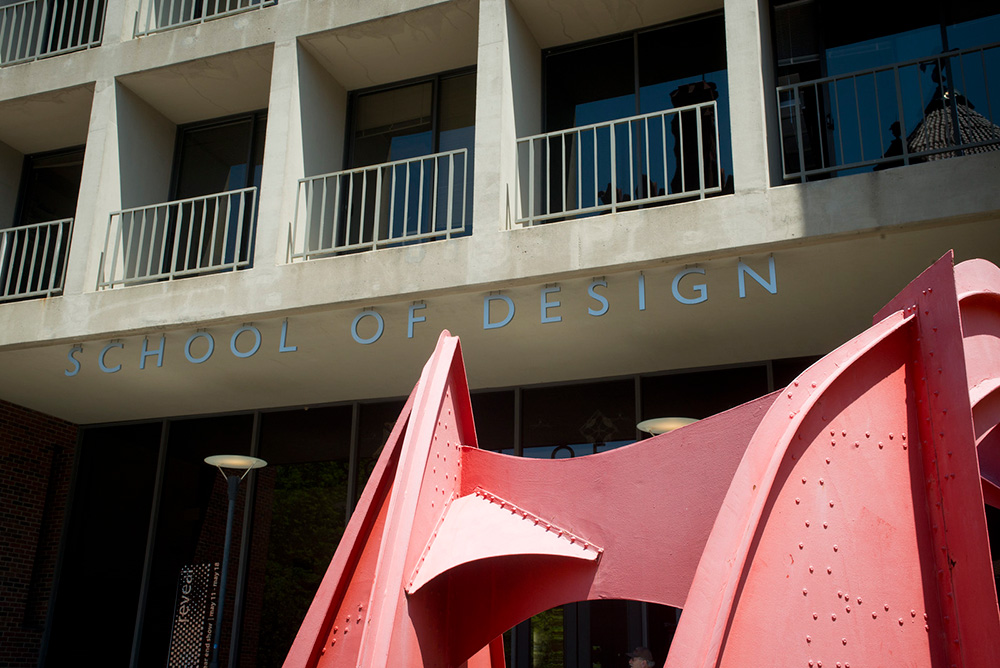
Stuart Weitzman School of Design

Wharton School

Interdisciplinary Centers, Units and Projects
Usage statistics.
- Frequently downloaded items
- Most read researchers
- Popular subjects
- International readership
DSpace software copyright © 2002-2024 LYRASIS
- Cookie settings
- Privacy policy
- End User Agreement
- Send Feedback
Smart. Open. Grounded. Inventive. Read our Ideas Made to Matter.
Which program is right for you?

Through intellectual rigor and experiential learning, this full-time, two-year MBA program develops leaders who make a difference in the world.
A rigorous, hands-on program that prepares adaptive problem solvers for premier finance careers.
A 12-month program focused on applying the tools of modern data science, optimization and machine learning to solve real-world business problems.
Earn your MBA and SM in engineering with this transformative two-year program.
Combine an international MBA with a deep dive into management science. A special opportunity for partner and affiliate schools only.
A doctoral program that produces outstanding scholars who are leading in their fields of research.
Bring a business perspective to your technical and quantitative expertise with a bachelor’s degree in management, business analytics, or finance.
A joint program for mid-career professionals that integrates engineering and systems thinking. Earn your master’s degree in engineering and management.
An interdisciplinary program that combines engineering, management, and design, leading to a master’s degree in engineering and management.
Executive Programs
A full-time MBA program for mid-career leaders eager to dedicate one year of discovery for a lifetime of impact.
This 20-month MBA program equips experienced executives to enhance their impact on their organizations and the world.
Non-degree programs for senior executives and high-potential managers.
A non-degree, customizable program for mid-career professionals.
5 ‘extraordinary turnarounds’ for global well-being
Close proximity is the key to knowledge spillovers among startups
6 ways to nurture IT talent
Credit: Mimi Phan
Ideas Made to Matter
Design thinking, explained
Rebecca Linke
Sep 14, 2017
What is design thinking?
Design thinking is an innovative problem-solving process rooted in a set of skills.The approach has been around for decades, but it only started gaining traction outside of the design community after the 2008 Harvard Business Review article [subscription required] titled “Design Thinking” by Tim Brown, CEO and president of design company IDEO.
Since then, the design thinking process has been applied to developing new products and services, and to a whole range of problems, from creating a business model for selling solar panels in Africa to the operation of Airbnb .
At a high level, the steps involved in the design thinking process are simple: first, fully understand the problem; second, explore a wide range of possible solutions; third, iterate extensively through prototyping and testing; and finally, implement through the customary deployment mechanisms.
The skills associated with these steps help people apply creativity to effectively solve real-world problems better than they otherwise would. They can be readily learned, but take effort. For instance, when trying to understand a problem, setting aside your own preconceptions is vital, but it’s hard.
Creative brainstorming is necessary for developing possible solutions, but many people don’t do it particularly well. And throughout the process it is critical to engage in modeling, analysis, prototyping, and testing, and to really learn from these many iterations.
Once you master the skills central to the design thinking approach, they can be applied to solve problems in daily life and any industry.
Here’s what you need to know to get started.
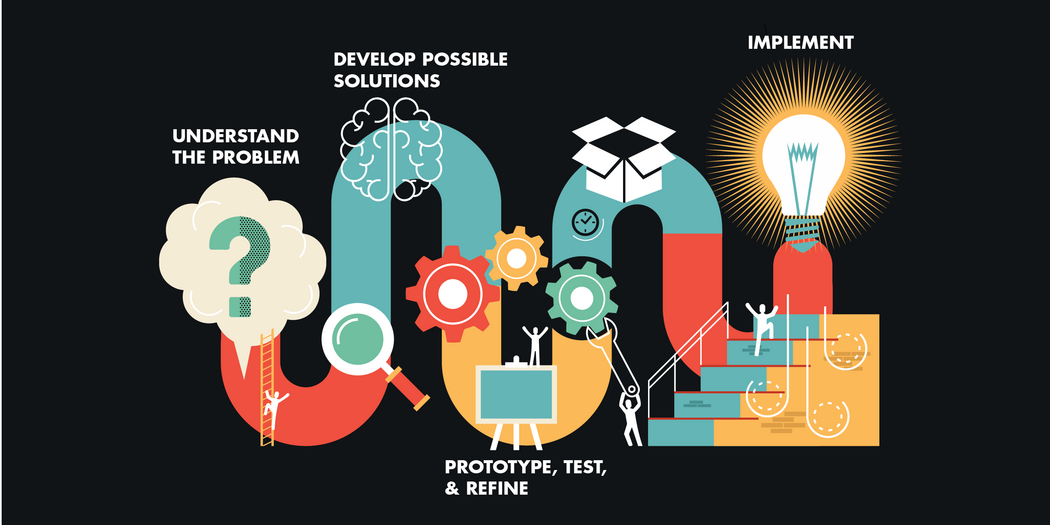
Understand the problem
The first step in design thinking is to understand the problem you are trying to solve before searching for solutions. Sometimes, the problem you need to address is not the one you originally set out to tackle.
“Most people don’t make much of an effort to explore the problem space before exploring the solution space,” said MIT Sloan professor Steve Eppinger. The mistake they make is to try and empathize, connecting the stated problem only to their own experiences. This falsely leads to the belief that you completely understand the situation. But the actual problem is always broader, more nuanced, or different than people originally assume.
Take the example of a meal delivery service in Holstebro, Denmark. When a team first began looking at the problem of poor nutrition and malnourishment among the elderly in the city, many of whom received meals from the service, it thought that simply updating the menu options would be a sufficient solution. But after closer observation, the team realized the scope of the problem was much larger , and that they would need to redesign the entire experience, not only for those receiving the meals, but for those preparing the meals as well. While the company changed almost everything about itself, including rebranding as The Good Kitchen, the most important change the company made when rethinking its business model was shifting how employees viewed themselves and their work. That, in turn, helped them create better meals (which were also drastically changed), yielding happier, better nourished customers.
Involve users
Imagine you are designing a new walker for rehabilitation patients and the elderly, but you have never used one. Could you fully understand what customers need? Certainly not, if you haven’t extensively observed and spoken with real customers. There is a reason that design thinking is often referred to as human-centered design.
“You have to immerse yourself in the problem,” Eppinger said.
How do you start to understand how to build a better walker? When a team from MIT’s Integrated Design and Management program together with the design firm Altitude took on that task, they met with walker users to interview them, observe them, and understand their experiences.
“We center the design process on human beings by understanding their needs at the beginning, and then include them throughout the development and testing process,” Eppinger said.
Central to the design thinking process is prototyping and testing (more on that later) which allows designers to try, to fail, and to learn what works. Testing also involves customers, and that continued involvement provides essential user feedback on potential designs and use cases. If the MIT-Altitude team studying walkers had ended user involvement after its initial interviews, it would likely have ended up with a walker that didn’t work very well for customers.
It is also important to interview and understand other stakeholders, like people selling the product, or those who are supporting the users throughout the product life cycle.
The second phase of design thinking is developing solutions to the problem (which you now fully understand). This begins with what most people know as brainstorming.
Hold nothing back during brainstorming sessions — except criticism. Infeasible ideas can generate useful solutions, but you’d never get there if you shoot down every impractical idea from the start.
“One of the key principles of brainstorming is to suspend judgment,” Eppinger said. “When we're exploring the solution space, we first broaden the search and generate lots of possibilities, including the wild and crazy ideas. Of course, the only way we're going to build on the wild and crazy ideas is if we consider them in the first place.”
That doesn’t mean you never judge the ideas, Eppinger said. That part comes later, in downselection. “But if we want 100 ideas to choose from, we can’t be very critical.”
In the case of The Good Kitchen, the kitchen employees were given new uniforms. Why? Uniforms don’t directly affect the competence of the cooks or the taste of the food.
But during interviews conducted with kitchen employees, designers realized that morale was low, in part because employees were bored preparing the same dishes over and over again, in part because they felt that others had a poor perception of them. The new, chef-style uniforms gave the cooks a greater sense of pride. It was only part of the solution, but if the idea had been rejected outright, or perhaps not even suggested, the company would have missed an important aspect of the solution.
Prototype and test. Repeat.
You’ve defined the problem. You’ve spoken to customers. You’ve brainstormed, come up with all sorts of ideas, and worked with your team to boil those ideas down to the ones you think may actually solve the problem you’ve defined.
“We don’t develop a good solution just by thinking about a list of ideas, bullet points and rough sketches,” Eppinger said. “We explore potential solutions through modeling and prototyping. We design, we build, we test, and repeat — this design iteration process is absolutely critical to effective design thinking.”
Repeating this loop of prototyping, testing, and gathering user feedback is crucial for making sure the design is right — that is, it works for customers, you can build it, and you can support it.
“After several iterations, we might get something that works, we validate it with real customers, and we often find that what we thought was a great solution is actually only just OK. But then we can make it a lot better through even just a few more iterations,” Eppinger said.
Implementation
The goal of all the steps that come before this is to have the best possible solution before you move into implementing the design. Your team will spend most of its time, its money, and its energy on this stage.
“Implementation involves detailed design, training, tooling, and ramping up. It is a huge amount of effort, so get it right before you expend that effort,” said Eppinger.
Design thinking isn’t just for “things.” If you are only applying the approach to physical products, you aren’t getting the most out of it. Design thinking can be applied to any problem that needs a creative solution. When Eppinger ran into a primary school educator who told him design thinking was big in his school, Eppinger thought he meant that they were teaching students the tenets of design thinking.
“It turns out they meant they were using design thinking in running their operations and improving the school programs. It’s being applied everywhere these days,” Eppinger said.
In another example from the education field, Peruvian entrepreneur Carlos Rodriguez-Pastor hired design consulting firm IDEO to redesign every aspect of the learning experience in a network of schools in Peru. The ultimate goal? To elevate Peru’s middle class.
As you’d expect, many large corporations have also adopted design thinking. IBM has adopted it at a company-wide level, training many of its nearly 400,000 employees in design thinking principles .
What can design thinking do for your business?
The impact of all the buzz around design thinking today is that people are realizing that “anybody who has a challenge that needs creative problem solving could benefit from this approach,” Eppinger said. That means that managers can use it, not only to design a new product or service, “but anytime they’ve got a challenge, a problem to solve.”
Applying design thinking techniques to business problems can help executives across industries rethink their product offerings, grow their markets, offer greater value to customers, or innovate and stay relevant. “I don’t know industries that can’t use design thinking,” said Eppinger.
Ready to go deeper?
Read “ The Designful Company ” by Marty Neumeier, a book that focuses on how businesses can benefit from design thinking, and “ Product Design and Development ,” co-authored by Eppinger, to better understand the detailed methods.
Register for an MIT Sloan Executive Education course:
Systematic Innovation of Products, Processes, and Services , a five-day course taught by Eppinger and other MIT professors.
- Leadership by Design: Innovation Process and Culture , a two-day course taught by MIT Integrated Design and Management director Matthew Kressy.
- Managing Complex Technical Projects , a two-day course taught by Eppinger.
- Apply for M astering Design Thinking , a 3-month online certificate course taught by Eppinger and MIT Sloan senior lecturers Renée Richardson Gosline and David Robertson.
Steve Eppinger is a professor of management science and innovation at MIT Sloan. He holds the General Motors Leaders for Global Operations Chair and has a PhD from MIT in engineering. He is the faculty co-director of MIT's System Design and Management program and Integrated Design and Management program, both master’s degrees joint between the MIT Sloan and Engineering schools. His research focuses on product development and technical project management, and has been applied to improving complex engineering processes in many industries.
Read next: 10 agile ideas worth sharing
Related Articles

- Reviews / Why join our community?
- For companies
- Frequently asked questions

Stage 3 in the Design Thinking Process: Ideate
In the Ideation stage, design thinkers spark off ideas — in the form of questions and solutions — through creative and curious activities such as Brainstorms and Worst Possible Idea . In this article, we’ll introduce you to some of the best Ideation methods and guidelines that help facilitate successful Ideation sessions and encourage active participation from members.
When facilitated in a successful way, Ideation is an exciting process. The goal is to generate a large number of ideas — ideas that potentially inspire newer, better ideas — that the team can then cut down into the best, most practical and innovative ones.
“Ideation is the mode of the design process in which you concentrate on idea generation. Mentally it represents a process of “going wide” in terms of concepts and outcomes. Ideation provides both the fuel and also the source material for building prototypes and getting innovative solutions into the hands of your users.” – d.school, An Introduction to Design Thinking PROCESS GUIDE
The main aim of the Ideation stage is to use creativity and innovation in order to develop solutions. By expanding the solution space, the design team will be able to look beyond the usual methods of solving problems in order to find better, more elegant, and satisfying solutions to problems that affect a user's experience of a product.
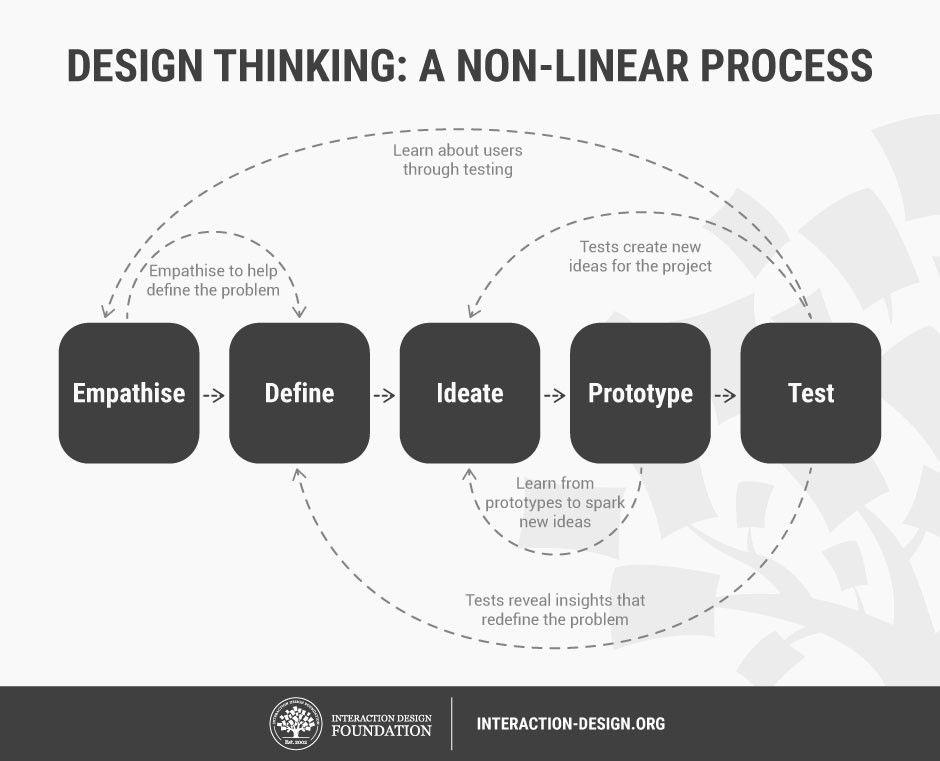
In the Design Thinking process, the Ideation stage often follows the first two stages, which are the Empathise stage and Define stage. There is a significant overlap between the Define and Ideation stages of a typical Design Thinking process. Interpreting information and defining the problem (s) and ideation both drive the generation of problem solutions. This overlap is represented in the types of methods design teams employ during these two stages. For example, Bodystorm and “How Might We” questions are often used in both of these stages.
Ideation Will Help You:
Ask the right questions and innovate.
Step beyond the obvious solutions and therefore increase the innovation potential of your solution.
Bring together perspectives and strengths of team members.
Uncover unexpected areas of innovation.
Create volume and variety in your innovation options.
Get obvious solutions out of your heads, and drive your team beyond them.
Ideation Methods to Spark Innovative Ideas
There are hundreds of ideation methods. Some methods are merely renamed or slightly adapted versions of more foundational techniques. Here you’ll get brief overview of some of the best methods:
Challenge Assumptions
Sketch or Sketchstorm
Provocation
Gamestorming
Co-Creation Workshops
Creative Pause
Active Facilitation
Although many of us may have previously participated in a Brainstorm session, it is not always easy to facilitate a truly fruitful ideation session, which may be the reason why many of us have had negative experiences in the past. However, Ideation sessions can indeed be fun and exciting, but they demand a lot of preparation and team member concentration in order to be fruitful. To sit the team down with a blank piece of paper and ask them to come up with ideas will likely result in failure. Likewise, to have everyone shout out their own ideas is likely to result in failure.
People need guidance, inspiration and activities, in a physical and cognitive manner, in order to get the process started. Ideation is a creative and concentrated process; those involved should be provided with an environment that facilitates free, open, and the non-judgemental sharing of ideas.
In Ideation sessions, it’s important to create the right type of environment to help create a creative work culture with a curious, courageous, and concentrated atmosphere. Instead of using a boardroom with the CEO sitting at the head of the table, Design Thinking and Ideation sessions require a space in which everyone is equal. The Ideation room must have sufficient space for people to feel comfortable, but the atmosphere shouldn't be sterile, and team members shouldn't have to shout in order to be heard. You should also designate someone to take down contributors' ideas and draw/write them on the whiteboard/wall/poster. If the process begins to slow down and people seem to be running into a dead-end, the facilitator should impose constraints, such as: "what if there was no top-level navigation bar?" or "How-might-we go about the task if we were 8 years old?" Alternatively, you might want to set targets, such as filling a brainstorming sheet within ten minutes. To start understanding what it takes to facilitate a successful Ideation session, we’ll take a closer look at the best Brainstorming rules.
Brainstorming Rules
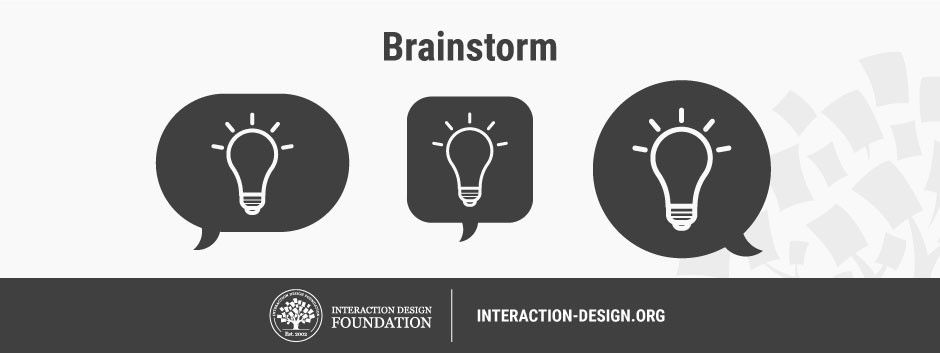
At its most basic level, a Brainstorm session involves sprouting related points from a central idea. Brainstorming is one of the primary methods employed during the Ideation stage of a typical Design Thinking process. Brainstorming is a great way to generate many ideas by leveraging the collective thinking of the group, engaging with each other, listening, and building on other ideas. This method involves focusing on one problem or challenge at a time, while team members build on each other’s responses and ideas with the aim of generating as many potential solutions as possible. These can then be refined and narrowed down to the best solution(s). Participants must then select the best, the most practical, or the most innovative ideas from the options they’ve come up with.
We’ve summarised the best practices and brainstorming rules from the Institute of Design at Stanford (d.school) and the successful design company , IDEO who celebrates Design Thinking.
Set a time limit
Start with a problem statement, point of view , possible questions, a plan, or a goal and stay focused on the topic: Identify the core subject or the main aim of the exercise. For example, what are you trying to achieve? Are you trying to improve a certain feature? Are you focusing on ways to improve the overall experience? Condense the main issue into a problem statement and condense it into a short “How Might We” sentence. You may even be able to synthesise this into single word. Your ideas should always branch off from this central headline.
Stay on Topic : It is easy to veer off and take lots of different directions during brainstorming sessions, especially when you are trying to be open-minded and unconstrained in your efforts to come up with ideas. It is important that members stay on topic. Focus is essential; otherwise, the process can become confusing, or ideas can become muddled and cross between solutions for other problems. Every effort should be made by the facilitator to keep members on the central theme and goal. You might even want to designate a particular brainstormer to maintain the thread and prevent team members veering off course.
Defer judgement or criticism, including non-verbal: The brainstorming environment is not the time to argue or for questioning other members’ ideas; each member has a responsibility to foster relations that advance the session. For this reason, judgement comes later so rather than blocking an idea, you and your other team members are encouraged to come up with your own ideas that sprout off from those provided by the other members of your team.
Encourage weird, wacky and wild ideas: Once again, as brainstorming is a creative activity, each member should try to encourage other members and create an environment in which they feel comfortable verbalising their ideas. Free thinking may produce some ideas that are wide off the mark, but brainstorming is about drawing up as many ideas as possible which are then whittled down until the best possible option remains.
Aim for quantity: Brainstorming is effectively a creative exercise, in which design thinkers are encouraged to let their imaginations run wild. The emphasis is on quantity, rather than quality at this stage.
Build on each others' ideas: One idea typically leads on from another; by considering the thoughts, opinions, and ideas of other team members during the brainstorming session, new insights and perspectives can be achieved, which then inform one's own ideas. Thus, the team will continue to build ideas which hopefully become progressively more refined and targeted towards the central issue.
Be visual: The physical act of writing something down or drawing an image in order to bring an idea to life can help people think up new ideas or view the same ideas in a different way. The brainstorming session is more likely to evolve if team members visualize and bring ideas to life rather than rely on discussion alone.
One conversation at a time: Design thinkers (or brainstormers) should focus on one point or conversation at a time so as not to muddy their thinking and lose sight of the thread or current objective.
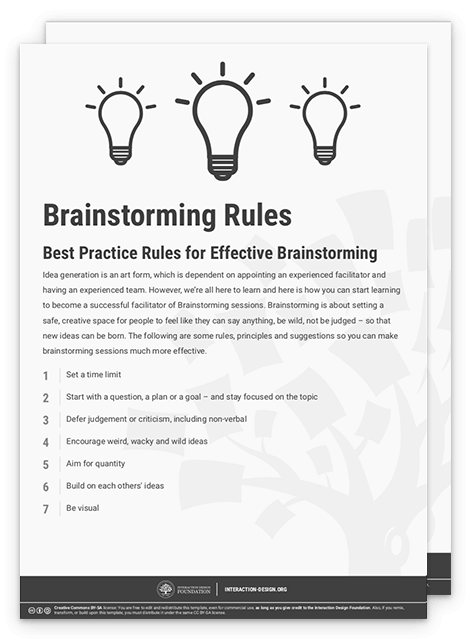
Ideation Methods to Select Ideas
Once the Ideation session is complete, the ideas must be collected, categorized, refined, and narrowed down, so the team is able to select the best solutions, ideas, and strategies from a shortlist. These methods can help you select the best idea at the end of an Ideation session:
Post-it Voting or Dot Voting.
Four Categories Method
Bingo selection.
Idea Affinity Maps
Now Wow How Matrix
Six Thinking Hats
Lean Startup Machine Idea Validation Board
Idea Selection Criteria
In the following section, we’ll provide you with a brief introduction to some of the best methods.
Post-it Voting or Dot Voting
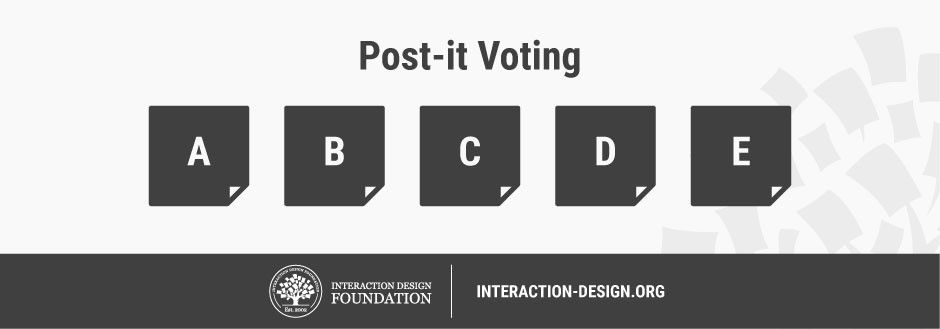
In post-it voting, all members are given a number of votes (three to four should do) in order to choose their favorite ideas. Ideas that are generated in the Ideation sessions are written down on individual post-its, and members can vote by using stickers or a marker to make a dot on the post-it note corresponding to the ideas they like. This process allows every member to have an equal say in choosing from the shortlisted ideas.
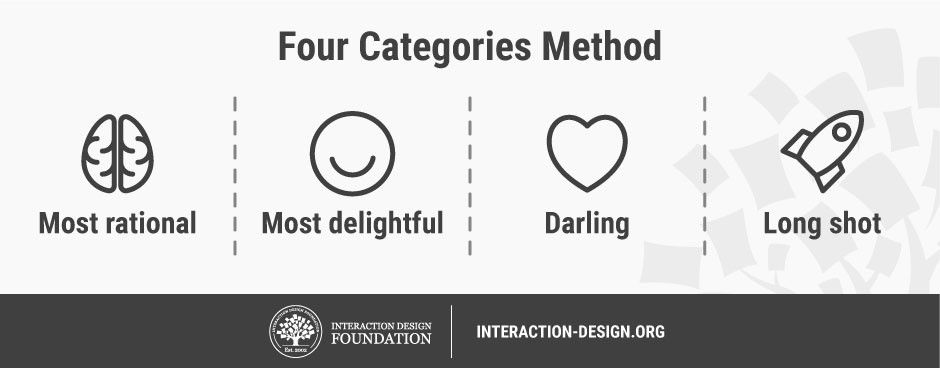
The four categories method involves dividing ideas according to their relative abstractness, ranging from the most rational choice to the 'long shot' choice. The four categories are the rational choice, the most likely to delight, the darling, and the long shot. Members then decide upon one or two ideas for each of these categories. This method ensures that the team covers all grounds, from the most practical to those ideas with the most potential to deliver innovative solutions.
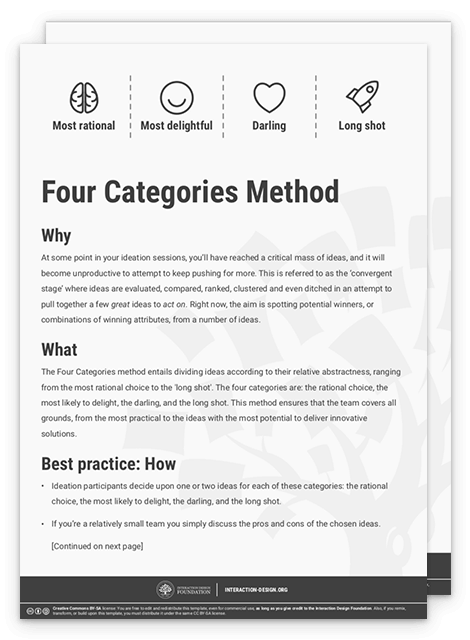
Similarly, the Bingo selection method inspires members to divide ideas. However, in this method, contributors are encouraged to split ideas according to a variety of form factors, such as their potential application in a physical prototype, a digital prototype, and an experience prototype.
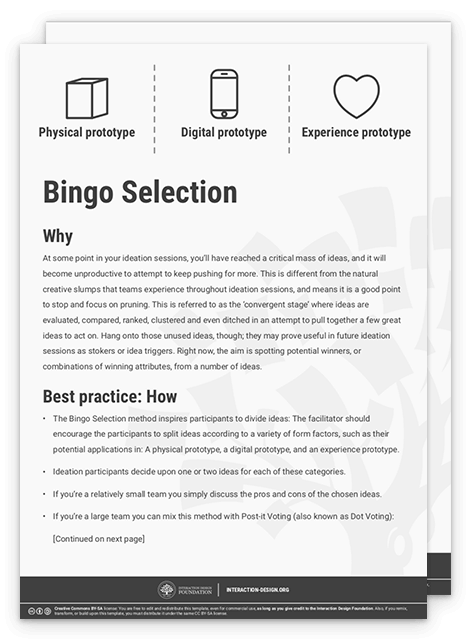
The Take Away
Ideation is often the most exciting stage in a Design Thinking project because almost unrestrained free thinking can occur within the given field. In the Ideation stage, the aim is to generate a large number of ideas — ideas that potentially inspire newer, better ideas — which the team can then filter and narrow down into the best, most practical, or most innovative ones. There are many great methods that can help the design team during the Ideation sessions.
References & Where to Learn More
Course: “Design Thinking - The Ultimate Guide” .
IDEO U: Brainstorming .
d.school: “How might we” questions .
d.school, An Introduction to Design Thinking PROCESS GUIDE .
Hero Image: Author/Copyright holder: Adriadne. Copyright terms and license: CC0
Design Thinking: The Ultimate Guide

Get Weekly Design Tips
Topics in this article, what you should read next, what is design thinking and why is it so popular.

- 1.6k shares
Personas – A Simple Introduction

- 1.5k shares
Stage 2 in the Design Thinking Process: Define the Problem and Interpret the Results

- 1.3k shares
What is Ideation – and How to Prepare for Ideation Sessions

- 1.2k shares
Affinity Diagrams: How to Cluster Your Ideas and Reveal Insights

- 2 years ago
Stage 4 in the Design Thinking Process: Prototype

- 3 years ago
14 UX Deliverables: What will I be making as a UX designer?

Stage 1 in the Design Thinking Process: Empathise with Your Users

Empathy Map – Why and How to Use It

- 3 weeks ago
What Is Empathy and Why Is It So Important in Design Thinking?

Open Access—Link to us!
We believe in Open Access and the democratization of knowledge . Unfortunately, world-class educational materials such as this page are normally hidden behind paywalls or in expensive textbooks.
If you want this to change , cite this article , link to us, or join us to help us democratize design knowledge !
Privacy Settings
Our digital services use necessary tracking technologies, including third-party cookies, for security, functionality, and to uphold user rights. Optional cookies offer enhanced features, and analytics.
Experience the full potential of our site that remembers your preferences and supports secure sign-in.
Governs the storage of data necessary for maintaining website security, user authentication, and fraud prevention mechanisms.
Enhanced Functionality
Saves your settings and preferences, like your location, for a more personalized experience.
Referral Program
We use cookies to enable our referral program, giving you and your friends discounts.
Error Reporting
We share user ID with Bugsnag and NewRelic to help us track errors and fix issues.
Optimize your experience by allowing us to monitor site usage. You’ll enjoy a smoother, more personalized journey without compromising your privacy.
Analytics Storage
Collects anonymous data on how you navigate and interact, helping us make informed improvements.
Differentiates real visitors from automated bots, ensuring accurate usage data and improving your website experience.
Lets us tailor your digital ads to match your interests, making them more relevant and useful to you.
Advertising Storage
Stores information for better-targeted advertising, enhancing your online ad experience.
Personalization Storage
Permits storing data to personalize content and ads across Google services based on user behavior, enhancing overall user experience.
Advertising Personalization
Allows for content and ad personalization across Google services based on user behavior. This consent enhances user experiences.
Enables personalizing ads based on user data and interactions, allowing for more relevant advertising experiences across Google services.
Receive more relevant advertisements by sharing your interests and behavior with our trusted advertising partners.
Enables better ad targeting and measurement on Meta platforms, making ads you see more relevant.
Allows for improved ad effectiveness and measurement through Meta’s Conversions API, ensuring privacy-compliant data sharing.
LinkedIn Insights
Tracks conversions, retargeting, and web analytics for LinkedIn ad campaigns, enhancing ad relevance and performance.
LinkedIn CAPI
Enhances LinkedIn advertising through server-side event tracking, offering more accurate measurement and personalization.
Google Ads Tag
Tracks ad performance and user engagement, helping deliver ads that are most useful to you.
Share Knowledge, Get Respect!
or copy link
Cite according to academic standards
Simply copy and paste the text below into your bibliographic reference list, onto your blog, or anywhere else. You can also just hyperlink to this article.
New to UX Design? We’re giving you a free ebook!

Download our free ebook The Basics of User Experience Design to learn about core concepts of UX design.
In 9 chapters, we’ll cover: conducting user interviews, design thinking, interaction design, mobile UX design, usability, UX research, and many more!
New to UX Design? We’re Giving You a Free ebook!
- Business Essentials
- Leadership & Management
- Credential of Leadership, Impact, and Management in Business (CLIMB)
- Entrepreneurship & Innovation
- Digital Transformation
- Finance & Accounting
- Business in Society
- For Organizations
- Support Portal
- Media Coverage
- Founding Donors
- Leadership Team
- Harvard Business School →
- HBS Online →
- Online Business Certificate Courses
- Business Strategy
- Leadership, Ethics, and Corporate Accountability

Design Thinking and Innovation
Key concepts, who will benefit, aspiring or current innovation managers, entrepreneurs, product managers, developers, and marketers.

What You Earn

Certificate of Completion
Boost your resume with a Certificate of Completion from HBS Online
Earn by: completing this course
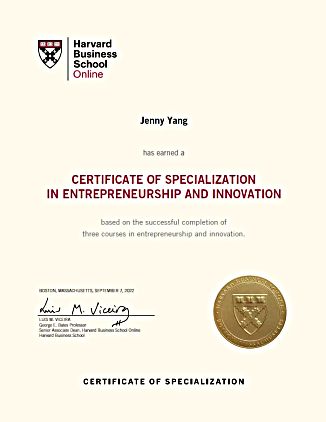
Certificate of Specialization
Prove your mastery of entrepreneurship and innovation
Earn by: completing any three courses within this subject area to earn a Certificate of Specialization
Content Week - Clarify: Empathy and Understanding

- An Introduction to Innovation
- Clarify Through Observation
- Insights and Problem Framing
- The Right Enviroment for Creativity
Featured Exercises
Project week – clarify.

- Project Instructions
Content Week - Ideate, Part 1: Tools for Generating Ideas

- Establishing Focus with Design Principles
- The Ideation Process: Getting Started with SIT
- More SIT Tools for Ideation
- Open-Ended Approaches to Generating Ideas
- Review of Project Work
Content Week - Ideate, Part 2: User Values and Behaviors

- Design Heuristics for Generating and Refining Ideas
- Designing for Behavior Change
Project Week - Ideate

Content Week - Develop: An Experimentation Mindset

- Idea Selection and Evaluation
- Defining and Refining Your Prototype Plan
- Prototyping: From Exploration to Validation
- Leading Concept Development
Content Week - Implement: Communication and Structure

- Overcoming Developer and User Bias
- Strategies for Communicating Value
- Managing an Innovation Culture

So You Want to Be an Entrepreneur: How to Get Started
Our difference, about the professor.

Srikant Datar Design Thinking and Innovation
Dates & eligibility.
No current course offerings for this selection.
All applicants must be at least 18 years of age, proficient in English, and committed to learning and engaging with fellow participants throughout the course.
Learn about bringing this course to your organization .
Learner Stories

Design Thinking and Innovation FAQs
Could you tell me a little more about the ai course assistant chat bot.
You can think of the beta version of the Design Thinking and Innovation AI Course Assistant chat bot in two ways: like a virtual Teaching Assistant who can help you consolidate and confirm your understanding of course concepts, and as a virtual Learner Success Assistant who can help you stay on track with completing the coursework in a timely fashion. When you are finding a particular concept difficult to master, or would like additional examples of a theory, try asking the bot your question in the same way you would phrase it to a human TA. If you have a question pertaining to where or how to submit certain assignments, or one relating to deadlines or time estimates, you can also express those in a similar fashion. Please note that no preexisting familiarity or experience with generative AI is necessary or assumed to use the bot and, while we encourage you to engage with the bot and share your candid feedback on your experience, a lack of engagement with the bot will not adversely impact your eligibility for a certificate of completion.
What are the learning requirements in order to successfully complete the course, and how are grades assigned?
Participants in Design Thinking and Innovation are eligible for a Certificate of Completion from Harvard Business School Online.
Participants are expected to fully complete all coursework in a thoughtful and timely manner. This will mean meeting each week’s course module deadlines and fully answering questions posed therein. This helps ensure participants proceed through the course at a similar pace and can take full advantage of social learning opportunities. In addition to module and assignment completion, we expect you to offer feedback on others’ reflections and contribute to conversations on the platform. Participants who fail to complete the course requirements will not receive a certificate and will not be eligible to retake the course.
More detailed information on course requirements will be communicated at the start of the course. No grades are assigned for Design Thinking and Innovation. Participants will either be evaluated as complete or not complete.
What materials will I have access to after completing Design Thinking and Innovation?
You will have access to the materials in every prior module as you progress through the program. Access to course materials and the course platform ends 60 days after the final deadline in the program.
At the end of each course module, you will be able to download a PDF summary highlighting key concepts used throughout the course. At the end of the program, you will receive a PDF compilation of all of the module summary documents. We hope the module summary documents will serve as a helpful resource after you finish the course.
How should I list my certificate on my resume?
Once you've earned your Certificate of Completion, list it on your resume along with the date of completion:
Harvard Business School Online Certificate in Design Thinking and Innovation [Cohort Start Month and Year]
List your certificate on your LinkedIn profile under "Education" with the language from the Credential Verification page:
School: Harvard Business School Online Dates Attended: [The year you participated in the program] Degree: Other; Certificate in Design Thinking and Innovation Field of Study: Leave blank Grade: "Complete" Activities and Societies: Leave blank
Description: Design Thinking and Innovation is a 7-week, 40-hour online certificate program from Harvard Business School. Design Thinking and Innovation will teach you how to leverage fundamental design thinking principles and innovative problem-solving tools to address business challenges and build products, strategies, teams, and environments for optimal use and performance.
The program was developed by leading Harvard Business School faculty and is delivered in an active learning environment based on the HBS signature case-based learning model.
What is the project?
Beginning in Module 2 of Design Thinking and Innovation, you will apply the tools you learn in the course to an innovation problem that is important or interesting to you, or you can use a provided scenario. In subsequent modules, you will use your earlier responses to build on your innovation project and make each phase of design thinking relevant to your own work.
Do I need to collaborate with others to complete the project?
No, each individual submits their own work in Design Thinking and Innovation, and all project work can be submitted without sharing it with others in the course. You are encouraged to share with others and ask for feedback, but collaboration isn’t necessary to advance through the course.
Related Programs

Negotiation Mastery
Secure maximum value for your organization through a mastery of negotiation techniques.

Entrepreneurship Essentials
Master a proven framework for building and financing new ventures, and make your entrepreneurial dreams a reality.

Disruptive Strategy
Strengthen your capacity to create winning strategies and bring innovations to market by discovering customer jobs to be done and aligning your business’s resources, processes, and profit formula.
We're sorry but you will need to enable Javascript to access all of the features of this site.
Stanford Online
Creativity and design thinking program.
Stanford School of Engineering
Program Enrollment: $3,495
Get Started
Let’s make creativity and innovation part of your standard operating procedures. With our design thinking courses, you can bring new ideas and fresh perspectives to your team, your department, or your entire company. We’ll show you how design thinking can (and will) unlock your creativity so that you can repeatedly come up with innovative ideas and solutions to problems (big and small) that you face in your life and your work. Through online content, hands-on assignments, ongoing coaching, and proven frameworks, you'll learn how to practice and champion design thinking in any role you're in.
- Continuously produce breakthrough ideas
- Catalyze design thinking in your company
- Unlock the innovative capacity of your team
- Build a lifelong practice of creative problem-solving
Program Components

Introduction to Design Thinking
Jeremy Utley and Justin Ferrell will introduce you to design thinking, as they teach it every day here at the Stanford d.School. Get started in your design thinking journey and prepare for further, more hands-on courses.

Achieving Innovation through Inspiration
Inspiration isn’t something you wait for. It’s something you work for. Gain the critical tools you need to seek the inspiration that will turn unknowns into radically new products and services.

Empathize and Prototype: A Hands on Dive into the Key Tools of Design Thinking
Master techniques for gaining empathy with customers and immediately put them to use in a series of hands-on exercises that guide you from synthesis to prototyping and testing.

Innovation at Work
Follow along with hands-on exercises that lead you from ideation to prototyping and presentation. You'll learn how to lead innovation and brainstorming sessions in your company.

Live Interaction with Faculty and Peers
Participate in monthly “Activation Hours” where you’ll join our program instructors live, as they walk you through new, supplemental creativity and design thinking content. In the discussion sessions, you will meet and collaborate with your fellow learners.

Dr. Kathryn Segovia of the Stanford d.school will guide you through a series of coaching lessons between each course that will help you build your daily creative practice and form a lifelong routine that fosters innovation.

Chats with David Kelley
Throughout the program, David Kelley invites you into his personal design studio for a series of chats on different aspects of creativity and design thinking, from the origins of design thinking to strengthening your creative muscles and building creative confidence.
- Preview Image
- Course/Course #
- Time Commitment
- Availability
Program Courses (Included)

Flexible Enrollment Options
Individual enrollments.
$3,495 1 year of access
View and complete course materials, video lectures, assignments, and exams, at your own pace. You also get 1 year of email access to your Stanford teaching assistant.
Groups and Teams
Special Pricing
Enroll as a group and learn together. By participating together, your group will develop a shared knowledge, language, and mindset to tackle challenges ahead. We can advise you on the best options to meet your organization’s training and development goals.
What You'll Earn

You’ll earn a Stanford Certificate of Achievement in Creativity and Design Thinking when you successfully complete this program.
Your blockchain-verified digital certificate will allow you to showcase your achievements on LinkedIn and other platforms, validate credentials with employers, and highlight your expertise.
What Our Learners Are Saying
Ready to transform your company and build a culture of innovative problem-solving? Bring design thinking to your team and colleagues today.
"I want to get students active and engaged and co-create their learning experience with their teachers."
Watch Video
Academic Director

David Kelley
Donald W. Whittier Professor Mechanical Engineering
David Kelley's work is dedicated to helping people gain confidence in their creative abilities. He employs a project based methodology called Design Thinking within both the Product Design Program and the Hasso Plattner Institute of Design. Design Thinking is based on building empathy for user needs, developing solutions with iterative prototyping, and inspiring ideas for the future through storytelling. The Product Design program emphasizes the blending of engineering innovation, human values, and manufacturing concerns into a single curriculum. Kelley teaches engineering design methodology, the techniques of quick prototyping to prove feasibility, and design through understanding of user needs.
Teaching Team

Justin Ferrell
Strategic Partnerships
Hasso Plattner Institute of Design at Stanford
Justin Ferrell joined the d.school in 2012 to redesign and direct its fellowship program. A career journalist specializing in organizational behavior and design, Justin worked for seven years at The Washington Post, most recently as the director of digital, mobile & new product design. He brought mobile designers and programmers into the newsroom, and enabled collaborative teams of reporters, editors and developers to create groundbreaking work. Also a prolific visual storyteller, Justin designed several award-winning projects — including the investigative series “Angler: The Cheney Vice Presidency,” winner of the 2008 Pulitzer Prize for National Reporting. He has spoken on creative culture and human-centered design in many venues, from the SXSW Interactive festival in Austin, to the Norwegian Research Council in Oslo, to the U.S. Embassy in Dublin, to Education City in Doha, Qatar. Justin teaches Stanford graduate courses in design thinking, creativity and organization design. He also teaches executive education at the Stanford Graduate School of Business, and his consulting clients have included Hewlett-Packard, IDEO and Citi Ventures. He has led many innovation workshops, including sessions for Alestra, Facebook, Google, Knight Foundation, Nokia, SAP, the U.S. Department of State, The United Nations and the World Economic Forum.

Perry Klebahn
Adjunct Professor, Director of Executive Education
When it comes to startups, corporations and executive leadership, Perry’s seen just about everything. He's a seasoned entrepreneur, product designer, chief executive and co-founding member of the d.school faculty with over 20 years of experience. He also loves math, motorcycles and making things. Perry brought two out of three of those interests to bear when he created a new category of sportswear by way of a high-performance shoe — a snowshoe — for his product design master’s thesis. He went on to found the Atlas Snowshoe Company, which remains the leader in snowshoe design and technology. Perry sold Atlas and became the head of Sales and Marketing for the clothing brand, Patagonia in 2000. He then went on to be named the CEO of the iconic bag company, Timbuk2 in 2007. Both opportunities gave him extensive experience in brand turn-around, design and innovation. Despite his years running startups and corporations, Perry’s true calling is teaching. He leverages the breadth and depth of his experience as he pushes his students to bring rigor and precision to their fast-paced design work. His students often tell him that, while they were intimidated by him during the course, they're grateful for the pressure he placed on them to exceed their own expectations. Perry is a founding teaching team member for the d.school’s startup gauntlet class, Launchpad, the innovation leadership course, d.leadership and the week-long executive education intensive, Bootcamp. He is also on the teaching teams for the personal development course, Designer in Society and the organizational change course, d.org. In every class, Perry guides his students to look back in order to discover what to do next and works from the unshakeable belief that it’s always possible to see a problem differently.
Perry is an Adjunct Professor and Director of Executive Education at the d.school. He holds a B.A. in Physics from Wesleyan University (1988) and a Master’s degree in Product Design from Stanford University (1991).

Kathryn Segovia
Lecturer, Hasso Plattner Institute of Design
Kathryn Segovia brings her expertise in process, methods and tools to the Stanford d.school teaching team. She also brings a wealth of industry experience, having worked on fast-paced internal, external, strategic and retail design challenges. Kathryn brings a keen awareness and understanding of the unique challenges faced by internal design teams as well as those faced by intact teams working to apply design thinking. Kathryn enjoys helping people whittle down the layers of their work lives to reveal who they really are while supporting them through moments of doubt and fear as they embark on their life-long process of leadership development. Witnessing that moment in her students when they see their work and life challenges differently, through a new lens with refreshed energy, is one of her true joys.
Kathryn is a lecturer and Head of Learning Experience Design at the d.school in addition to her work as an independent consultant. Her past clients include Steelcase and VF Corporation. She holds a Ph.D. (2012), Master’s degree (2010) and B.A. (2007) in Communication as well as a Master’s degree in Psychology (2007) — all from Stanford University.

Jeremy Utley
Adjunct Professor
Jeremy never expected to be a designer. On his 10th birthday, his father asked him what he wanted to be when he grew up. Jeremy replied,”I want to be one of the people who carry boxes with handles.” A little over a decade later, Jeremy became a briefcase-carrying management consultant focusing on economic development. Then, in 2008, d.school derailed him completely. His time as a student and a fellow at the d.school showed him that “how” he worked was more important than “what” he did. Today, Jeremy is dedicated to helping others along the same path to becoming a designer. He helps people change their deeply-engrained behaviors and discover, as he did, that it is possible for them to make a difference. He does this through teaching as well as through growing alongside his students to become better in his own life and work every day.
Jeremy is the Director of Executive Education at the d.school. He is a graduate of The University of Texas at Austin’s Red McComb’s School of Business (2005) and the Stanford University Graduate School of Business (2009).
You May Also Like

Digital Transformation Program

Product Management Program

Leading People, Culture, and Innovation Program
- Engineering
- Computer Science & Security
- Business & Management
- Energy & Sustainability
- Data Science
- Medicine & Health
- Explore All
- Technical Support
- Master’s Application FAQs
- Master’s Student FAQs
- Master's Tuition & Fees
- Grades & Policies
- Graduate Application FAQs
- Graduate Student FAQs
- Graduate Tuition & Fees
- Community Standards Review Process
- Academic Calendar
- Exams & Homework FAQs
- Enrollment FAQs
- Tuition, Fees, & Payments
- Custom & Executive Programs
- Free Online Courses
- Free Content Library
- School of Engineering
- Graduate School of Education
- Stanford Doerr School of Sustainability
- School of Humanities & Sciences
- Stanford Human Centered Artificial Intelligence (HAI)
- Graduate School of Business
- Stanford Law School
- School of Medicine
- Learning Collaborations
- Stanford Credentials
- What is a digital credential?
- Grades and Units Information
- Our Community
- Get Course Updates
The Challenge: prototype experiments that reframe a car company’s place in the rapidly changing world of mobility.
Cars have changed how we shop, travel, and work; they’ve reshaped our homes, towns, and the world’s infrastructure.
Why the Financial Services Sector Should Embrace Design Thinking. Financial institutions need to evolve rapidly or risk disruption at the hands of nimble Fintech start-up companies.
Design thinking helped The Guardian newspaper and publishing group change their funding model, boost revenue and adapt their culture and engage on an emotional level with their readers. In this case study, Alex Breuer, Executive Creative Director and Tara Herman, Executive Editor, Design explain how design thinking was able to achieve these goals for The Guardian.
How the Lummi Tribal clinic used design to address opioid overdoses
Applying Design Thinking internally, within a group, community or to ourselves. This is a new application of the Design Thinking Methodology.
In 2017, employees, managers, and partners of Société Générale Global Solution Centre agreed that invoices based on time tracking and project allocation were a chronic and painful challenge.
In this use case the cities of Aalborg and Rotterdam share their findings obtained from design thinking initiatives. This is based on empirical research as part of an evaluation. The use case is written for other professionals in the field of design in public organizations.
Organizational culture represents a crucial factor for the introduction of innovation throughout the organization via Design Thinking and agile way of working. Thus, the organization must establish a culture that encompasses a shared vision with values that create a commitment to learn, experiment and accept failure.
Oral B wanted to integrate digital technology into their electric toothbrush. The Brands first thoughts were to help users to track how well they were brushing their teeth. Future Facility, a product design firm in the UK suggested a different approach. Focus on the pain points of electric toothbrush users.
eCarSharing: Energy Solutions for the New Generation
In 2015, Itai Ben-Jacob pitched his own ideas for a viable business model and developed the idea for innogy’s eCarSharing project in a design thinking workshop. His goal was to explore one of innogy’s innovation focus areas, ‘urban mobility.’
This case study focuses on a Design Thinking Workshop for primary school learners. The aim of the workshops was to provide learners with a new set of skills which they can employ when problem solving for real world challenges.
The average American wastes enough food each month to feed another person for 19 days. Through a number of projects with The Rockefeller Foundation and other organizations, IDEO designers from across the U.S. devised novel ways to tackle food waste.
When B2B companies talk about user experience, they are really considering the aggregated needs of multiple people and roles in a large ecosystem. But what happens when those objectives are vastly different for every individual?
“Humans don’t stop being humans just because they entered an office building.”
In this unique applied research study, academics and designers partnered with four of ECR’s Retailer members to immerse themselves in the self-checkout experience, understanding from the perspectives of the shopper and self-checkout supervisors, their journey from entry to exit, and their design challenges and frustrations.
This is an example of accelerating a transformation through co-design. Eighty-two professionals gathered, representing OTP’s whole organization. Together, they were able to achieve months of work in just three days.
In the early 2000s, Mayo Clinic physician Nicholas LaRusso asked himself a question: if we can test new drugs in clinical trials, can we in a similarly rigorous way test new kinds of doctor-patient interactions?
Olivier Glassey, Jean-Henry Morin, Patrick Genoud, Giorgio Pauletto
This paper examines how design thinking and serious game approaches can be used to support participation.
In these case studies the authors discovered the following results.
In her doctoral paper Loraine Rossi de Campos explores the use of Design Thinking in a school district for a 4-5 grade school.
In this article Kunal Vaed, The Street, describes how E*Trade used design thinking to enable the company to help investors get smarter by going from the idea of investing to an investment in 5 minutes.
Thanks to providers like Fidelity, people can rely on easy, convenient systems to stay on track with their retirement savings. But when it comes to saving for important near-term goals (think: vacation, house, or wedding), people tend to be less organized.
How to use design thinking to make great things actually happen by Tim Brown and Roger L. Martin. In this great HBR article, the authors look at design thinking in Finance with two case studies, one from MassMutual and the other from Intercorp. Group of Peru.
Ever since it became clear that smart design led to the success of many products, companies have been employing it in other areas, from customer experiences, to strategy, to business ecosystems. But as design is used in increasingly complex contexts, a new hurdle has emerged: gaining acceptance (for the new solutions).
The 4 case studies by Penn Nursing illustrate how nurses can be really powerful collaborators and generators of solutions within Healthcare. The videos describe the main attributes that nurses bring to the problem solving table
How IBM made sense of ‘generic design thinking’ for tens of thousands of people.
Dave Robertson presents two case studies with the British Columbia Government (Canada). One with the Ministry of Transportation discussing their (public servant centered website), the other solving the problem of finding a solution to where to place a power substation.
How do you encourage new customers to open bank accounts? In 2004, Bank of America used the Design Thinking methodology to look at the problem from a human centered perspective when they assigned design agency IDEO to boost their enrollment numbers: a problem that at the time, lacked any user perspective on why it was so hard for customers to save.
The Ministry of Manpower’s Work Pass Division (WPD) used design thinking as a tool to develop better ways to support foreigners who choose Singapore as a destination to live, work and set up businesses. The case reveals: Design thinking can potentially transform the perception and meaning of public service.
This case concerns one of the earliest attempts by design thinkers at designing a large, complex system. It shows that design approaches in the public sector can look back at a long history. And it reveals how design thinking within the organization must include members of the whole organization in the design process.
THE CHALLENGE
Remove roadblocks that can compromise the in-car experience for the Lincoln car company.
The final product, the Lincoln MKC luxury crossover, is credited with helping the Lincoln brand outpace growth in the luxury segment by more than two-to-one over competitors.
Developing environmental sustainability strategies, the Double Diamond method of LCA and design thinking: a case study from aged care. Journal of Cleaner Production, 85, 67-82. Stephen J. Clune*, Simon Lockrey.
In this case study the project leaders goal was to improve the experience of bus users on Madrid's EMT system by offering a technological solution to increase the users’ satisfaction with regard to accessibility during the bus trip as well as when waiting for the bus to arrive.
Read more...
To some fintechs, non-insurance incumbents, and venture capitalists, the industry’s challenges suggest opportunity. The life insurance value chain is increasingly losing share to these players, who are chipping away at the profit pool.
How might incumbent life insurers keep pace in today’s fast-moving competitive environment and meet customers’ changing needs?
This paper investigates what features of design thinking are employed in FMCG brand development via stakeholder interviews in three domains: agencies, companies, and retailers. This paper concludes with suggestions of how design thinking can be embraced in FMCG brand development.
This is a great case study that underlines the complexity of bringing game changing products to market. It helps to provide an understanding of just how much more is needed that a simple five step process of idea generation.
The Guardian's redesign, which launched in January 2018, illustrated the business impact when design is valued. The Guardian has a strong culture of design and increasingly, how design thinking can contribute to organizational change and development.
Understanding what has been missed in translation.
Method design experimentation can be wonderful and what we find often missing from this particular exploration is any kind of meaningful historical context. To coin a popular knowledge management community phrase; it seems that often the Double Diamond experimenters do not know what they don’t know in terms of methods history.
Responding to the need for innovation, governments have begun experimenting with ‘design thinking’ approaches to reframe policy issues and generate and test new policy solutions.
This study shows that a short, 3-day intervention can make a positive impact on young female youths’ perceptions of STEM, pro-social attitudes, creative confidence, and career pathways. It does this by creating a “hook” or stimulating interest among youths to have a more favorable opinion about working in STEM.
The Department of Homeland Security’s Science and Technology Directorate (DHS S&T) requires a consistent yet flexible approach to address wicked problems. A design-thinking methodology holds promise, as its tenets align with the diversity and complexity inherent within the homeland security environment.
10 Design Thinking Tools describes tools that managers can use to identify and execute opportunities for growth and innovation. Discussed in this article are tools such as: visualization, journey mapping, value chain analysis, mind mapping, rapid concept development, assumption testing, rapid prototyping, customer co-creation, learning launches and storytelling.
The UK government fully appreciates the role of design as a driver of economic growth...Design is a source of competitive advantage and can help organizations transform their performance. That is why design forms an integral part of the Government’s plans for innovation and growth.

How to structure your PhD thesis
Organising your PhD thesis in a logical order is one of the crucial stages of your writing process. Here is a list of the individual components to include
Shama Prasada Kabekkodu

Created in partnership with

You may also like

Popular resources
.css-1txxx8u{overflow:hidden;max-height:81px;text-indent:0px;} The secrets to success as a provost
Using non verbal cues to build rapport with students, emotionally challenging research and researcher well-being, augmenting the doctoral thesis in preparation for a viva, how hard can it be testing ai detection tools.
The task of writing a PhD thesis is top of mind for many aspiring scholars. After all, completing one is no small task. And while these pieces of writing often share a standard format, this can differ slightly based on the requirements of your institution or subject. So what elements make up a PhD thesis?
A doctoral thesis usually contains:
- A title page
- Declarations from the candidate and supervisor
- A certificate from the candidate and supervisor
- A plagiarism report
- Acknowledgements
- A table of contents
- Abbreviations
- An abstract
Chapters typically cover:
- A general introduction
- Literature review
- Analysis of the gap in research with aims and objectives
- Materials and methods
- Summary and conclusion
- References or bibliography.
You should also include a list of papers you have published and any relevant achievements at the end.
An explanation of each of the components of a PhD dissertation
Title page: a PhD thesis starts with a title page that contains the complete title of the research work, the submitting university, names of the candidate and supervisor, affiliation and month and year of submission.
Abstract: this serves as a concise synopsis of the dissertation, covering the research context, purpose of the study or research questions, methodology, findings and conclusions. This section is usually one to two pages in length.
Table of contents: this page lists the thesis content and respective page numbers.
General introduction and literature review: this component is usually 20 to 40 pages long. It presents the readers with the primary material and discusses relevant published data. It provides an overview of pertinent literature related to the thesis such as texts that critically assess the existing literature to identify the gap in research and explain the need behind the study.
Aims and objectives: this section of the thesis is typically one to two pages long and describes the aims and objectives of the study. Structure them as three to four bullet points describing specific points that you will investigate. Approach this by thinking about what readers should understand by the end of the thesis. Ensure you:
- Give a clear explanation of the purpose and goals of your study
- Outline each aim concisely
- Explain how you will measure your objectives
- Ensure there is a clear connection between each aim
- Use verbs such as investigate, evaluate, explore, analyse and demonstrate.
Materials and methods: this section briefly explains how you have conducted the study and should include all the materials you used and procedures you implemented. For example, if your research involves working with chemicals, list the chemicals and instruments used, along with their catalogue numbers and manufacturers’ names. This section should also explicitly explain the methodology you used, step-by-step. Use the past tense while writing this section and do not describe any results or findings of the study yet.
Results: this section is sometimes called the “findings report” or “the experimental findings” (referring to data collection and analysis). Write the results concisely and in the past tense. Include text, figure and table infographics created with tools such as Microsoft PowerPoint, Adobe Illustrator and BioRender to visualise your data .
Discussion: this is a chance to discuss the results and compare the findings of your study with the initial hypothesis and existing knowledge. Focus on discussing interpretations, implications, limitations and recommendations here.
- Resources on academic writing for higher education staff
- Tips for writing a PhD dissertation: FAQs answered
- How to tackle the PhD dissertation
Summary and conclusion: this section should be shorter than the discussion and summarise your key findings. The summary and conclusion should be brief and engaging, allowing the reader to easily understand the major findings of the research work. Provide clear answers to the research questions, generate new knowledge and clarify the need for the study.
Future perspective: this section of the thesis (which is often combined with a summary or conclusion) talks about the study's limitations, if any, and indicates the directions for future studies based on your findings.
References or bibliography: the last section should include the list of articles, websites and other resources cited in the thesis.
Always remember that, depending on the department, university or field of study, you might have to follow specific guidelines on how to organise your PhD thesis. Ensure you consult your supervisor or academic department if you have any doubts.
Shama Prasada Kabekkodu is a professor and head of cell and molecular biology at Manipal School of Life Sciences, Manipal Academy of Higher Education, India.
If you would like advice and insight from academics and university staff delivered direct to your inbox each week, sign up for the Campus newsletter .
The secrets to success as a provost
Emotions and learning: what role do emotions play in how and why students learn, the podcast: bringing an outsider’s eye to primary sources, a diy guide to starting your own journal, formative, summative or diagnostic assessment a guide, harnessing the power of data to drive student success.
Register for free
and unlock a host of features on the THE site

IMAGES
VIDEO
COMMENTS
design thinking in highly complex environments has surpassed current knowledge on how to apply a design approach in these contexts. In order to substantiate the proposed value of design thinking, research understanding the behavior, impact and application of design thinking in complex practice is needed and is the focus of this thesis.
2.1. Design Thinking and design thinkers: ontological issues. DT has recently emerged as an approach to facilitate innovative problem-solving in public and private organizations alike, with several main goals: from the improvement of services for citizens and other constituencies (service design), through the betterment of products (product design), to the streamlining of existing processes ...
Abstract. Design thinking—understanding the human needs related to a problem, reframing the problem in human-centric ways, creating many ideas in brainstorming sessions, and adopting a hands-on approach to prototyping and testing—offers a complementary approach to the rational problem-solving methods typically emphasized in business schools.
Yande A (2023) Enhancing Student Learning Outcomes using Design Thinking Strategies. Honor thesis, University of Texas at Austin *Yalçın V, Erden Ş(2021) The effect of STEM activities prepared ...
design thinking process and are being rewarded with organisational reform that. drives innovation and sustained economic growth. 3. Introduction. Design thinking (DT) is a methodology utilised in ...
The search string was "Design*" AND "Think*" in the title or abstract of peer reviewed journals for the years 1985-2017.3 A broad search was undertaken to capture the various terms that could be used for "design thinking," e.g., design thinking; thinking by designers; design thinker.
This thesis goal is to explore how Design Thinking methodologies are being used in innova-tion processes within the automobile industry and specifi-cally SCANIA IT. How innovation is fostered and supported, which frameworks and processes are being used to generate,
The article discusses design thinking as a process and mindset for collaboratively finding solutions for wicked problems in a variety of educational settings. Through a systematic literature review the article organizes case studies, reports, theoretical reflections, and other scholarly work to enhance our understanding of the purposes, contexts, benefits, limitations, affordances, constraints ...
This doctoral thesis adopted a phenomenographic approach to study the qualitatively different ways in which educators experience design thinking teaching in higher education at a global level.
This master's thesis examines how Design Thinking can be implemented and. used by consultants in an organization, NNIT, and how a new approach to prob-. lem-solving can fit into their already existing practices. Research was carried. out based on a qualitative, pragmatic inquiry, and results from the study show.
While the concept of design thinking within the academic dialogue of design has been under discussion for more than 30 years, its recent adoption as an innovation method has led to its popularity in various disciplines (Wrigley & Straker, 2017). As Goldschmidt (2017) stated, the term design thinking means different things to different communities.
Design Thinking (DT) has attracted the interest of both scholarly and practitioner literature because of the applicability of design methods for promoting innovation and the applicability of DT across many areas, such as in business [].The DT is regarded as a system of three overlapping spaces, in which viability refers to the business perspective of DT, desirability reflects the user's ...
A growing body of literature highlights the increasing demand on college graduates to possess the problem finding, problem framing, and problem-solving skills necessary to address complex real-world challenges. Design thinking (DT) is an iterative, human-centered approach to problem solving that synthesizes what is desirable, equitable, technologically feasible, and sustainable.
Design Thinking vs design thinking. Download (72.85 MB) thesis. posted on 2021-10-10, 16:48 authored by Mackay, Megan. This research offers a comparison of the different uses of design thinking and investigates how design thinking is used within business models and compares this to the discipline of design's practice of design thinking.
This doctoral thesis adopted a phenomenographic approach to study the qualitatively different ways in which educators experience design thinking teaching in higher education at a global level. The study found four qualitatively different ways of experiencing design thinking teaching in the higher education context, and extends design thinking ...
Design thinking, or human-centered design (HCD), is a term for a problem-solving technique that situates the ... This endorsement of HCD by an exemplary development practitioner like Melinda Gates supports the thesis that design thinking has a role to play in the aid community. To refine this argument, the paper adopts the
Members of the DDT reported that design thinking played an important role in the mindset of the team and approach of the leadership. Further, all members of the DDT identified benefits around the use of design thinking either as a problem-solving approach used to create opportunities to explore innovations in education or as a classroom ...
proved the initial idea of Design thinking process (Interaction-Design 2020). Design thinking process is defined as a process in which we seek to understand the user, refute assumptions and rethink the problem in order to find non-obvious alternative solutions (Brown T, 2009). The de-sign thinking process is a methodology that helps with the ...
Over the last decade, we have seen design thinking gain popularity across industries. Nielsen Norman Group conducted a long-term research project to understand design thinking in practice. The research project included 3 studies involving more than 1000 participants and took place from 2018 to 2020: Intercepts and interviews with 87 participants.
This thesis argues that a systems and design thinking approach to education can have a transformational affect on individuals and organizations. This thesis looks at the Curtis Institute of Music and how the school is challenging students to expand their thinking by involving a diverse group of stakeholders in the complete redesign of
Since then, the design thinking process has been applied to developing new products and services, and to a whole range of problems, from creating a business model for selling solar panels in Africa to the operation of Airbnb.. At a high level, the steps involved in the design thinking process are simple: first, fully understand the problem; second, explore a wide range of possible solutions ...
The first, and arguably most important, step of design thinking is building empathy with users. By understanding the person affected by a problem, you can find a more impactful solution. On top of empathy, design thinking is centered on observing product interaction, drawing conclusions based on research, and ensuring the user remains the focus ...
Design thinking is a methodology which provides a solution-based approach to solving problems. It's extremely useful when used to tackle complex problems that are ill-defined or unknown—because it serves to understand the human needs involved, reframe the problem in human-centric ways, create numerous ideas in brainstorming sessions and adopt a hands-on approach to prototyping and testing.
The goal is to generate a large number of ideas — ideas that potentially inspire newer, better ideas — that the team can then cut down into the best, most practical and innovative ones. "Ideation is the mode of the design process in which you concentrate on idea generation. Mentally it represents a process of "going wide" in terms of ...
Design Thinking and Innovation is a 7-week, 40-hour online certificate program from Harvard Business School. Design Thinking and Innovation will teach you how to leverage fundamental design thinking principles and innovative problem-solving tools to address business challenges and build products, strategies, teams, and environments for optimal ...
When you enroll in the Creativity and Design Thinking Program, you get one year of unlimited access to the three included courses, plus 11 hours of coaching, interactive exercises, and exclusive interviews with design thinking pioneer, David Kelley. This program is self-paced. You can start at any time and progress through the content on your own time, for one year.
Read time: 25-30 minutes. Olivier Glassey, Jean-Henry Morin, Patrick Genoud, Giorgio Pauletto. This paper examines how design thinking and serious game approaches can be used to support participation. In these case studies the authors discovered the following results. Read time: 4-5 minutes.
Aims and objectives: this section of the thesis is typically one to two pages long and describes the aims and objectives of the study. Structure them as three to four bullet points describing specific points that you will investigate. Approach this by thinking about what readers should understand by the end of the thesis. Ensure you: